What is hedging your bets? No matter what type of investing is done, whether it is financial or sports betting, hedge betting is a vital strategy as a way of protecting oneself from risk and ensuring that in the long run the player is securing profits from their bets. When instituted correctly, bet hedging is an excellent method used by many professional players to protect themselves from unexpected losses.
(If you are new to the pay-per-head bookie sportsbook business, we invite you to read our comprehensive guide on the best pay per head sportsbooks review. This guide will help you evaluate how these providers compare head-to-head in terms of their features and offerings.)
What does hedging bets mean? Ultimately, hedging bets is a form of diversifying across different outcomes than the original result a player wagered on. While there is no method that can guarantee a player profit on every wager, hedge betting is a way that players can actively limit any potential gambling losses and at the same time, protect their bankroll.
Some people will point out that “hedging your bets” is similar to Arbitrage betting, and in a sense they are alike. The basic premise of both, somewhat, sports betting strategies is to secure a profit, albeit a smaller profit, no matter what the outcome of a game or match.
To be clear, Arbitrage betting is placing two or more wagers on multiple outcomes at different bookmakers to take advantage of the variance in the betting lines. Hedging bets on the other hand is a player taking advantage of different circumstances within the same game and can be executed with only a single bookmaker (using a single account).
To maximize the chances of turning a profit, a player must be focused and aware of all the different changes in circumstances that can surround a bet. “Hedging your bets” always requires at least one more additional bet after the original bet has been placed, so the player should always be in tune to anything that could have an effect on the game they have bet on.
“Hedging my bets” with the winner of a tournament or season is one of the more popular ways the method is used by sharp sports betting players. We will get into hedging futures bets later on in the article, but for now let’s take a simple example of how hedging can be used to increase the chances of predicting the outcome of a tournament. Tennis and Golf are excellent examples of multiple day tournaments where an outright winner will always be crowned.
Let’s use Golf as an example to further understand the “hedging your bets” meaning. Say that a player wants to bet that the winner of the PGA Masters tournament this year will be Sergio Garcia whose odds are 50 to 1 or +5000 (50.00). If miraculously, Garcia makes it to the final pairing, but is up against Tiger Woods in the finals who now is +200 to win the tournament, then it is easy for the player to use the hedging bets definition strategy to hedge their Garcia bet with a Woods bet that will guarantee a profit no matter who wins the tournament.
Say the player originally played $100 on Garcia to win at +5000 and is trying to figure out how to hedge bets with Woods.
If the player is aiming to obtain the same profit, no matter the pick that wins, he needs to divide the expected return of his first ticket by the odds of the opposite pick (i.e.: $5000/2.00 = $2500):
Garcia Bet : $100 x (50.00) = Potential win of $5000.00
Woods Hedge: $2500 x (2.00) = Potential win of $5000.00
| Outcome | Total Wagered | Odds | Return | Profit |
|---|---|---|---|---|
| Garcia Wins | $10 + $2500 | 50.00 | $100 x 50.00 = $5000 | $2490 |
| Woods Wins | $10 + $2500 | 2.00 | $2500 x 2.00 = $5000 | $2490 |
The actual profit from either outcome will be (Potential Return - Total Wagered = Profit). In this case it will be ($5000 - $2510 = $2490) irregardless of if Garcia or Woods wins the finals. The profit is lower than if the player just rolled with their original bet with Garcia, but if the player hedges, the guaranteed profit of $2490 gives them peace of mind that they will turn a profit no matter what the outcome is.
When you try to define hedging bets the mathematics behind the example for bet hedging that we used for the winner of the Masters tournament was sound but let’s be honest, if a player has a feeling about a bet going a certain way, they are going to make adjustments.
Let’s go back to the example of the player using hedging sports bets for his Sergio Garcia bet with the Tiger Woods bet in the finals of the Masters. If the player feels more confident in Tiger winning the finals against Garcia, they may opt to stake more on Tiger, even though it is hedge betting on their original ticket.
| Outcome | Total Wagered | Odds | Return | Profit |
|---|---|---|---|---|
| Garcia Wins | $10 + $3500 | 50.00 | $100 x 50.00 = $5000 | $1490 |
| Woods Wins | $10 + $3500 | 2.00 | $3500 x 2.00 = $7000 | $3490 |
If the player stakes $3500 on Tiger instead of $2500, the profit Tiger winning rises as well, and subsequently the profit for Garcia winning falls. The player still secures a profit no matter what the outcome of the finals, but with more confidence in Tiger winning, the player can stake more against that outcome than the original one.
There are a few examples in sports betting when hedge betting can be seen as being more successful and beneficial for the player. For betting futures, however, hedging bets can be seen as tremendously important, especially when placing bets on futures with very high odds. Let’s take a look at how hedging bets which are futures can profit in the long term.
Futures bets are usually placed before, at the beginning, or in the middle of a season. Traditionally the highest odds are available before the season even starts, when the team has not had anything affect it’s outlook. This makes them a perfect opportunity to hedge bets on them.
Let’s say a player believes that the San Francisco 49ers will win the Super Bowl at the end of the season. First, the player needs to actually educate themselves and believe for a fact that the 49ers even have a chance to get to the Super Bowl. If the 49ers are getting high odds but have no chance to make the playoffs, then this futures bet is pointless. For the sake of the example, let’s say the 49ers do make it all the way to the Super Bowl at the preseason odds of +4000 or (40 to 1). The player can now use hedge bets on the other team that they face in the Super Bowl, let’s say the Kansas City Chiefs, so that no matter what the outcome of the Super Bowl game, the player will make a profit.
| Team | Wager | Odds | Return | Profit |
|---|---|---|---|---|
| San Francisco | $100 | +4000 (Preseason) | $ 4100 | $ 4000 |
| Kansas City | $2222.22 | +180 (Super Bowl) | $ 6222.22 | $ 4000 |
This is just one example of hedging bets with futures tickes and as shown earlier, the player can stake more on the side that they believe has the edge, even if it means sacrificing some of the profits of the original bet:
| Team | Wager | Odds | Return | Profit |
|---|---|---|---|---|
| San Francisco | $100 | +4000 (Preseason) | $ 4100 | $ 4000 |
| Kansas City | $3000 | +180 (Super Bowl) | $ 8400 | $ 5400 |
This player believes more in Kansas City so they felt that they could stake a little more for Kansas City to win the Super Bowl, even though their original futures bet was on San Francisco. Either way, the player is making a large profit using the hedge betting technique.
While mathematically, parlay bets are a lot less likely to hit than single bets, the allure of a bigger payout is usually too enticing for most gamblers to overlook. But besides their probability outcome parlay bets, at the right moment, present a great opportunity to hedge bets on them.
A parlay bet is a series of single bets that are linked together on the same ticket. Every bet on the ticket must win in order for the player to be able to cash out the parlay ticket.
Let’s find out how players use hedging bets on parlays tickets:
Parlay bets are common amongst new players and casual players who enjoy the chase of a single large payout. Parlays are also useful for explaining the bet hedging strategy as it is clear when the process needs to happen. Let’s take a look at an example:
| Game 1 | Game 2 | Game 3 | Game 4 | |
|---|---|---|---|---|
| Bet | Lakers @ Rockets -2 | Bucks @ Raptors +4 | Jazz @ Heat -3 | Kings @ Nuggets -6 |
| Outcome | Win | Win | Win | Pending |
On this 4-game parlay, the player has successfully won the first 3 games on their ticket. The payout comes down to the last game. If the player placed $100 on this 4-game parlay and the payout is +2000, then the player will win $2000 if the last bet is successful. This is where the player can hedge bets on the last leg of the parlay to guarantee themselves a profit. The player has the Nuggets to cover the spread against the Kings to cash the ticket. To lock in a profit no matter what the outcome, the player can place a single bet on the opposite result, or in this case for the Nuggets NOT to cover the point spread. Making this scenario a perfect timing to apply the hedging bets technique:
| Result | Wager | Return | Profit |
|---|---|---|---|
| Nuggets Win (parlay) | $100 | $2000 | $1900 |
| Kings Win (hedge) | $200 | $380 | $180 |
This is a very rudimentary way to hedge bets the last leg of the parlay. If the Nuggets cover the spread, then great, the player wins the $2000 from the parlay. If the Kings cover however, and the ticket is a loser, then the player can still make a small profit and at least recoup the original wager of $100. Whether a player wants to break even, like in this example, or wager a higher amount to potentially win more is up to the player and how risk averse they are.
Live betting is becoming more and more popular amongst players, especially with bookmakers being available online now and even through mobile phones. Live betting can present the perfect opportunity to hedge bets a ticket “in-game” after circumstances may have changed. During any game, the spread, totals, and moneyline odds will constantly fluctuate, depending on how the game is progressing. For keen players following a certain game, this reveals edges and odds that were not available before the game started, creating a window of opportunity where they can bet on both sides of the match. Let’s look at an example on how to use the hedging bets strategy, this time on live betting tickets:
| Team | Odds | Wager | Return |
|---|---|---|---|
| Green Bay Packers -3.5 | -110 | $100 | $190 |
| Pittsburgh Steelers +3.5 | -110 | $100 | $190 |
This player placed a pre-game bet on the Green Bay Packers to cover -3.5 against the Pittsburgh Steelers. As the game starts and the first quarter progresses, Pittsburgh comes out to a good start and is leading 10-0 over Green Bay. The original bet doesn’t look as strong right now, so the player takes a look at the live odds for an opportunity to hedge bets his original stake:
| Team | Odds | Wager | Return |
|---|---|---|---|
| Green Bay Packers +7.5 | -110 | $100 | $190 |
| Pittsburgh Steelers -7.5 | -110 | $100 | $190 |
The live spread is now Green Bay +7.5, which is a 10 point swing from where the spread started before the game. If the player still believes that the original bet has a good chance to hit and the Packers can come back, this would be a good opportunity to hedge bets his original Packers live bet at +7.5, creating a 10 point window for the player to win both bets, doubling their profits.
The player should have a good feel for this particular game though before engaging in live betting, as there is just as much risk in getting carried away with betting a game as it is taking place, than there is pregame.
Players aren’t the only ones who use hedging bets to protect themselves, bookmakers do it too. Bookmakers are always looking to get two-way action on their games to limit their liabilities and will take some of the funds that come in from players and use hedging bets as insurance against taking big losses if a game does not go their way.
If you are taking action and have a given liability on one side of the game, you can take some of your bankroll and place a bet on the opposite side of the game you players have chosen. For this you may want to have a regular betting account on some post-up bookmaker website.
As with anything in life, there are those who are for and those who are against hedging bets in sports betting. Some players will argue to trust the judgment of the original bet and let it ride. Others are willing to forego a higher profit for a smaller one because the smaller profit is guaranteed. In the end, there is no right or wrong answer, it is completely up to the player’s preference and risk adverseness when they decide whether to use hedge bets or not.
Is there a perfect time to hedge bets? Not exactly. Hedging bets is merely an option for players who wish to minimize any potential losses and guarantee themselves a smaller profit. For the long term it is absolutely a viable strategy to protect a player’s bankroll (or a bookie's). Hedge bets is just one more tool used by professionals and experienced bettors. These players will use hedging bets in the right situation to protect themselves. Bookies also use hedge bets to their benefit and use it to cover their backs against heavy action on one side of a given game. After all, the most important part of investing is alleviating risk and allowing for the clearest and safest path to profitability.
Hey there, if you're just starting out in the pay per head bookie sportsbook business we've got something for you. Check out our detailed guide on the best pay per head sportsbook providers. It's gonna help you size up these providers, see how they match up against each other, and all the top features they offer. So you can make the right call when comparing their features and choosing your provider.
It is a common belief that "sharp" players place tickets early in the lifetime of the betting line.
By visualizing the number of tickets (shown on the left-axis of the graph below) and organizing the tickets into buckets or bins based on how many hours before kick-off they were placed, we can get an idea of the distribution.
Let's analyze this aspect on the action received by one of the local bookies using our payperhead software service.
As a sample dataset, we will use all the straight tickets placed in the book for week 44 (October 30, 2023, to November 5, 2023).
We then subtract the date and time when the ticket was placed from the date and time when the given ticket's game will start (kickoff), and we get the difference in hours for when the player placed his ticket.
For example, if the game kickoff was at 6 pm, and the player placed the ticket at 2 pm, the difference in hours would be 4.
In this way, we can assign each ticket based on how many hours before kickoff it was placed.
The bottom axis ("Hours before start of the game") shows these bins.
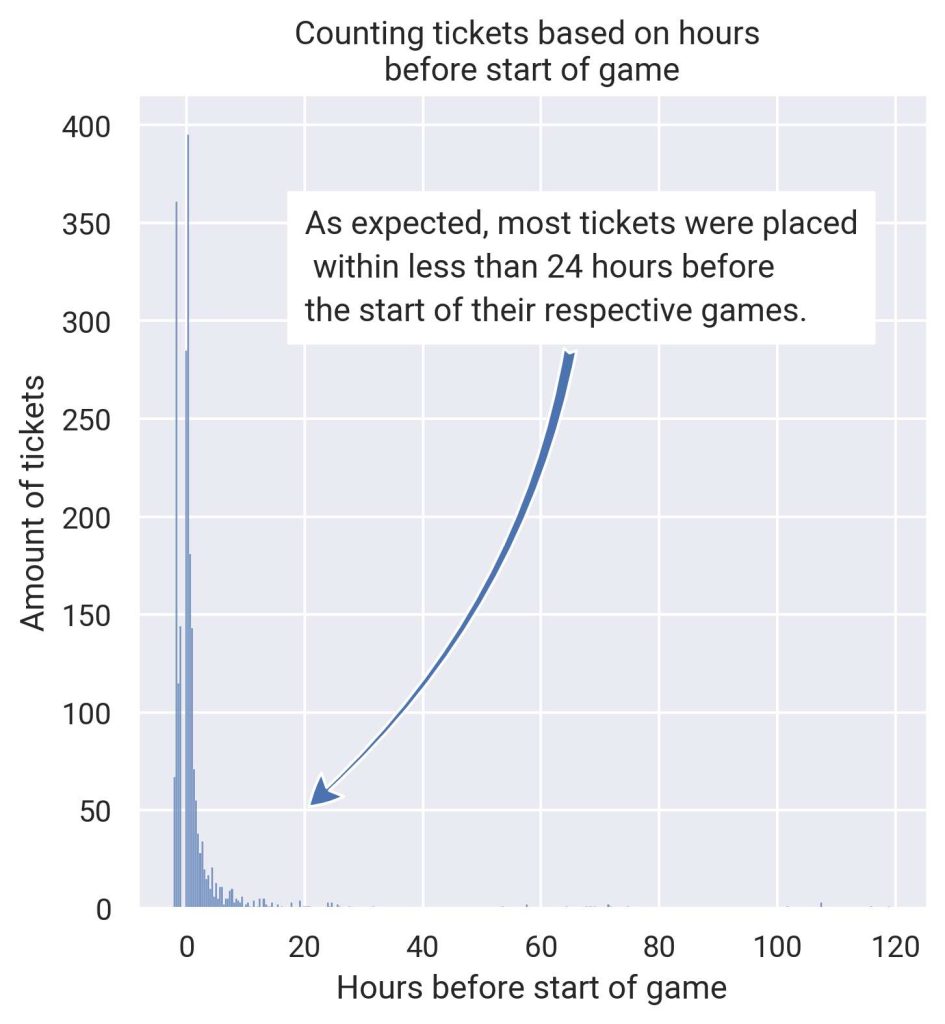
The first thing that stands out is that most tickets are placed closer to kickoff (hour = 0) (notice that the bars close to zero are much higher than the rest).
Let's take a closer look at the tickets placed within 5 hours of the game's kickoff.
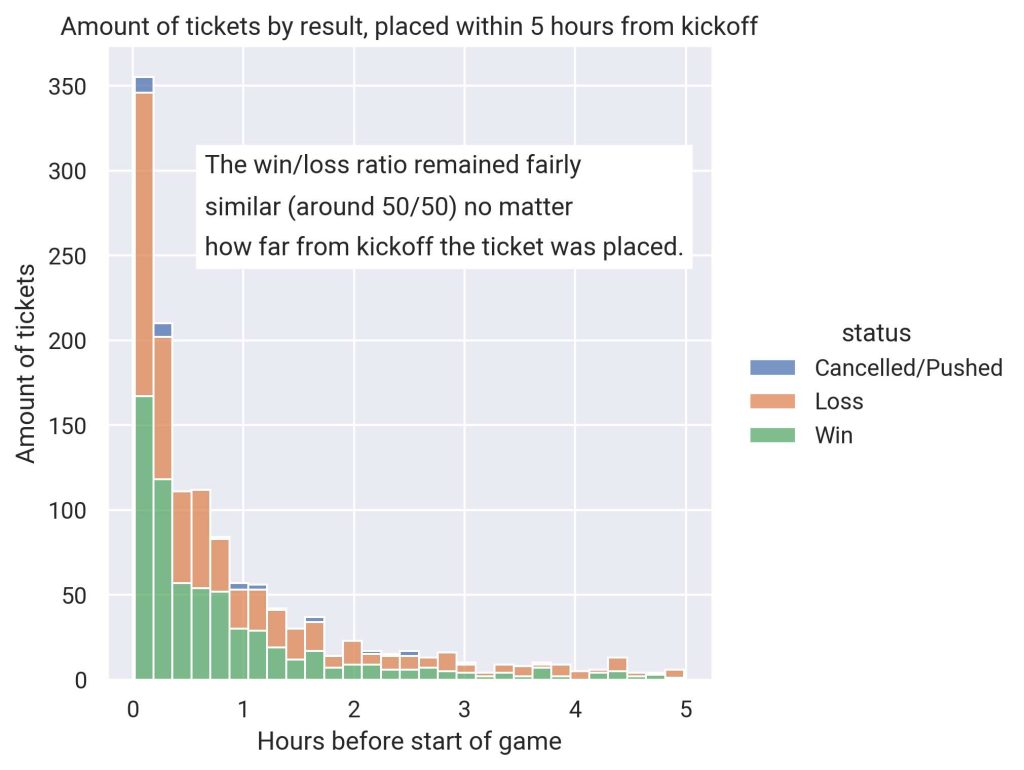
By stacking the tickets based on their status (win, loss, or pushed), we can see that there is no significant standout. In other words, the win/loss ratio remained fairly consistent (around 50/50) regardless of how far in advance the ticket was placed. The green bars (winning tickets) and the orange bars (losing tickets) remain fairly similar in size.
Now, let's examine tickets placed more than 5 hours before kickoff.
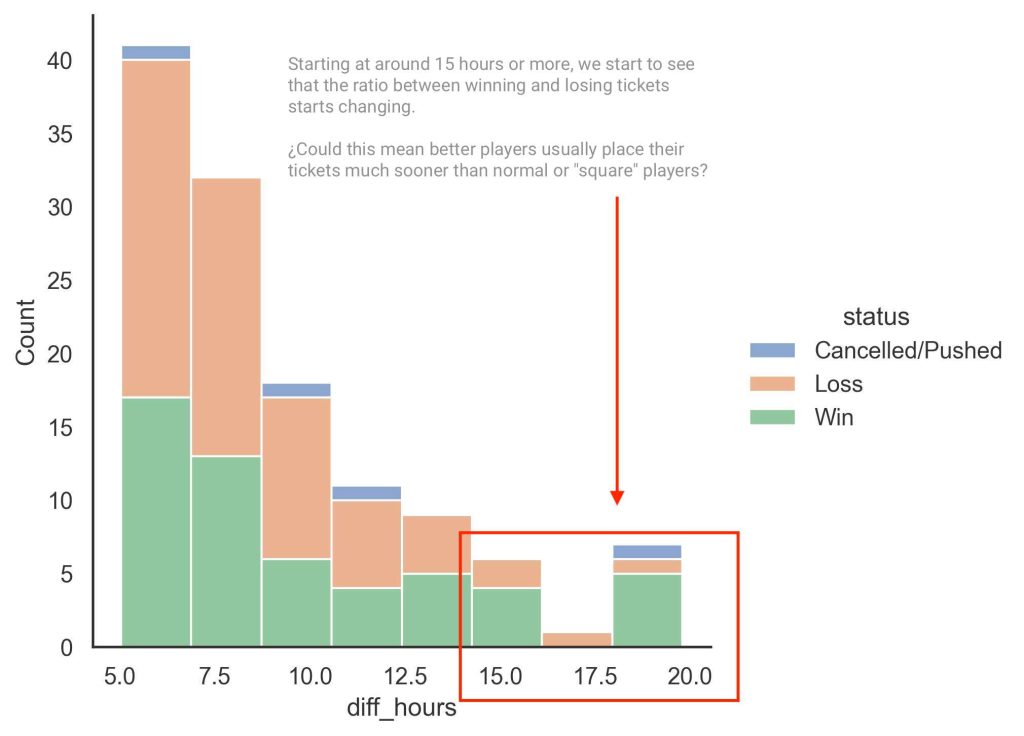
Although the winning ratio is not the sole characteristic that distinguishes a 'sharp' player (bookies should also consider factors such as betting in units consistently, the number of tickets placed in a day or week, etc.), the winning ratio is the ultimate goal these types of players aim for. Local bookies using our payperhead software service have plenty of reports to gauge this, plus our customer service department which can provide custom analytics at request.
Let's now isolate tickets placed more than 15 hours before kickoff and examine the net balance of those tickets.
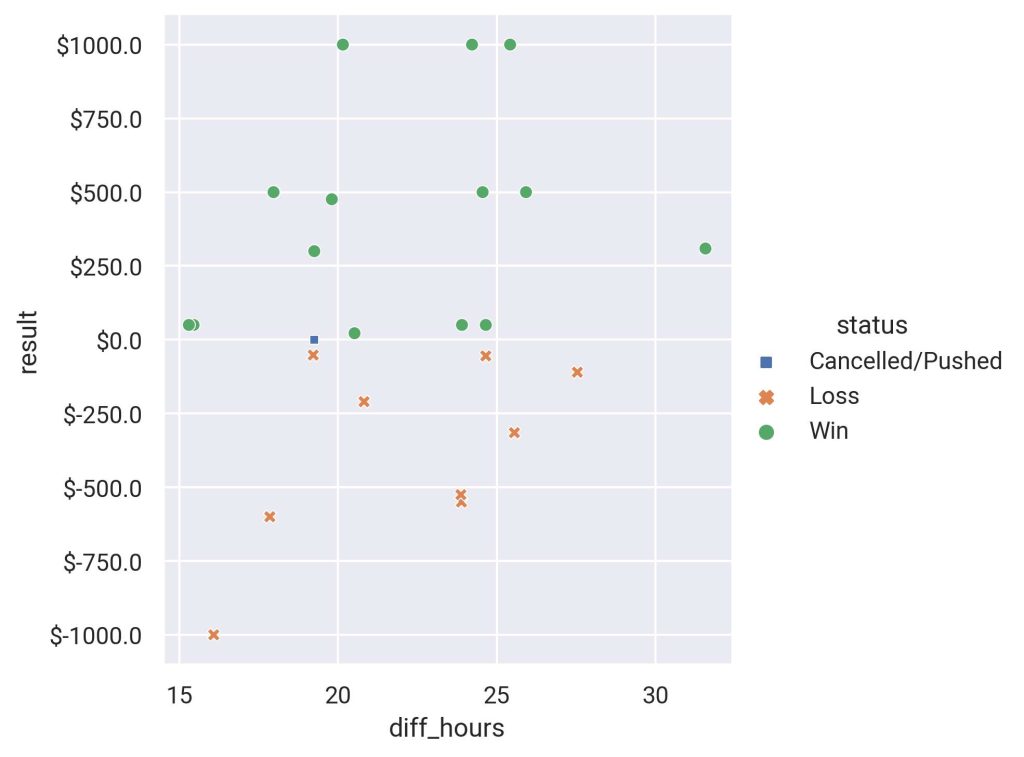
This last graph shows the aggregation of the tickets placed at a given number of hours before kickoff, but this time with emphasis in their net result.
In other words, the net result of all tickets placed, from 15 hours up to 30 hours before kickoff.
All dots below the $0 line ended up with a negative net result.
What does this graph shows?
There is no clear correlation (at least for this sample data) between how many hours before kickoff the ticket was placed and whether the ticket translated into a win or loss.
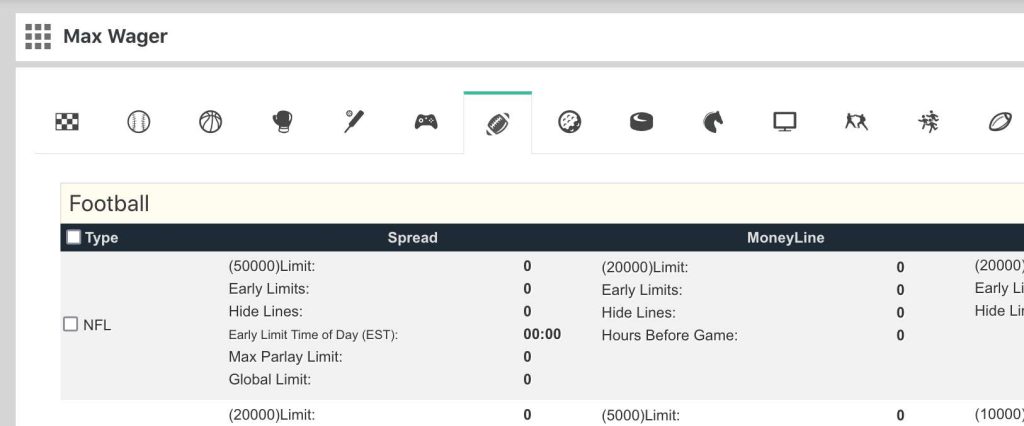
While the preceding data might not indicate that early lines have paid out more to bettors than those placed closer to kickoff, it doesn't necessarily negate the possibility that early lines could represent a potential vulnerability for your local sportsbook.
By utilizing our payperhead bookie software, you gain access to a variety of tools to precisely determine what to offer and when to offer it. Our pay-per-head sportsbook provides robust options for controlling the availability of lines, allowing you to specify how early they are accessible or even apply different limits up until a specified number of hours before kickoff.
In the "max wager" screen, there are two options we will discuss here:
This option enables you to hide the line until a specific number of hours before kickoff. Your players will be able to view the game entry, but the odds will remain hidden and inaccessible.
For instance, you might decide not to offer 1st-half moneylines until 4 hours before kickoff.
Setting a 4-hour time threshold for 1st-half NFL moneylines would appear as follows using the payperhead bookie software's backend:

The following image shows how your players will see the line offerings once the 1st half NFL moneylines have been hidden.
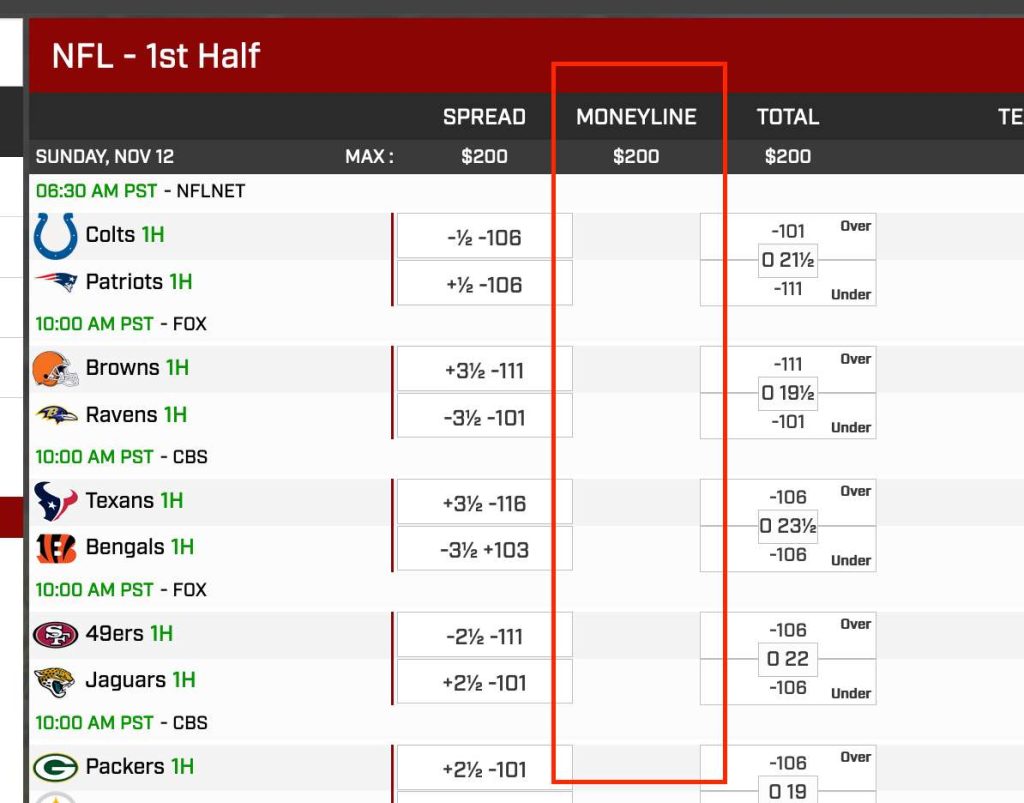
Setting a lower limit than the general max wager limit is yet another option local bookies using our payperhead sportsbook software can use to decrease their book's exposure.
For example, if one of your players has a max wager limit of $200, you could decide to set an early lines limit of $100. This way, the player will be able to bet up to $100 until the "Early Limit Time of Day" is reached.
Early lines limits are just one of the multiple custom settings that only our Payperhead sportsbook offers to local bookies. We are the most feature-rich payperhead sportsbook out there, but our customer service is what differentiate us among the competitors with similar software offerings.
At PPHSportsbook.net, we analyze your player base and suggest adjustments to help you improve your sportsbook's profit margins.
If you made it all the way to the end of this article, we suggest two paths of action:
In the NBA betting scene, the pros know that having the right strategies can be the game-changer between making bank and losing it all. We have compiled a list of NBA sports betting systems that have proven to be commonly used by serious sports betting players. However, using such NBA betting strategies doesn't guarantee profit without a careful study of the game.
On the other side of the equation, local bookies using our pay-per-head software can take advantage of the plethora of tools at their disposal to either allow or disallow different combinations on which these sports betting systems rely. Keep reading this article to explore all the options available.
The first NBA sports betting strategy we will cover is known as "The First Hop System." We got to give credit to Kevin , from the Kev's Picks youtube channel.
This betting system focuses on road favorites who recently faced a loss. The initial idea was to bet on these favorites during the first half of the game. Unfortunately, it didn't quite hit the jackpot, only managing a 49% success rate and falling short of being profitable.
Then a brilliant tweak was done to the basketball betting system. Instead of merely choosing road favorites after a regular loss, the system was narrowed down to those who experienced a blowout loss. And guess what? The results skyrocketed! The NBA betting system's success rate jumped up to a jaw-dropping 56.3%, and the return on investment (ROI) shot up to an impressive 9.1%. Now we're talking!
Players looking for a promising NBA sports betting strategy keep their eyes on those road favorites who've suffered defeats of fifteen points or more during the first half. This could be an opportunity to some seriously compelling and potentially lucrative bets for them.
When it comes to your payperhead sportsbook and limiting certain games, even though there is currently no way to restrict a game based on those two criteria (Road favorite + Recently faced a loss), there are a few ways to change the limit on a given sports betting game matchup.
Navigate to the "Game Admin" screen, where you will find a display showing all current and upcoming matchups. While this sportsbook screen is primarily designed to adjust the betting lines your sportsbook currently offers, it also allows you to set custom betting limits on specific games.
Click on the "circle" label. The "Circle Game Limits" screen will appear, allowing you to set a different limit for the selected game matchup.
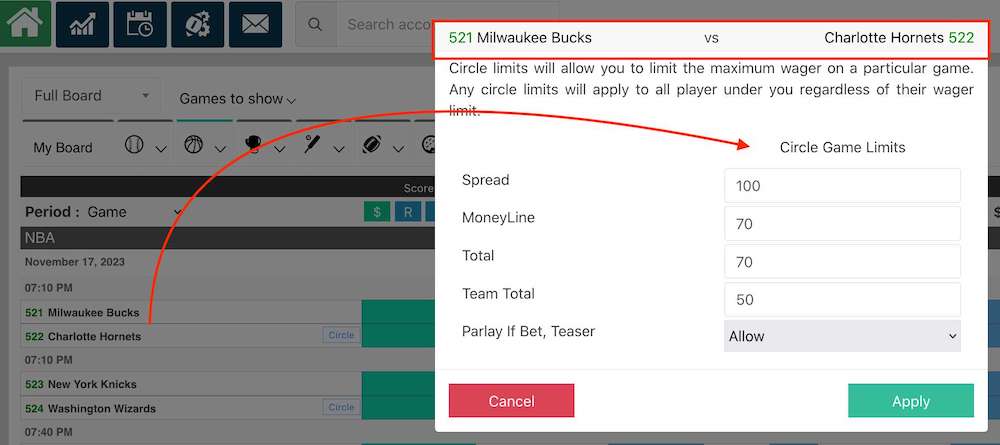
The second of these NBA betting strategies focuses on betting on home underdogs of 10 points or more. At first glance, this basketball betting strategy showed a 51.8% success rate and a modest 0.8% ROI, hardly enough to make it profitable.
However, as Kevin explains, by introducing a crucial tweak and filtering teams receiving 30% or fewer of the public's action, the system's success rate dramatically improved to 56.5%, accompanied by a substantial 10.54% ROI. This emphasized the potential profitability of double-digit home underdogs when they receive little support from the betting public.
When dealing with heavy underdogs or favorite lines using our payperhead sportsbook software, you have the option to automatically set the system to hide moneylines that exceed a specified threshold.
For instance, if you prefer not to offer the moneyline for the Coastal Carolina vs. Furman game due to Furman being a heavy favorite (resulting in Carolina being a significant underdog by more than 10 points), you can adjust the settings. Although our default practice is to typically not offer moneylines for heavy favorites (with a threshold set at 12 points and above), in this case, you can remove the line by applying the following setup:

When working from the payperhead sportsbook backend, follow these steps to navigate to the "vig setup screen" and remove the moneyline for the Coastal Carolina vs. Furman game in the NCAA Basketball league:
By applying this setup, you effectively eliminate moneylines for games where the favorite's line is higher than -699.

With the applied adjustment of entering -699 in the "vig setup screen" for the NCAA Basketball league, players will no longer see the moneyline for the Coastal Carolina vs. Furman game or any other game where the moneyline exceeds 699. This modification ensures that lines with moneylines higher than -699 are removed from the view for the specified games.

Another of these basketball betting strategies consists in placing wagers on the home underdogs who have enjoyed at least one day off between games.
When these underdogs faced a team playing on the second leg of a back-to-back, the nba betting system's success rate was 49.4%, making it not profitable.
Despite this, the idea still holds merit when it incorporates factors that could potentially influence the outcome of a game. With further research and adjustments, this basketball betting system might show new opportunities for bettors seeking an edge:
Imagine an NBA matchup between the Chicago Bulls and the Brooklyn Nets. The Bulls, known as the underdogs, were coming off a well-deserved one-day rest, giving them an advantage in terms of rest and preparation.
On the other hand, the Brooklyn Nets were in a more challenging situation. They had just played a tough game the previous night, leaving them fatigued for this back-to-back encounter.
Taking these additional factors into account, the hit ratio of the betting strategy climbs over the 50% threshold, making it a profitable strategy for serious sports bettors.
How can local bookies using a pay-per-head sportsbook software cope with this?
We have already shown the "circled" limits screen, which can be applied to specific games. However, as anyone with even the slightest experience in sports betting knows, the second-most common way to place bets, outside straight bets, is through parlay tickets. Let's see how our pay-per-head sportsbook platform allows local bookies to limit the underdogs allowed on parlays:
First, navigate to the "customer admin" screen, click on the player for whom you want to limit the account, and then click the options menu (the nine squares in the top-right corner).
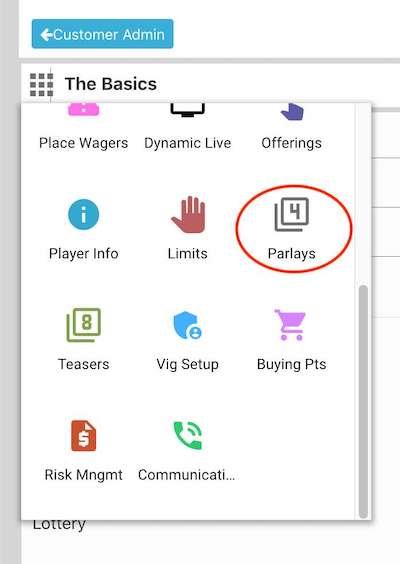
The first option allows you to set the maximum number of underdogs allowed on any parlay size:
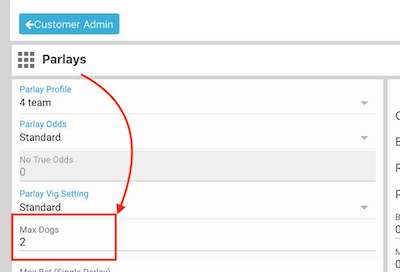
The second option allows you to be more precise on the number of underdogs you decide to allow on your parlays. These can be chosen by size:
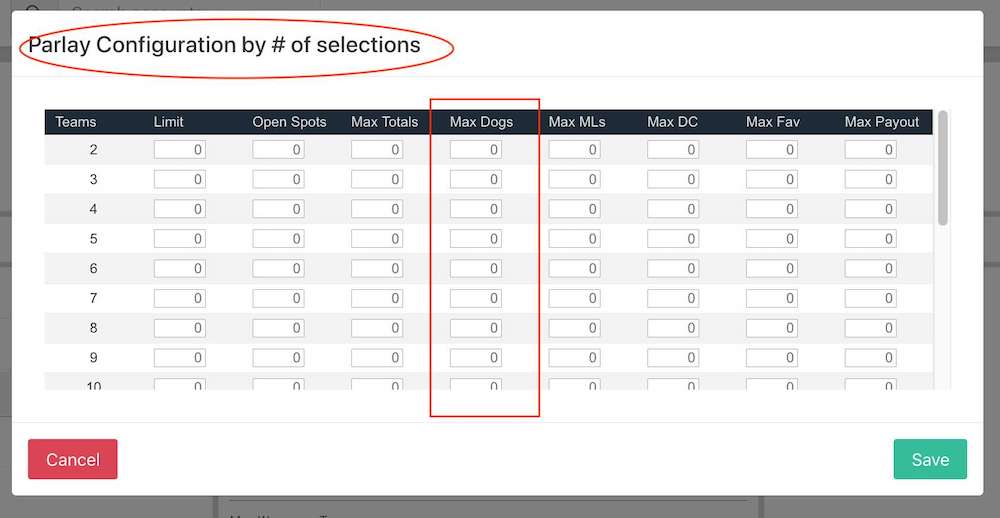
The fourth basketball betting system involves an over-under play that examines two teams playing their third game within five days. Initially, this basketball betting system had a 49.3% success rate, making it non-profitable. However, by recognizing that fatigued teams might play less defense and focusing on the over, this basketball over under system's success rate significantly increased to an impressive 58.8%, boasting a 14.2% ROI.
This basketball over under system over under system is all about understanding team fatigue and how it can mess with the scoring game. Smart bettors can spot these situations and cash in on the action. Betting on the over when teams are exhausted can totally pay off, 'cause let's be real, tired players might not keep up that strong defense.
Remember, successful sports betting involves staying informed about team dynamics and recognizing patterns that can lead to profitable bets. The "Third Game in Five Days Over-Under Play" system is a valuable reminder that in the NBA, fatigue can play a significant role in shaping the outcome of games and betting opportunities. So, keep an eye on those tired teams and their potential to light up the scoreboard!
Looking at this NBA betting strategy from the local bookie's eye, there are at least a couple of ways to limit the amount taken on the totals bet type.
If you want to apply the wager limit on a specific game, use the aforementioned "Game Admin" screen. Simply set the new wager limit on the "total" field and leave the rest empty. Optionally, decide if you want to allow the selected game to be included as part of a parlay.
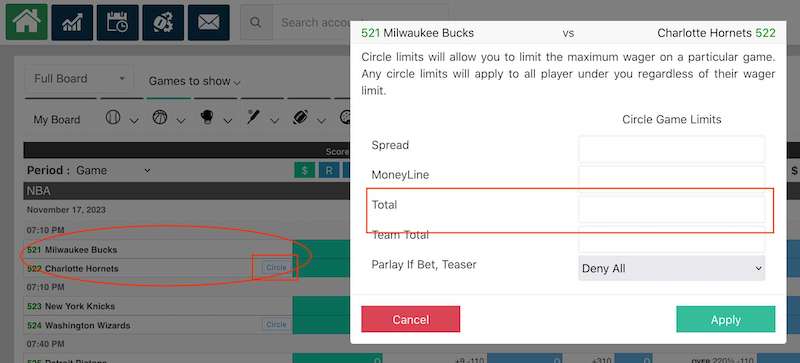
Yet another way local bookies using our payperhead sportsbook service can limit totals is by using the "early limits" feature, and setting the hours to zero.
To access this feature click the "Customer Admin" screen, navigate the player for which you want to apply the wager limit, and then to the "Risk management" screen.
at this moment the only way to apply this setting in bulk (to all of your players) is through our backend. Simply contact us and we will apply the limit for you.

The next among these nba betting strategies centers on road underdogs of 10 points or more in conference games, particularly those not receiving strong support from the betting public (less than 35% of bets). This basketball betting strategy exhibited a noteworthy 58.5% success rate and an 8.1% ROI, making it a strong contender for a winning among these nba basketball betting strategies. While this system may not frequently present opportunities, it offers a potential goldmine when suitable conditions align.
Imagine an NBA match between the Los Angeles Lakers and the Memphis Grizzlies. The Lakers, being the favorites, were expected to dominate with a 10-point advantage. However, the betting public seemed to be leaning heavily towards the Lakers, with only 30% of bets placed on the underdog Grizzlies.
The odds were stacked against the Grizzlies, but this was precisely the kind of situation that the "Road Underdogs"nba betting strategy targets. While the public might have been skeptical, savvy bettors recognized an opportunity.
The game kicked off with both teams fiercely competing. Surprisingly, the Grizzlies displayed exceptional performance and kept pace with the Lakers throughout the first half. By halftime, the Lakers held a narrow lead of 56-53, falling short of their expected 10-point advantage.
As the game progressed, the Lakers struggled to widen the gap, and the Grizzlies continued to put up a remarkable fight. By the final buzzer, the Grizzlies managed to secure a stunning upset victory, defeating the Lakers with a score of 113-110.
Bettors who followed the "Road Underdogs" previously listed among these nba betting strategies and wagered on the Memphis Grizzlies cashed in big time. Not only did they enjoy the thrill of cheering for the underdog, but they also reaped substantial profits. With a success rate of 58.5% and an impressive 8.1% ROI, this nba betting system proved its worth yet again.
While this basketball betting system may not present opportunities as frequently as some other strategies, it shines brightly when suitable conditions align. It's essential for sports bettors to keep an eye on conference games where road underdogs are facing a 10-point deficit or more, and public support for the underdog is relatively low.
The High Totals System it's the brainchild of Allen Moody, a sports-betting pro who wrote the books "Becoming a Winning Gambler" and "Sports Betting Basics." This basketball betting strategy is as easy as pie to learn and use, so no sweat!
Here's the deal: Moody noticed something pretty cool. Sportsbooks have this tendency to lowball game totals for NBA non-conference matchups. So, he came up with a nifty plan—every time there's an over/under of 220 total points, he goes for the over, no questions asked. Simple, right? And guess what? It's been paying off like crazy! He was right on the money a whopping 63.5% of the time for all those games from 2004 to 2009.
Now, I know you're wondering if that kind of deal is still going strong today. Well, you're in luck! Back in the day, high-scoring games were rare, but things have changed. Teams these days are all about that fast pace and three-pointers galore. The average NBA score per game in 2004 was 97.2 points. Fast forward to 2009, it bumped up to 100.0, and in 2016, it hit a whopping 105.6! Crazy, right?
Sure, sportsbooks have caught on to this trend, but don't lose hope just yet! There's still some serious value to be snatched by betting the over in games with sky-high total-point projections. So, keep your eyes peeled for those opportunities and let's ride the wave to some big wins!
This slick nba betting system works wonders because different sportsbooks often offer different game totals with the same odds on the spread.
Picture this: The player got the Hawks vs. Rockets game, right? One sportsbook sets the total at 216 points, while another goes with 213 points. Both have the Rockets as nine-point favorites.
Now, here's where the magic happens. With the Tunnel NBA Betting System, you place two bets—one at each sportsbook. You go for the over (213) at one place and the under (216) at the other. Sneaky, huh? If the combined final score lands between 214 and 215, the bettor hits the jackpot and win both bets! But even if it falls outside that "tunnel," the bettor still scores a win on one of his bets.
Gotta be real though, winning just one of the two bets might leave him with a tiny net loss. We're usually dealing with -110 odds on both wagers. So, to really cash in with this NBA basketball betting system, he gotta snag that double win around 10% of the time. But hey, no sweat! Since the "tunnel" is the most likely outcome, there's some serious potential for profit here.
Now, here comes the homework part: the player needs to do some digging. He might spot small differences in NBA betting sites, but rarely more than two points. But hey, if he comes across one, don't hesitate for a second!
Alright, here's the lowdown on "Betting Against the Public." It's all about going against the flow and fading the public opinion. When loads of money start pouring in on one side of the line, those crafty sportsbooks adjust the line to balance things out. And guess what? This creates golden opportunities for serious bettors to grab some sweet improved lines that work in their favor.
So, picture this: If everyone and their grandma are all gung-ho about Team A, the player would do the opposite if he wants to fade the public. Going against the public can be a real game-changer, and just by embracing this instinct, the bettor would be sniffing out those juicy inflated lines left and right.
Now, we gotta drop a tip on this— bettors should not go overboard with it. Sure, it's awesome to have the guts and skill to go the other way when it's the right move, but they gotta be smart about it and check if it's truly the right play to apply this tecnique among the other nba betting strategies.
See, it's not just about finding where the public's money is and taking the opposite side. Nah, they gotta be a bit more clever than that. Combine their against-the-grain plays with some other factors. Look out for inflated lines and keep an eye on scheduling trends. They would be leveling up their betting game right here!
So, remember, it's time to be the betting maverick and go against the crowd when it makes sense. But always do it with a touch of strategy and extra know-how.
Let's talk about avoiding those heartbreaking losses. The ones where the team's star player suddenly sits out, and the bettor is left feeling like a total chump for not seeing it coming? Yeah, we've all been there, and it stings big time!
But guess what? There's a super easy way to save yourself from that misery—stay on top of those injury updates! Seriously, it's like having a secret weapon to boost the betting game.
These days, load management is all the rage, and players sitting out is becoming more common than ever. And let me tell you, it's like a black hole for the player's bankroll. So this NBA betting strategy is all about staying up-to-date with all the latest news before placing your bets.
But it's not just about who's in or out of the game. Gotta know the nitty-gritty details about injuries and minute restrictions. Those things can totally mess with a player's performance, and you don't wanna get caught off guard. This factor is the most important when it comes to this strategy among the other nba betting strategies.
Now, here's the kicker—often, injury news pops up real close to game time. Like, sometimes just minutes before tip-off! So, for this basketball betting system to work, players gotta be quick on their toes and keep their ears to the ground till the very last minute. And hey, here's an additional pro tip: try to place the bets as close to tip-off as possible. That way, you're making decisions based on the freshest info.
You know what sets the sharks apart from the fish in the betting world? Being on top of the facts! When news breaks, the sharks pounce on the opportunity before the books even adjust the lines. But the fish? They either miss out or get eaten alive.
This is another reason why choosing a serious and capable payperhead sportsbook service provider is crucial. At PPHSportsbook.net, we have an in-house team of lines managers who carefully monitor every game for injuries or any other factor that may cause a shift in the betting line. Additionally, we follow various other sportsbooks, so when they adjust their lines, we notice it and internally decide whether the line should be altered on our end.
As a local bookie using our pay-per-head bookie service, rest assured that you are offering the sharpest lines to your players.
Alright, let's dive into a little something called "line shading." It's a sneaky move that bookmakers pull when they expect a ton of betting action on one side of a matchup. You know how it goes—when everyone's talking about a hot team like the Boston Celtics, the public starts jumping on the bandwagon.
Next the other NBA betting strategies, this one is all about the sportsbook lines. To balance things out and not get overwhelmed with one-sided bets, the sportsbooks slyly adjust the opening line in favor of that popular team. So, let's say the Celtics were supposed to be a (-9) favorite, they might end up being listed at (-11) instead. Tricky, right?
But here's the secret sauce for smart bettors when it comes to this basketball betting strategy. When they see those shaded lines, it's time to make a move and go against the flow. Betting on the underdog with those extra points (+11) can be a real value play. See, both the books and the experienced bettors know that the line has been swung to make it harder for the Celtics to cover the spread.
But, hold up! There's a catch with these kinds of opportunities. They're based on short-term perceptions, so you can't plan for 'em ahead of time. Nope, the only way to sniff them out is to stay in the loop with all the NBA news and events.
It's like playing detective, you know? We gotta figure out if the book is trying to steer us toward or away from a certain side. And guess what? Staying informed is the secret weapon! So, for this NBA betting system to work players need to keep their eyes peeled, stay sharp, and let's find those shaded lines to bag some sweet wins!
Navigating the world of NBA betting can be a challenging yet rewarding endeavor. By analyzing and implementing well-constructed NBA basketball betting systems, bettors can enhance their chances of success and achieve profitable outcomes. Each of the NBA betting strategies explored in this article offers valuable insights into the dynamics of NBA betting and serves as a solid foundation for building comprehensive basketball betting strategies.
On the other side of the coin, local bookies using our payperhead sportsbook solution can take advantage of the settings, limits, and other tools to reduce their sportsbook's exposure and management bankroll efficiently.
As with any form of betting, responsible gambling practices should always be followed, and a combination of research, analysis, and understanding of the sport will pave the way to becoming a successful NBA bettor or a profitable local sports bookie.
Get ready to dive into the thrilling world of sports betting and take your experience to the next level! Don't miss out on the action; our exclusive pay per head sportsbook review guide is here to empower you with the knowledge you need. We've meticulously compared and analyzed the top providers in the industry, so you can make an informed decision and choose the perfect fit for your sportsbook pay per head software needs. From user-friendly interfaces to cutting-edge features and competitive pricing, our comprehensive review covers it all. Whether you're a seasoned sports bettor looking to enhance your game or a entrepreneur seeking to venture into the pay-per-head sportsbook business, our guide is your one-stop resource for unlocking the best opportunities.
An If Bet appeals to the more conservative, low bankroll player.
This article will explain how do if bets work and provide detail on the different types of If Bets (ifi win bets, if action bets, reverse if action bets) available to players, whilst providing first-hand insight into the rules and strategies commonly used. We will also mention the settings available to local agents which are using PPHSportsbook.net’s pay per head sportsbook to manager their player sheet and how they can use them to control their if bets action.
(If you are new to the pay-per-head sportsbook industry, we encourage you to explore our comprehensive pay per head sportsbook review article on the top pay-per-head providers. This article meticulously compares the key features offered by the best price per head providers in the industry. It includes informative visuals, head-to-head comparisons, and detailed explanations highlighting the unique attributes that set these providers apart. By delving into the diverse reports each provider offers and gaining insight into your player base, this resource will impart valuable knowledge about the pay-per-head bookie industry itself.)
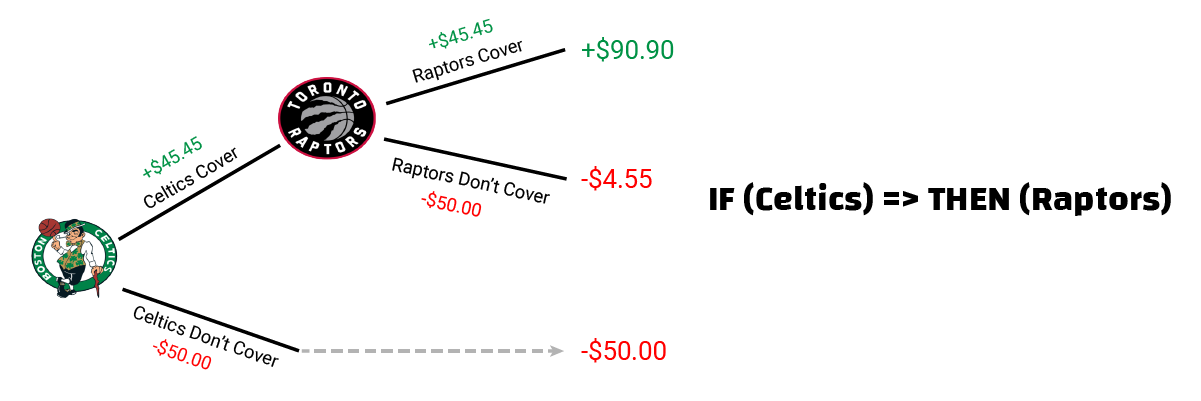 To the beginner player, if win only bets can appear quite complicated, but they are simple. One key difference between an "if bet" compared to multiple straight bets is how the stake is applied to the different selections and the conditions in which these apply. Some players using nba sports betting strategies are particular keen in placing bets of this type.
To the beginner player, if win only bets can appear quite complicated, but they are simple. One key difference between an "if bet" compared to multiple straight bets is how the stake is applied to the different selections and the conditions in which these apply. Some players using nba sports betting strategies are particular keen in placing bets of this type.
Let’s answer the question "what is an if bet?.” An If Bet is one stake bet on multiple selections, with the result of the first bet determining whether or not the subsequent bets are placed.
For example, imagine there are two games that catch your interest. Buccaneers vs Chiefs and Eagles vs Rams. You decide to take the lines of Tampa Bay -5 -110 and Eagles +1.5 -110.
You lay $110 to win $100 on the Tampa Bay Buccaneers on the first leg of your if win only bet. If your first pick is a win, then the second pick (Eagles +1.5) is automatically played at the corresponding vig. So that would be Eagles risking $110 to win $100.
If your second leg (the Eagles ticket) wins, then you profit $200 ($100 for each of the legs of the if win only bet). If the Eagles don’t cover the spread you end up losing $10.
The math for this as the following:
| First "if bet" leg: Buccaneers -5 -110 | Second "if bet" leg: Eagles +1.5 -110 |
|---|---|
| Risk: $110 | Risk: $110 |
| To win: $100 | To win: $100 |
| Ticket wins => Profit = $100 | Tickets losses. Profit = -$110 |
| Payout: (+$100) + (-$110) = -$10 | |
Since the second selection will not happen if the first selection loses, in order to understand how do if bets work is important to keep an eye on the order in which you enter your selections. Because of this the player can choose the ordering of all legs in any type of if bet (if win only bets, if action bets, reverse if bets, etc). The start time of the event does not actually matter though.
If a player has a lot of confidence in a certain pick, they should put that selection first. That way, if it wins, they get a return and with that, the second (or subsequent) picks in the "if bet" will carry on.
If the player was to put the selection they felt less confident in first, and it went on to lose, then the entire bet is deemed a loss.
This logic also applies to If Bets with more than two selections. The more likely events (in the eyes of the player) should be placed in the first selections and get less and less likely as they go on. From a bookmaker’s perspective, it is a good idea to limit the number of selections allowed in a if bet, if win bet, if action bets, or reverse if bets.
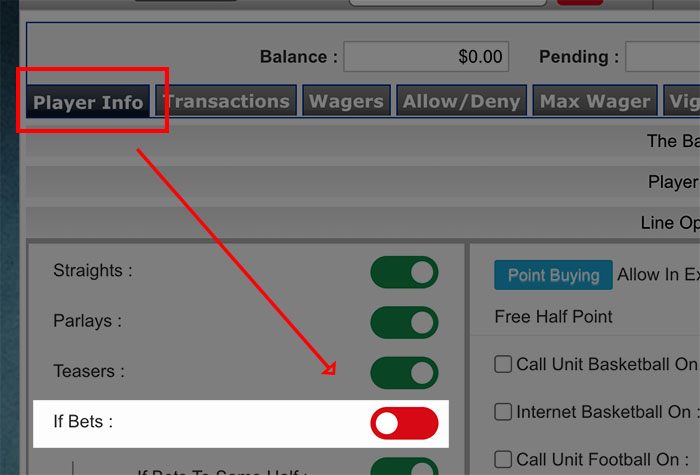
Agents using PPHSportsbook.net's pay per head platform to run their sportsbook business, can disable if-bets altogether if they so choose. Simply select the player for which you want to disable this type of bet and toggle the setting off.
An If Win Only Bet is the simplest type of If Bet and refers to the examples found earlier in the article. The difference here is that subsequent selections within the if win only bet carry on “only” if the first selection “wins”. If the game is a push (postponed, cancelled, tie, etc) the entire “if win only bet” is cancelled and money gets back to the player’s account.
Let’s look at another example:
The player could place a $110 If Win Only Bet on the LA Lakers and the New York Knicks to win their respective games in the NBA. The player chooses the LA Lakers at -5.5 -110 as the first selection, and they go on to win. The New York Knicks are underdogs on the spread at +4.5 (-110) and they go on to lose. The customer has a negative return of -$10 (explained below):
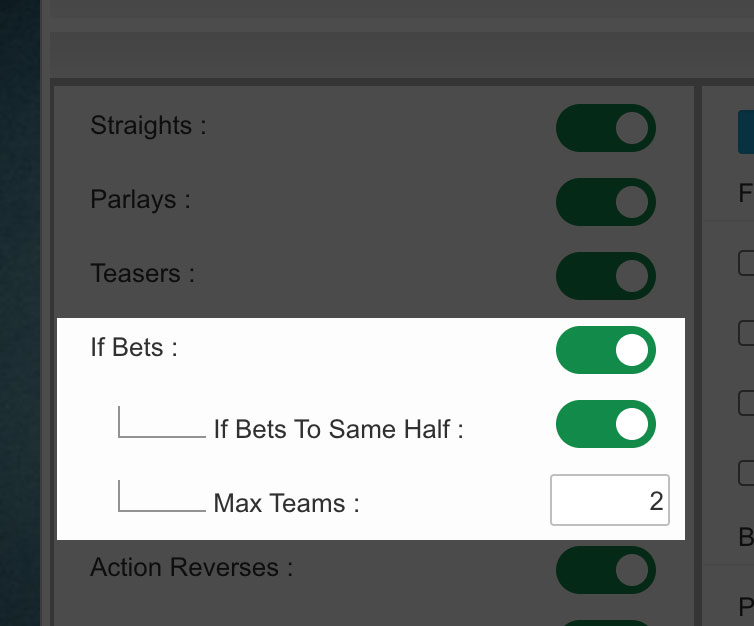
Usually if-bets allow up to 7 teams. You can decide and set the maximum number of teams your players are able to include on an if-bet.
Another variant of an If Bet is an “If action bet”. Whereas in a If Win Only bet the first selection must win, the if action bet allows the second leg of the ticket to take place if the first pick is a tie (push) or considered “no action” (e.g.: game postponed).
The ‘no-action’ outcome does not result in a win or a loss for that selection, the stake simply rolls onto the next selection. For example, the player could choose to place an If Action Bet on the Chicago Bulls to beat the Cleveland Cavaliers (first leg of the if-action bet) and the Detroit Pistons to beat the Indiana Pacers (second leg). If the Bulls vs Cavaliers game is postponed, then the original stake would roll over onto the Pistons/Pacers game. These type of bets are often used combined with 1st quarter bets 3 way bets.
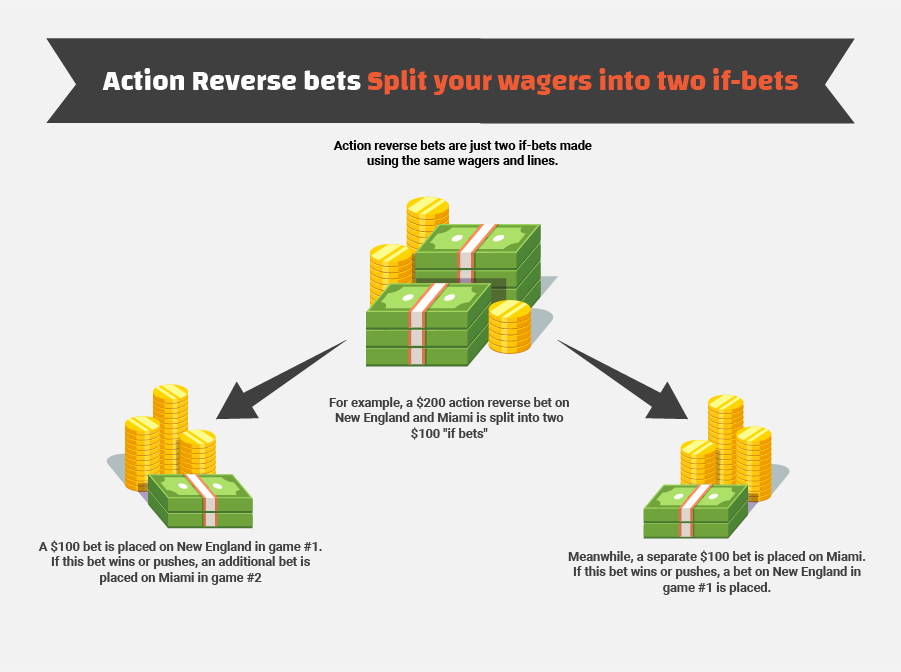
Finally, a Reverse If Bet eliminates the complication of choosing the order of selections by offering a combination of all possible outcomes on a series of selections.
For example, a player places a Reverse If Bet on two NBA teams to win. The first leg will have the Boston Celtics as the first selection, whilst the second leg would have the Toronto Raptors as the first selection.
Double stakes are required (in case of a 2-game reverse-"if bet"), so a $50 Reverse If Bet totals a $100 stake. The player is essentially betting on two "if bet"s. The aim of this is to cover more scenarios. Let’s look at an example to drive the point home:
Let’s consider the possible outcomes for the previous example:
If one selection loses, then only the bet that considers that team the second selection would result in action, IF the other selection wins.
This also means the more selections the player chooses, the more outcomes are available, resulting in multiplied stakes:
| Number of Selections | Number of If Bets |
|---|---|
| 3 | 6 |
| 4 | 12 |
| 5 | 20 |
| 6 | 30 |
There are two important settings available to agents using PPHSportsbook.net’s pay per head sportsbook platform.
The first one allows you to control whether you want to allow or disallow action-reverses with more than 2 selections (usually called “birdcages”).
The second setting you should consider is to limit the number of underdogs to allow. Since underdogs pay more they are considered an added exposure you should consider when running your book using the pay per head sportsbook service.

Enabling action-reverses with more than 2 selections ("birdcages") and choosing the number of underdogs to allow is just a click away
Here are some key rules to understand about If Bets:
“If bets" are ideal for players that want to limit their betting amount and play conservatively or have a small bank-roll to begin with.
This type of bet allows you to place two bets when you only have the money for one.This is great for those players who keep a close eye on their bankroll.
Players should consider that placing two separate straight bets provides a higher profit margin. So if they are confident in their selections it’s advisable to place as many bets as possible. Therefore stay away from the "if bet" and place multiple straight bets instead.
Remember that an "if bet" is not a parlay and as such, it’s payout is much lower.
Finally, it is common that sportsbooks limit the amount of selections allowed in the different types of if bets (if win only bet, action if bet, and reverse if bets). You may want to talk with your local sportsbook agent if you want to increase that limit.
There are a lot of NFL, MLB, and NBA betting strategies out there. Historically, sports betting bookmakers have allowed correlated If Bets to be placed, although this is becoming rarer as they learn more about player behaviour. For example, a NFL team to beat a -10 spread and then Total Points to be over 38.5. The two betting markets are correlated, meaning the second selection is very likely if the team is able to cover the spread. As a sportsbook agent, it’s important to make sure you’re not offering these types of bets on markets that influence each other (correlated selections are, by default, disabled when you start using PPHSportsbook.net as your pay per head sportsbook service).
Understand that "if bets" are used by players to manage their bankroll. That is the biggest advantage they provide. For example, imagine a player has a deposit restriction on his account and wants to place a ticket on both Monday Night Football and today’s (say, Sunday) game. The "if bet" would allow him to place such action on both games using the "if bet" mechanism discussed in the previous paragraphs.
Other than those particular situations, the "if bet" type of bet doesn’t provide much added benefit.
After this explanation on the topic of if bets and how they work you should have a solid understanding of them.
"if bets" are not a commonly used type of bet, but it’s important to understand how and why players use this type of bet and what settings are available for the local sportsbook to limit or completely disable this type of bet.
As you explore the top Pay-Per-Head providers in the market, take a moment to compare the available options and features with our indept pay per head sportsbook reviews article. Uncover how our offering sets itself apart from the rest!
We take pride in offering unmatched options and features, providing you with the flexibility and tools you need to thrive in the sports betting industry. But it's not just about boasting features – we deliver genuine value. From exclusive player insights to an intuitive user interface and exceptional customer support, every aspect of our platform stands out from the competition.
Why choose us? Our comprehensive range of features is designed to cater to your specific needs, offering enhanced flexibility and ease of use. Plus, our dedicated customer support team is always ready to assist you.
Empower your pay per head sports betting business with the right choice. Explore and compare now and see why our Pay-Per-Head solution is the ultimate game-changer!
The US sports betting industry is growing at a rapid rate, following the repeal of PASPA, presenting first-mover opportunities in many different states. With that, operations will become larger and more complicated.

The recent legalization in multiple states makes of sports betting all that more popular.
An online bookie master agents system for sports betting agents allows you to take a step back from day to day player management and customer service, enabling you to focus on topline performance metrics and big-picture tasks for your bookmaking business. By creating a network of sub-agents, you can transfer the sportsbook’s front-line responsibility to them.
PPHSportsbook.net offers numerous Master agent systems and solutions to bookmakers looking to take that next step and expand their business or switch to a new, more reliable and more advanced pay-per-head sportsbook provider. It is a smart way for existing online bookie agents to expand their player network, along with the scale and the scope of their operation.
Our pay per head sportsbook review article allows you to make an informed decision for your sports betting business. We bring you an in-depth comparison of the leading Pay-Per-Head providers in the industry.
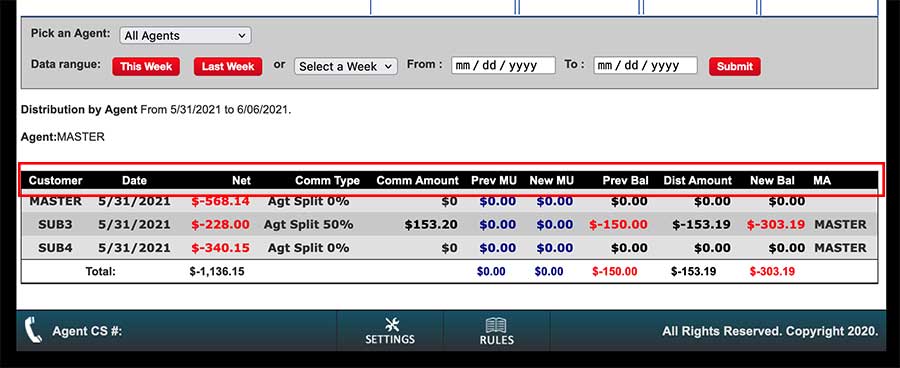
Using the "agent distribution" report, master agents can easily see how much each of their subagents made this week and what their cut is.
An online bookie master agents network is a player referral network, headed up by a sports betting bookmaker (the master agent) who is responsible for several sub-agents. These sportsbook sub-agents are responsible for new player recruitment and day to day care of the player base.
Be aware: developing an online bookie master agents network does not mean all the work is handed over to the sub-agents; there are some new responsibilities that are required for the master agent system to work efficiently.
A key responsibility is managing and paying any commission earned by sub-agents. Timely, correct payments are an incredibly important factor in keeping a satisfied group of sub-agents that are willing to recruit and nurture your customer base.
One of the biggest risks of creating a network of other online bookie agents for the master agent is the responsibility to bankroll the entire network of sub-agents. But don’t worry, there are a wide range of commission structures that you can use to run your online bookie master agents network. That way, you can make sure all commercial agreements (whether red-figure, revenue share or flat fee) are optimised to protect the overall network’s exposure (keep reading to learn more about these systems at your disposal).
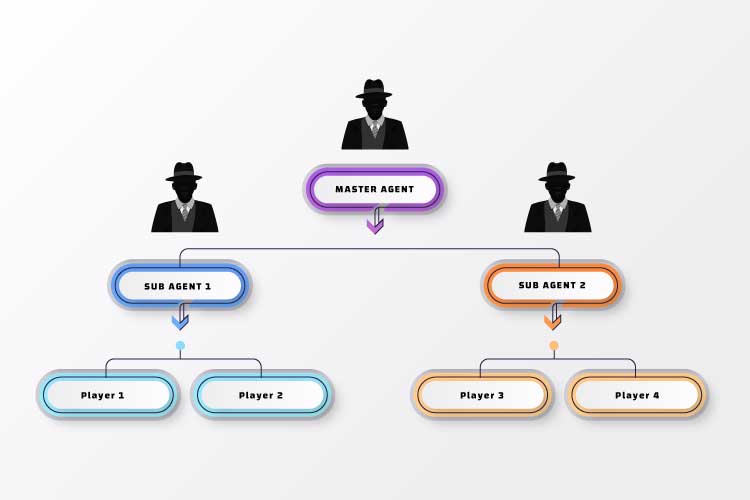
Think of a master agent system as a tree-like structure in which the master agent is at the top and one ore more subagents below him.
There are many advantages to developing a network of sportsbook sub-agents. The primary advantage is that it allows the online bookie master agent to step away from day to day player management and customer service and focus on larger, more strategic tasks. You will have more time to look at your player's activity, spot sharp players. In any growth industry, you need to be able to look upwards and outwards, rather than downwards and inwards.
The signs that you need to start developing your network often become apparent themselves, making it an easy decision to take that next step. Perhaps your player base has grown to the point where you are not able to offer the same level of customer service? That’s very common and often results in players moving to other operators who can offer something more.
Maybe you have recruited too many players to be able to handle the book accurately and effectively? Or conversely, you might just be ready to expand, having taken the business as far as you can without additional resources.
The addition of sports betting sub-agents are the ideal resource to allow you to delegate certain responsibilities and mitigate all of the above issues, enabling you to focus your effort and time into overall profit levels and reducing your exposure, whilst maintaining customer service levels.
Like all networks, a bookmaking agent network relies heavily on trust between the master agent and sub-agent. A common way of finding trusted sub-agents is by looking at your existing customer base. Many players want to subsidise their wagering expenditure by recruiting other players, so reaching out to them is a good place to start. New sub-agents are also more open to starting on lower commission structures, enhancing your bottom-line.
As previously mentioned, the commercial agreements between master-agent and sub-agent can make or break the business. There is a wide range of commonly used commission structures available through PPHSportsbook.net, as seen below:
Agent split means that both you and your subagents are taking risk and that the subagent is in charge of paying and collecting funds. So, if the players win then the subagent will be owed money to pay out the players, if the players lose then the agent will owe money because he will collect from them.
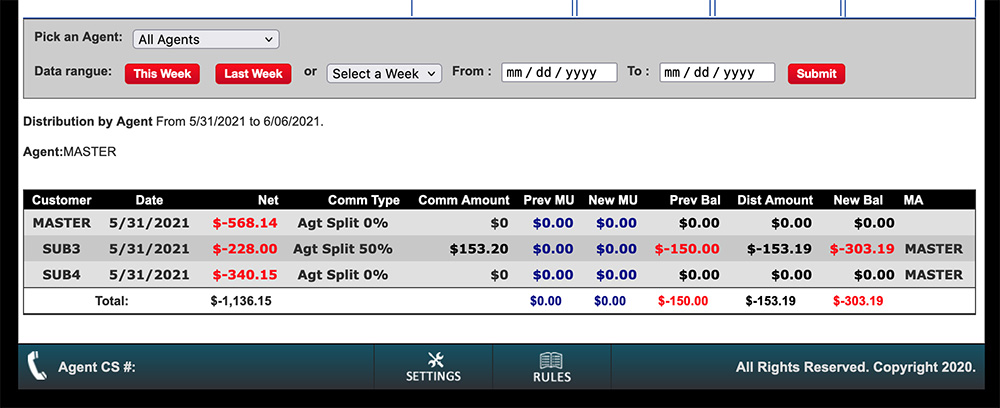
If the master/subagent are working on a 50% agent split commission type, and the players lose $228 on a given week, then 50% of that goes to the subagent and the other 50% to the master.
Red figure means that the subagent is taking no risk if the players lose then he will receive a percentage of the losses and if the players win then he will lose nothing and whoever is backing the sheet (the online bookie master agent) will have to pay the whole amount won. If the players win then there will be a red figure which the players then have to lose in order for the subagent to again start receiving commission.
Again, this is an SUBAGENT red figure meaning that he is in charge of paying and collecting so if the players win, he will receive money to pay them and if they lose then he will owe what is left over after he takes his percentage.
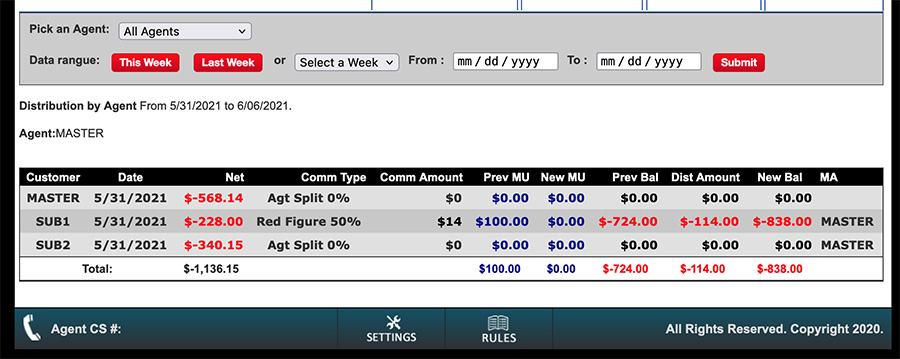
For example, say the subagent sheet did $-228 on a given week (that is, players had a net loss of $228). The previous red figure (the "make up") of $100 is subtracted to the subagent commission ($114), leaving the subagent with a commission of $14 and a New red figure of zero. Meaning he should receive his full commission next week (if the players sheet end up with net losses again).
In weekly profit accounting is similar to Red Figure in that the subagent takes no risk but, in this case, there is no red figure kept. If the players win one week but lose the next the agent will receive his full commission the week they lose. Again, this is an SUBAGENT red figure meaning that he is in charge of paying and collecting so if the players win, he will receive money to pay them and if they lose then he will owe what is left over after he takes his percentage.
Another variation of these methods are that in which the subagent is not in charge of collecting and paying out. He simply refers players to the online bookie master agent and is paid whenever his players end the week in negative. Otherwise the red figure rule is kept and he is paid out only once that figure is covered.
One crucial component of developing an effective network of sports betting subagents is having the correct platform. PPHSportsbook.net offers an industry-leading online bookie master agents system, enabling you to monitor all of your sportsbook sub-agents activity with confidence and ease. The reports available within PPHSportsbook.net offer detailed information for managing your player profiles and limits, recording deposits and payouts, reviewing and setting credit limits and more.
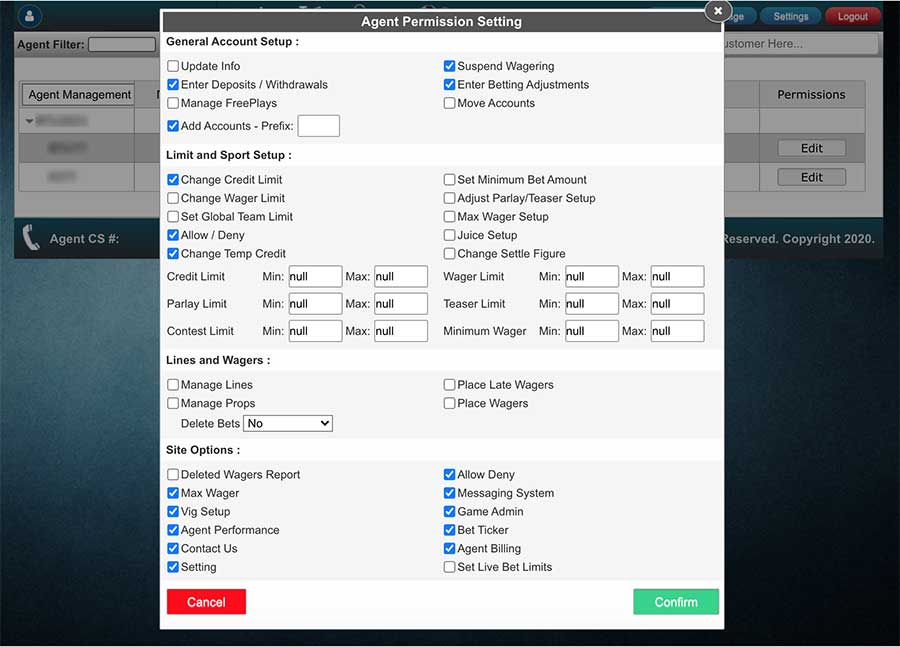
PPHSportbook.net gives you full control on what to allow or disallow your subagents to do or change.
A good starting point is to not give your subagents access to more than they need.
As your network expands, you will have to build trust with more and more sub-agents. As a default, only giving the sub-agent read-only data rights, rather than edit rights, is important to protect all reporting and data from tampering. You can also prevent sub-agents from being able to remove wagers, should you wish to do so. This sort of protection gives you the peace of mind that your figures are accurate and your sportsbook business is performing as it should be.
If you think your business is ready to take the next step and expand into an online bookie master agents system, then speak to PPHSportsbook.net today and schedule a demo with one of the experts.
If you're new to the pay per head sportsbook industry, you should totally check out our "best pay per head providers review" article. We've gone all out to compare the key features offered by the best price per head providers in the business. This article's head-to-head comparisons, and detailed explanations that show off the differences between pay per head providers. Dig into the diverse reports they offer and get the insights into the player base – this resource will give you all the knowledge about the pay-per-head bookie industry you need.
This article will lay out different parlay systems and winning bet ideas sports bettors use to place bets and how local bookies can use the setting offered by the best pay per head bookie software to avoid some of them if they so choose.
As everything in sports betting, the “how to win sports betting parlays” comes down to careful study and patience.
Bookies should find the information helpful since it lays out common winning parlay systems used by their players. This will help make you more informed in the sports betting world and also how to limit or completely avoid some of thes types of parlay betting strategies using the available settings within the software.
Changes are possible but not always recommended. If a player finds themselves too limited or restricted on their parlay, NFL, MLB, or even NBA betting strategies, they may choose to bet elsewhere and thus not place any action with the local bookie anymore. Of course, as a bookie, you need to have a solid bankroll to pay winners, but patience is key. With sports betting, it's expected that over time, most players will end up with a negative balance. Though, if you are dealing with a smart player who is wrecking your bottom line, you will now know which settings you can apply to handle most of this type of parlay strategy.
Keep in mind, our customer service department is available at all times to apply any settings changes for you, if you prefer to have it done for you.
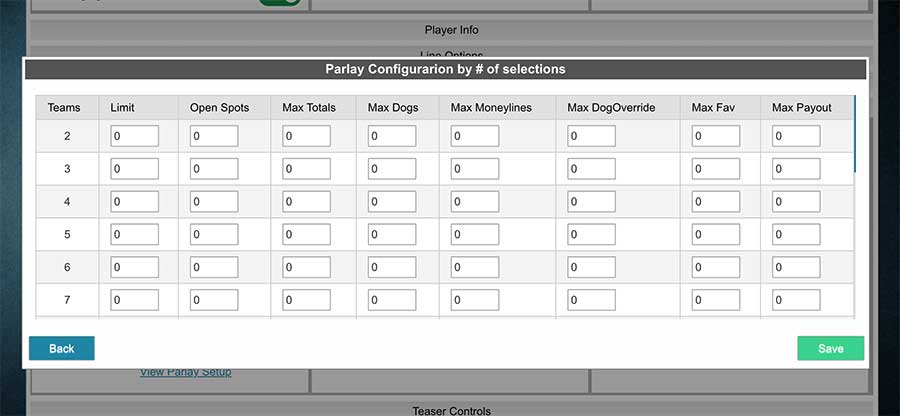
The parlay table configuration table, available to bookies using pphsportsbook.net, is a very versatile tool that allows you to customize your parlay profile by number of selection on almost every aspect (more of this later)
There are many different winning parlay systems smart sports bettors use to get the most out of parlay bets (including football parlay betting strategies). Here we will briefly discuss some of them and also show you how you can offset or completely remove some of them by using the tools provided on your bookie software panel.
Some of the sports betting parlay strategies we will be covering include:
This is one of the most common parlay betting tips we hear often. Just about the worst thing bettors do is hop into a parlay that groups together points spread (handicap) wagers. Sure, this may sound like a great way to bet with favorable odds since three bets ATS (against the spread) equal to about 7-1 odds. Sounds like a great bet? Not exactly.
True odds for this 3 leg parlay are 8-1 since each leg has a 50/50 shot of landing. This is one of the reasons why sportsbooks are always actively promoting points spread parlays.
In regards to this strategy, among all the other parlay betting tips, perhaps the only benefit to the low value of the point spread parlay strategy is if a bettor believes they have found some games where a sportsbook has the handicap wrong. This situation may occur, but for the most part, players know they are dealing with pros, and an undervalue line will rarely happen. In this case, it is better to bet on each individual outcome instead of the parlay.
When using pphsportsbook.net as your pay per head software provider, you can set the maximum number of moneylines and underdogs allowed in parlays by parlay size. (check out our previous article about how parlay betting works, moneyline parlay, true Odds and payouts; as well as different parlay configuration settings you can apply when using the pphsportsbook.net platform)
As you can see on our previous article discussing parlay (linked above), on the “true odds” section, the better the odds, the more a parlay pays out. Not to mention the odds on underdogs are set much higher than on a favorite (see parlay payout calculator here). You can also set a max number or favorites and max totals.
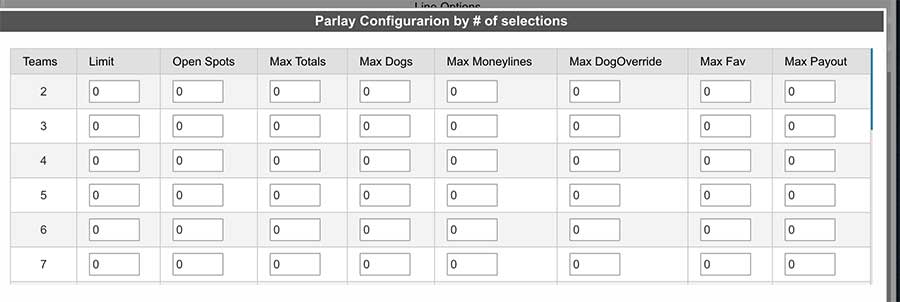
Every aspect about what you want to allow (and disallow) in regards parlays on your sportsbook can be controlled.
Using the parlay configuration table you can control the following:
Another often seen winning parlay system is using when players use sportsbooks rewards and bonuses. Most online sportsbooks offer clients rewards for loyalty, making deposits, regular betting and for betting on promotional markets with bonuses or free bets. The problem for players with this parlay sports betting strategy is that they are only receiving profits from their free bet and nothing from the original stake.
For example, with a $10 free bet, if they wagered on a -110 moneyline favorite and they win, they only get a payout of $9.20. The $10 free bet acts as the original stake and is not returned. Not real exciting is it?
One solution for them is to use their free bets on parlays. By doing this, they can take a shot at a combination of bets that offer final odds that are much more enticing than an uninspiring favorite.
For example, a $10 bet on a parlay offering odds of 9-1 will make their eventual payout $80. This is the outcome of $90 minus the free bet stake of $10, which leaves them with $80.
When using pphsportsbook.net as a payperhead provider, local bookies can limit “free bets” to only be applied on straight bets and not on parlays. This allows you to prevent players from using the free bets strategy above.
This next sports betting parlay strategy and winning bet idea is based on the fact that home field advantage goes a long way in the sports world. Teams with home field advantage play much better when they get to play in front of their families and the supportive home crowd.
Sometimes there are additional factors such as preferred weather situations, stadium layouts, good home cooking and the opportunity to sleep in their own homes all helps motivate athletes to be at their best in front of the home fans. This may lead to that overconfident team of all stars visiting to find themselves in a tough spot.
Those are just some of the reasons why the home underdogs parlay betting strategy (pick and choose responsibly) is worthy of consideration in a parlay. Underdogs carry a powerful odds multiplying effect. Which is what every well-played parlay needs. It is not uncommon for a home underdog to be paying well above 2-1 odds, which essentially doubles the parlay total odds.
This is also a common football parlay betting strategy. Local bookies can restrict this parlay system by denying parlays on a per-game basis. You can select the correct option from within the “game admin” screen (see image below). When using this option, (even though it requires more manual work from the bookie) you can disable certain parlays on games where the underdog is the home team.
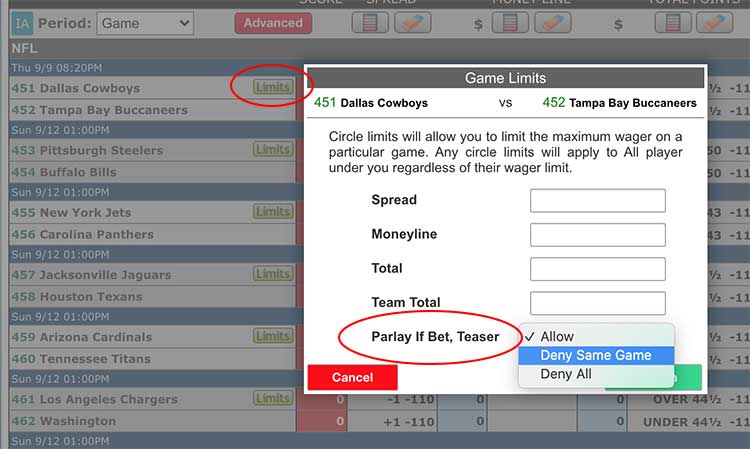
Besides setting special limits for any individual game on its spread, moneyline, total, or team total, bookies can choose to disable parlays whether it be with same game lines (e.g.: one parlay using the game’s spread and team total), or don’t allow any parlays that tries to use the selected game as a parlay pick.
Let’s discuss another example of a 2 team parlay system.
I know it can be tempting to bet on a heavy favorite. Who doesn’t want a quick bet to bank some quick profit? The drawback is that usually the bettor has to wager a larger stake for a significant return. This is not an ideal way for long term success. One bad run of losses and their account balance suffers.
In this case, the 2 team parlay system known as the “favorite parlay double” is helpful. Bettors will find two carefully chosen favorites, package them together into a parlay and let their stake and profit from their first win lead them into the second leg. Their end result is a much smaller stake, but still an excellent return.
As you saw in the table above, bookies can control with precision how many favorites are allowed on a per-parlay-size basis. Using this feature, you can for example, set a max of one favorite for each parlay size entry.
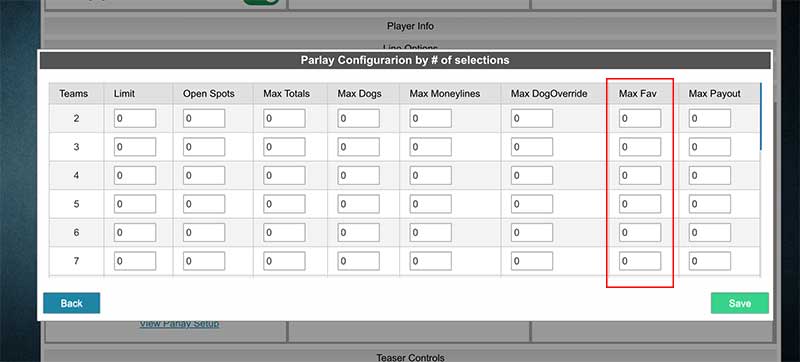
Is possible to limit how many favorites to allow on a per-parlay-team-size.
One powerful winning parlay system is the underdog double. This parlay betting tip falls into the category of a 2 team parlay system. Once they have carefully scanned available markets, they can choose two value underdogs and work them into a double with odds of +400 (Decimal odds 5.00) or better without much trouble. This is a common 2 team parlay system used by players.
Many gamblers have stories of a 4 or 5 leg parlay on strong favorites offering combined odds of about 3 to 1. The first four legs win easily, only to have the last one have “one of those days” and gets beaten by a heavy underdog. Then they are left asking the question, what if I wagered on the underdog?
Oftentimes a double underdog 2 team parlay system represents considerably more value than a bundle of favorites. Major League Baseball and the NBA offer double underdog winners on almost a daily basis.
Bookies can also set a maximum number of underdogs allowed “across the board” (no matter the parlay size, sport, quarter or period, etc) by selecting the option under the “parlay controls” section of their admin panel. (see image below). This is a great way to limit this type of 2 team parlay system.
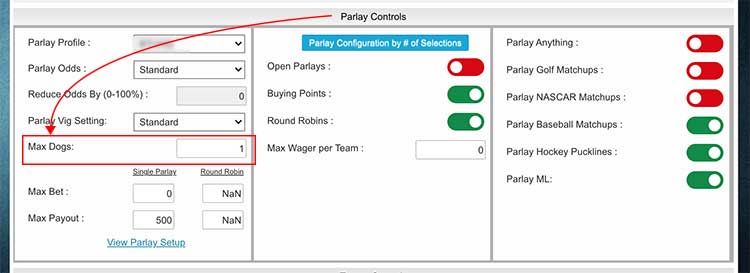
Instead of using the parlay configuration table discussed you can decide to keep it simple and set the maximum number of underdogs “across the board” (disregarding the parlay size).
Sportsbooks are constantly offering great promotions on parlay betting. They know poorly selected parlays are loaded in their favor and they do their best to encourage more betting action on these bets. This parlay sports betting strategy offers a great opportunity for bettors, and it is advised to go after it!
Some classic promotions to look out for:
Previously, we have detailed our other sportsbook promotions and bonuses local bookies can use to get more players onboard via referral from your current player base. You can also use one of these promotions or free plays to help encourage current players to refer new players.
One of the most common types of moneyline parlay strategy and parlay betting tips is the “moneyline favorites”.
This is when bettors make a parlay based strictly off moneyline favorites.
This moneyline parlay strategy is a go-to for many sports bettors. It allows bettors to make predictable results much more profitable than they would be individually.
| 10/15/2011 @ 7:15 PM | CFB | [144] OREGON -550 |
| 10/15/2011 @ 12:30 PM | CFB | [150] WASHINGTON U -600 |
| 10/15/2011 @ 9:00 AM | CFB | [158] CINCINNATI -550 |
The table above shows an example of a typical 3-team parlay relying on heavy favorites.
Bookies can set moneylines on heavy favorites to be automatically removed by the system.

Setting the “max price” to “-600” will cause all moneylines over this set limit to not be shown to your players.
Another common moneyline parlay strategy is the “Favorites + one” technique.
This is possible by stacking a number of moneyline favorites into a parlay and adding an underdog to boost the odds.
This method can turn a usually low-paying parlay into a large payout.
Two main aspects go into a successful “Favorites + one” parlay.
#1 is a solid list of favorites.
These can be heavy favorites, but the picks should stack up to 1/1 odds.
The next key to this moneyline parlay strategy is having a reliable underdog for the “+ one”
This ends up being the most challenging, but also rewarding part, as the underdog odds are what make this moneyline parlay strategy so profitable.
As a bookie, you can use the parlay configuration table to limit the amount of favorites players can choose, per parlay size. For example, to prevent the player from picking too many favorites on a 5-team parlay, he can set this to “3”, which will cause the parlay to not accept more than 3 favorites picked on a 5 teamer.
Hopefully by now you have a greater understanding of common winning parlay systems and the settings you can use to keep your bottom line strong.
See for yourself how our settings can help you control your profits. Request your demo account today to begin testing the tools yourself.
Ready to take your pay per head bookie business to new heights? Look no further! Our top-tier Pay-Per-Head bookie software is here to revolutionize your operations. Enjoy a comprehensive suite of cutting-edge features designed to boost your profits and enhance player satisfaction.
📈 Maximize Profits: Take control of your bookie business like never before. Our software empowers you to set your own lines, manage exposure, and optimize earnings.
📱 Seamless Experience: With an intuitive user interface, our software ensures a smooth and hassle-free experience for both you and your players.
🌟 Expert Support: Our dedicated team is ready to assist you every step of the way, ensuring your success.
Compare our sofware against the best in the pay per head software business with our in-dept pay per head software reviews article.
Just as in real estate, car sales, and so many other industries, referrals is the name of the game in sports betting. If the product that you are selling is a quality one, your customers will tell their friends, and those friends will, in turn, tell more friends about your site. Below you will find some of the best ways to increase your referrals and increase your business.
Not only can referrals increase business, but referrals give you insight on how reliable your customers will be. Since your business is run mostly on credit, having customers settle their debts promptly is key to a successful business. Referred customers are more likely to pay you promptly when they lose wagers. Along those same lines, paying your customers promptly when they win will ensure that they are happy, returning customers who will say good things about your site to their friends. Having a good reputation is the number one way to be successful in bringing in new players.
(If you're just starting out in the pay per head sportsbook industry, start with our in-depth pay per head sportsbook review article on the top pay per head providers. We've gone the extra mile to compare the key features offered by the best price per head providers in the indudstry. This article is packed with informative screenshots, head-to-head comparisons, and detailed explanations that showcase what makes these providers unique. By digging into the diverse reports each provider offers and gaining insights into your player base, this resource will give you a ton of valuable knowledge about the pay per head bookie industry.)
Many of the largest sportsbooks use some sort of bonus system to encourage new players and referrals. No matter the size of the sportsbook, a bonus for new and referral customers is a great way to generate business. This has the effect of encouraging your current players to refer a friend. The great thing about a bonus is that it’s scalable to your business’ size. If you are just starting your sportsbook, start with a small bonus. As you grow, your bonus size can grow with you to attract more players with deeper pockets.
One of the best ways to attract new players is to offer a bonus to existing players who refer a friend to your site. Below you will find some details on how to implement a referral system.
An offer that appeals to many players is a free play. That is free money that you deposit into their account for them to make bets with. When an existing player decides to refer a friend to your site, they get a $50 free play. But there are a few stipulations that need to be met before the free play can be deposited in their account.
These guidelines will ensure that you are only handing out free plays to actual new players and not the same players over and over. You can easily confirm the player doing the referral is not the same as the “new” player by using our IP match tool (see image below.) In this way your “refer a friend” program will be clean and without shady tactics from your players.

Using the “Global IP Matcher” tool, making sure the new player referred is not the same as any of your past or current players is easy.
As a bookie, you need to make sure that when you run a promotion such as the bonuses we will discuss here that both, the current player who wants to refer a friend, and also the new referred player, understand the terms and conditions. You can do this quickly and easily by sending a message to all of your players. To do this, log in as an agent and click on the “Messaging” button. Select “Compose Message” and then on the right hand side dropdown box, select “All Players”.
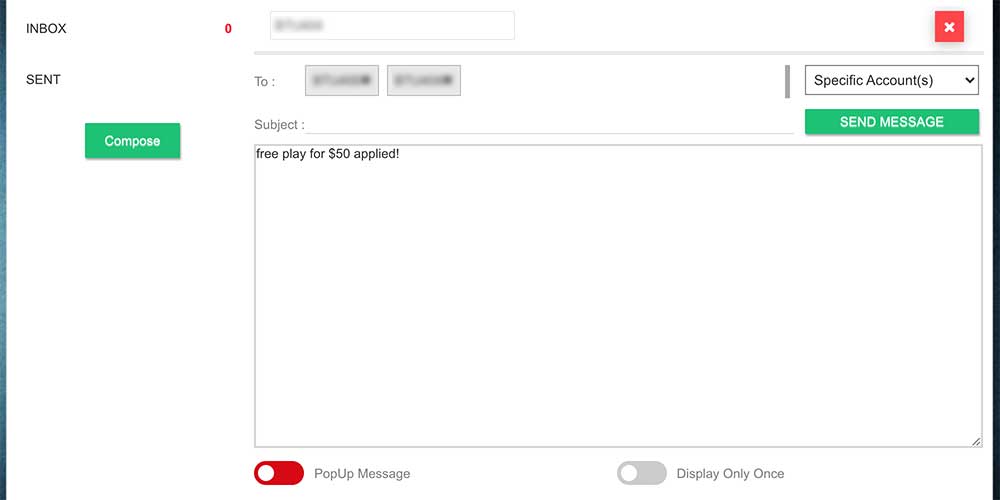
Let your players know about any requirements regarding bonuses or promotions you decide to offer to encourage referrals. Instead of sending a text message or email, you can use the internal messaging system. All traffic goes through private servers so is 100% secure and on top of that there is a written, private record so you players cannot complain of not having seen the rules.
A great bonus that can draw players to your site is a risk-free bet. This will encourage riskfree betting and in turn, bring more action to your book from new players. So riskfree betting (also called “free money betting”) is usually a bonus given to new players after they register. It allows them to place a bet (only their first bet) without fear of losing money. This answers the question “what is a free bet?”.
How it works is simple. Once a new player places their first bet, if the bet loses, the players account is credited with the amount lost, erasing their loss. But, if the players first bet is a winning bet, the risk-free bonus or free money betting is gone and cannot be redeemed later. Generally, when considering what is a free bet, you should consider risk-free bets have some limitations applied by most bookies. Some of those limitations are that the risk-free bet must be used within seven days of registering, and that the risk-free bet only covers up to a certain dollar amount (say $200.). You can also choose to restrict in which sports or periods (such as 1st halfs, 2nd half, or betting 1st quarters 3 way bets) the player is able to use it.
So, if your new player wagers $100 on the Dallas Mavericks to beat the Los Angeles Lakers, and the Mavericks lose, the player gets a credit in his account for $100. But if the Mavericks win, he wins his bet, but loses his risk-free bet or free money betting because it can only be used on a new player's first bet. This is a common restriction imposed when riskfree betting and something you should know when coming to terms on what is a free bet and how it works. On his next bet, if he loses, then he loses the money he wagered. Many of the larger sportsbooks offer large risk-free bets to new players, some up to $500.
To adjust the free play bonus, simply log in as agent and click on “customer admin”, then you go to the player you want to give a credit to. Finally, click on the “Free Play” tab and click on the blue “New Free Play” button. Then you enter the amount you want to give that player. It’s that easy. (See below image.)

Using the free play manager tab, you can apply any free bets to your players, they will see them reflected immediately after logging into the site.
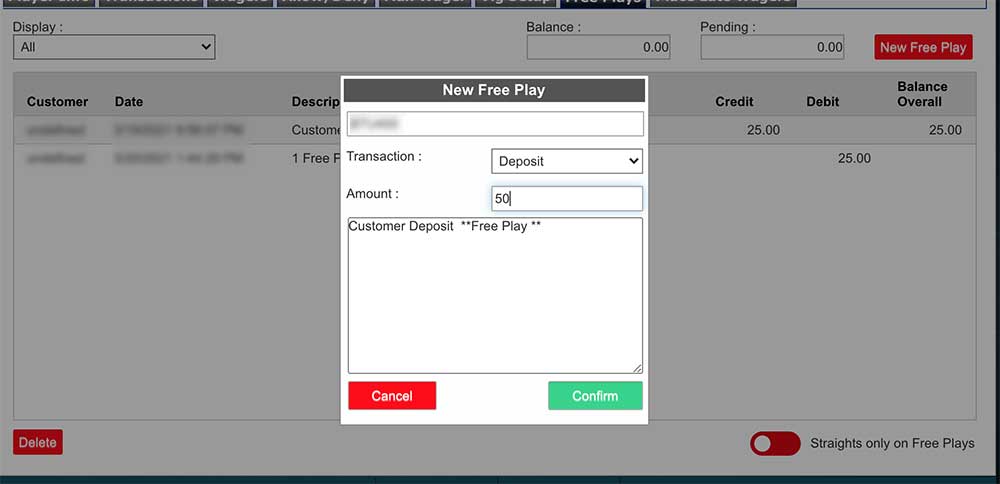
Choose the transaction type, the amount and an optional message.
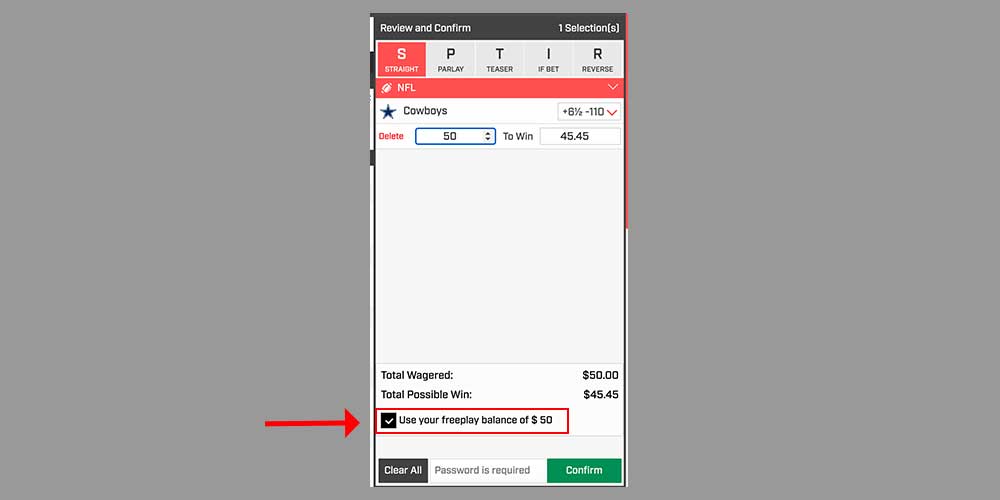
Your players will get to choose to either use their regular credit balance or their free play balance at the moment of entering their ticket.
A no deposit free bet (also known as no deposit bonus sportsbook) is actually free money betting for the player, so this is a great incentive to encourage referrals. As long as they have been referred by another player, they are good. This is another type of variation you may encounter when looking for the answer to what is a free bet.
Once your new player is ready to begin, you can simply log into your agent account and apply the free play amount to their account, as shown above. The player will see his riskfree betting balance on his account as soon as he logs in. Since this is truly free money betting, the amount is usually kept relatively small, around $10. This type of benefits are extremely sought-after by players looking for no deposit bonus sportsbooks.
Many sportsbooks put requirements on the free bet bonuses that they give out. Some common requirements are that:
In reality, a no deposit bonus sportsbook offering no deposit free bet work the same as the risk-free bet we talked about earlier, except that this doesn’t require the player to make a deposit first. This is a major difference between the two types of riskfree betting options. Additionally, these free plays given by the no deposit bonus sportsbook can be given by the local bookie as rewards for frequent players, or high-dollar players, or for anything the bookie wants.
A new player sign up bonus is another way to bring players in the door, but generally have more restrictions. As before, to ensure your players understand all the restrictions, it’s a good idea to send them the details of each bonus that they can earn. This can be done with a message, as we talked about above.
One common requirement of new player sign up bonus is a rollover. This means that for whatever amount their bonus is, your player needs to reach a certain amount of action before they can claim their sign up bonus. Let’s look at an example:
If your player deposits $500, and receives a new player bonus of $500, they will need to “roll over” that $500 bonus six times before they’re able to withdraw their bonus money. $500 x 6 = $3,000, so they need $3,000 of action within 30 days, and then the bonus is theirs.
Using a pay per head sportsbook service, you can easily track how much money players have wagered by using the “Customer Volume” report. From the main menu, select “Agent Performance”, then from the dropdown menu, select “Customer Volume”. After that, the “Total Volume” column will tell you how much money the player has bet. See the screenshot below.
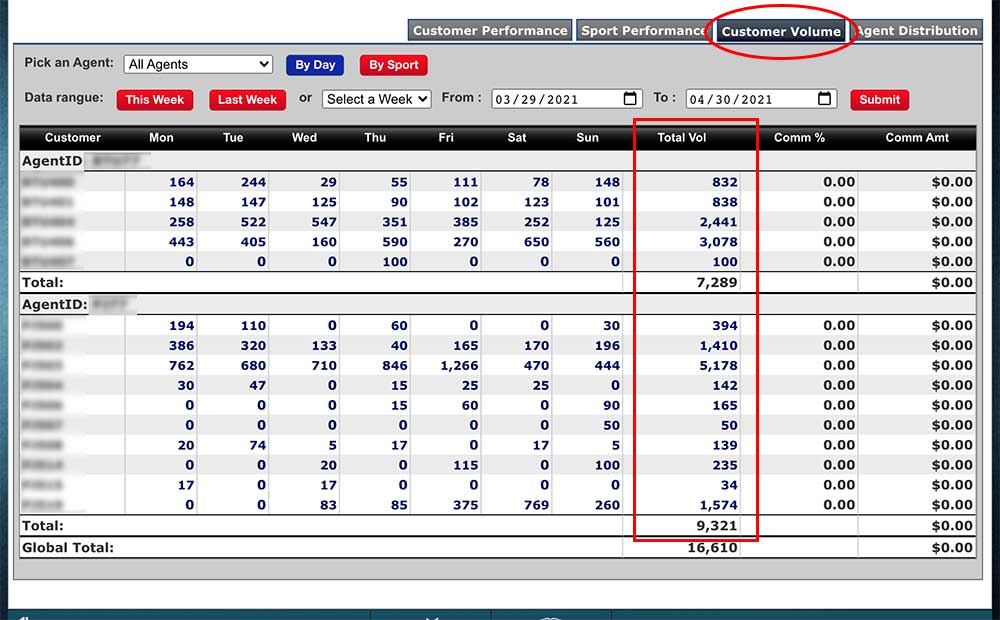
The Total Volume (“Total Vol.”) column displays the total amount in action any given player has placed.
Another common requirement for a new player sign up bonus is minimum odds. Many sportsbooks require players to play at odds of -200 or higher in order to qualify for the bonus. (Parlays with combined odds above -200 qualify as well.) Bets that are heavy favorites will not quality. It’s safe to say that sportsbooks will make it difficult for players to collect their sign up bonus.
This is a good time to tell you about another feature that bookies using pay per head sportsbook services can take advantage of, the “Temporary Credit” feature. Temporary credit is exactly what it sounds like, a credit given to a player for a limited amount of time. Bookies can set the amount and the expiration date of the credit. To set temporary credit, log in as an agent and select “Customer Admin”. From there, select the player account then expand the “Basics” section, and use the “Temporary Credit” and “Expires On” fields to set the amount and expiration date of the credit you are giving.
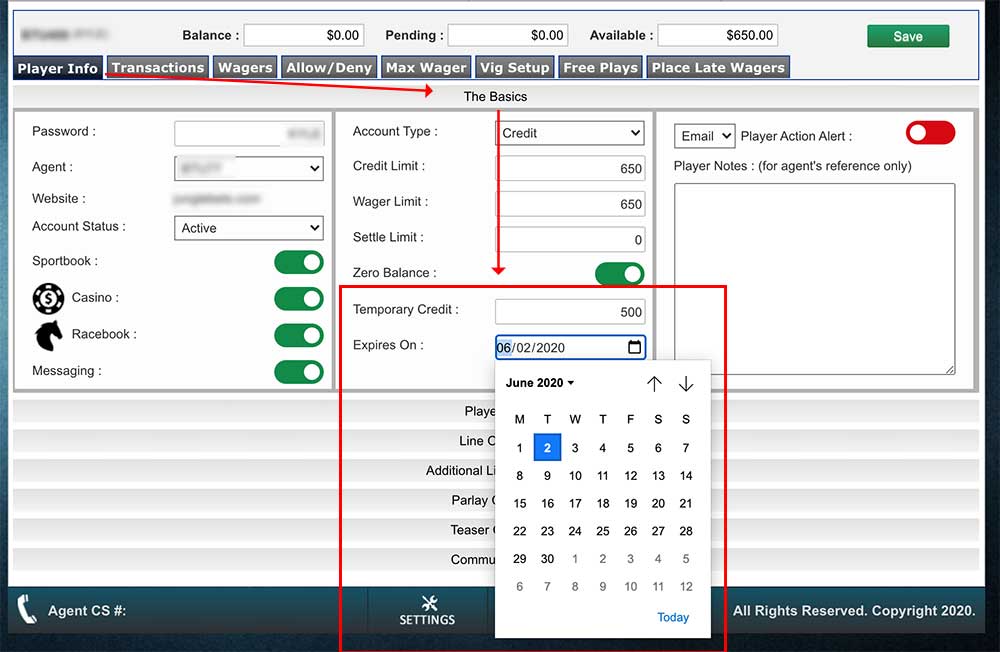
Giving a temporary credit is a great way to encourage new players onboard (just make sure they.
So now you have some strategies on how to attract new players and get referrals from current players. You’ve learned about some standard bonuses used by most sportsbooks, and how to implement and track them.
Remember, the most important key to bringing in new players is word-of-mouth. When your players are happy with their experience, they will return, and tell their friends. This means paying on time and having excellent customer service if an issue comes up. It’s always better to issue a refund and have that customer come back to play again than to lose that player forever.
Now is the time. Request your pay per head demo account today and put what you’ve learned into action. Sports betting is poised to become huge in the United States. The XFL debuted in February, and they showed the betting line and over/under on the television broadcast along with the score. States are passing legislation to allow and encourage sports betting within their borders. Don’t wait, get into the fastest growing business in sports today.
Carefully monitoring your players activity and behaviors can pay big dividens towards your pay per head sportsbook. Learn how our price per head sportsbook platforms differ from the rest in key features that set you profit margins apart from the rest. Read our pay per head sportsbook review guide.
Parlays are one of the hottest bets in the sportsbook world. They are a great way for players to increase their payout without increasing their wager. For this reason, we’ve put together some great information on parlays for you. We will discuss exactly what parlays are, and how they work. This article will explain the difference between the types of parlays, such as point spreads and moneylines. We will also talk about other facets of parlays, such as what the rules for bets that push in a parlay, and what is a key parlay. We will also give you some tips on how to customize your parlay setup.
(If you're just getting started in the pay per head sportsbook scene, check out our all-inclusive review article on the best pay per head software. We've gone into serious detail, comparing the key features offered by the best price per head providers in the industry. This article, containing HD screenshots, head-to-head comparisons, and in-depth explanations that really show off what makes these providers special. Dive into the diverse reports they offer and get key insights into how these reports help you understand your player base – this resource will give you all the valuable knowledge about the pay per head bookie industry.)
Let’s answer a common question we hear from a lot of players and local bookies: “how does parlay betting work?”. When your player places a bet, they are normally betting on just one thing. A race, a game, a score, etc. In a parlay bet, they are combining multiple bets. They must “hit” on all of the bets, meaning pick the winner correctly. If they do, they will see a substantially larger payout than a single bet. In a three-game parlay, the standard vegas parlay payouts is 6 to 1 (American +600) which is a huge payday.
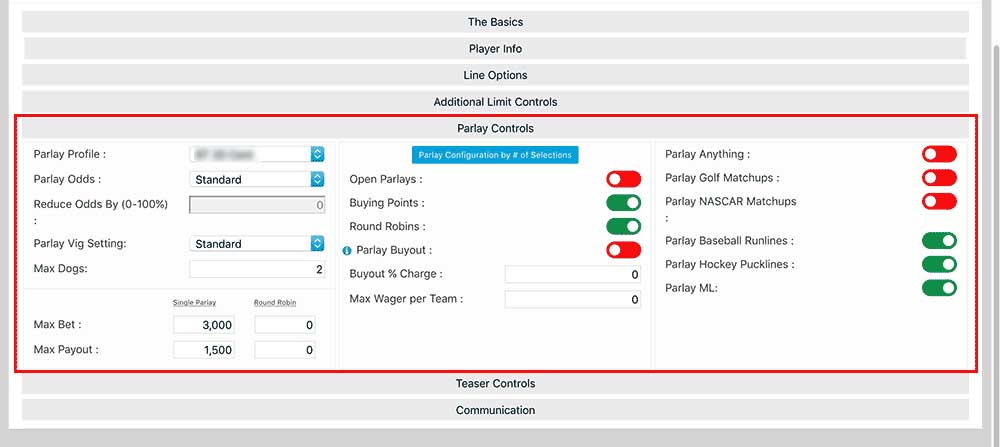
Another way to look at it is if they’re going to place three different $50 bets anyway, why not make them a parlay. They only need to hit on the parlay once in six times and it will do better than break even.
Parlays are good for minimizing losses as well. Let’s say a player bets $50 on three different games ($55 x 3 = 165), and they win one and lose two. They’ve lost $60. If they had parlayed those bets, they would only be down $50.
So even though the more games they add to a parlay, the harder it gets to win, the payout continues to be better than the risk. This should answer the common question: “How Does Parlay Betting Work?”
A typical points spread parlay looks something like this:
| 2 teams | 13/5 |
| 3 teams | 6/1 |
| 4 teams | 10/1 |
| 5 teams | 20/1 |
| 6 teams | 40/1 |
| 7 teams | 75/1 |
| 8 teams | 150/1 |
That means that if a player bets a four-team parlay and all four bets hit, they win $10 for every $1 they bet. So if they bet $100 on a six-team parlay and hit all six games, they will win $4000. Parlays allow players to win big money with relatively small bets. This is why parlays are so popular in sports betting.
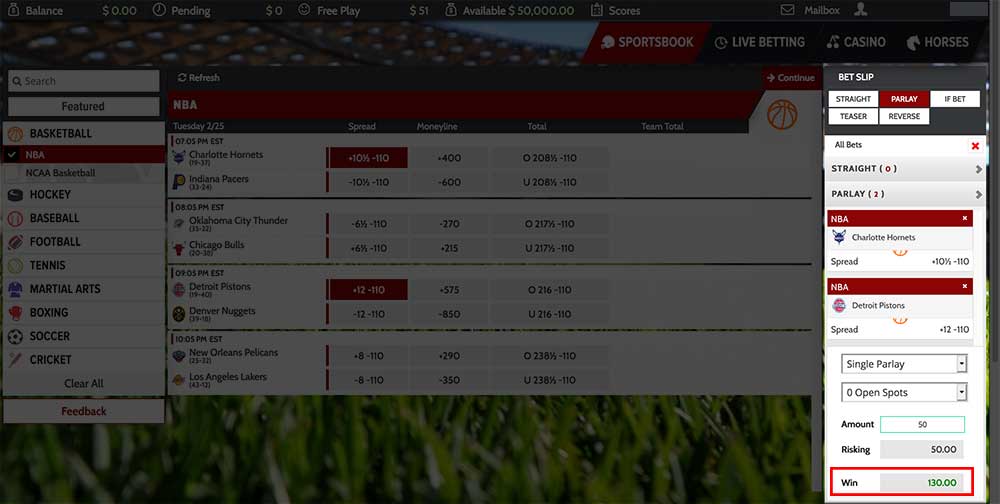
With a moneyline parlay, the odds of winning vary from team to team, so they don’t use fixed odds like point spread parlay. The point spread evens the odds of each team winning, but a moneyline parlay doesn’t do that. If one team is a heavy favorite, the parlay odds payout will vary accordingly. This is part of the moneyline parlay formula.
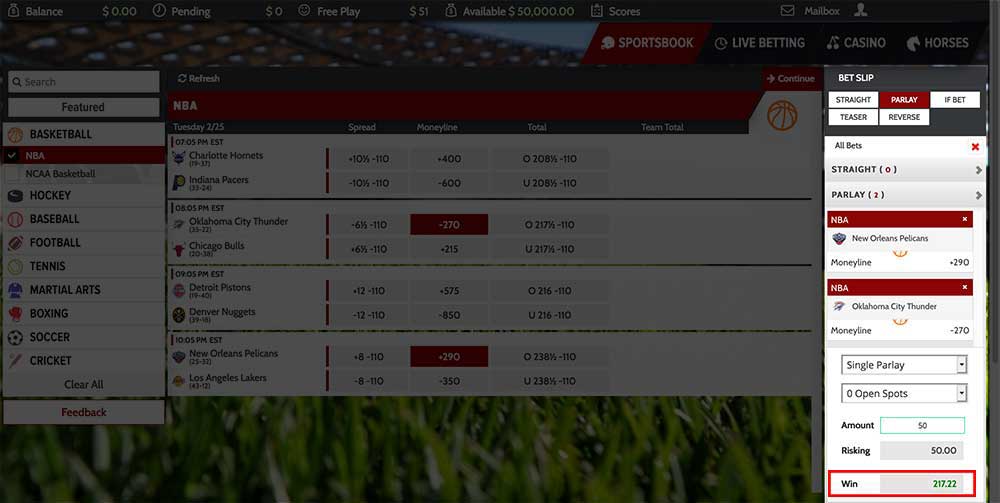
As the player wins a moneyline parlay, the money rolls over to the next game. Let’s look at an example of how the moneyline parlay formula works. Your player places a $10 moneyline parlay on the St. Louis Cardinals at +160 and the Texas Rangers at -130. The Cardinals bet wins and pays out $26, which rolls over to the Rangers bet. So the Rangers bet is $26 at -130. If the Rangers also win, the player has turned $10 into $46. That’s a $36 profit. If the player had made a point spread parlay on those games, the profit would have been $26. The difference comes from the fact that the Cardinals did not have good odds of winning.
Another important point to cover when answering the common question of: “how does parlay betting work?” is understanding True odds in parlays. As we talked about earlier, fixed odds means that all bets are 50/50 odds, this type of parlays use the standard parlay odds payout table discussed previously. If one team is better than the other, or one side of the bet is more likely, true odds are given. This is the typical scenario when placing a moneyline parlay. It’s important to understand that the term “true odds” does not refer to the actual odds of winning.

Let’s look at how the moneyline parlay formula works. In a true odds parlay, each of the bets is converted into a multiplier. In the moneyline parlay formula, the equation to get the multiplier goes like this: “return amount” divided by “risked amount”. Let’s do math. If the true odds are -110, a $110 bet returns $210 because $110 + $100 = $210. $210 return divided by $110 risk is shown as 210/110 = 1.91. That’s the multiplier. On -115 odds, the multiplier would be 215/115 or 1.87.
Now let's look at an example of a moneyline parlay bet. Our example is a four team parlay with true odds. Here are the odds:
| Bet 1 | -110 |
| Bet 2 | -140 |
| Bet 3 | +210 |
| Bet 4 | -110 |
Let’s say our player bet $300. Our first step is to get our multiplier using the math equation return amount divided by risk amount. Here are our multipliers.
| Bet 1 | -110 | 1.91 |
| Bet 2 | -140 | 1.71 |
| Bet 3 | +210 | 3.10 |
| Bet 4 | -110 | 1.91 |
Continuing with the moneyline parlay formula, now we multiply the multipliers, and come up with 19.3385. If we take this number and multiply it by our players bet amount ($300), we get $5801.55. Remember to take away our original bet of $300, and our player is left with a four team parlay profit of $5501.55. Not bad.
As a bookie, when using our pay per head platform (request a free demo here), you can adjust the true odds by the “Reduce Odds By” option. This takes away a percentage from all true odds parlay payouts. (Example: True Odds -10%). This is a great aid for local bookies wanting to offer a reduced payout not only on fixed odds parlays (those with a spread of -110), but also those with different moneylines, hence using the true odds moneyline parlay formula).

Normally when one of the games in a parlay pushes, that bet is removed from the parlay. This is the most common behavior of a push in a parlay. So if the player wagers a three-team parlay, and game three ends pushes, the wager turns into a two team parlay, and therefore the payout is calculated as a 2-team parlay payout. But that’s not always the case. Here are three examples of how sportsbooks treat a push in a parlay:
As a bookie working with pphsportsbook.net, you get to decide how you handle a push in a parlay. Using our pay per head sportsbook solution, you have the choice of setting your players’ parlays to “Remove Leg” or “Loss”.
Each bookie operates under slightly different rules. Making your rules clear to your players is important to help them avoid unnecessary losses and complaints towards your business.
Another relevant issue to address is: “what is a key parlay? Key parlays is a topic not frequently discussed when answering the question: “how does parlay betting work?”. A key parlay is another way of linking wagers. In a key parlay, the player selects a team as the key, and parlays that team with other teams. This is the basics of “what is a key parlay”.
Let’s look at an example to better answer the question: “what is a key parlay?”. Let’s consider team A, B, and C. Team A is the key. He parlays Teams A/B, and Teams A/C, but not Teams B/C because that doesn’t include the key.
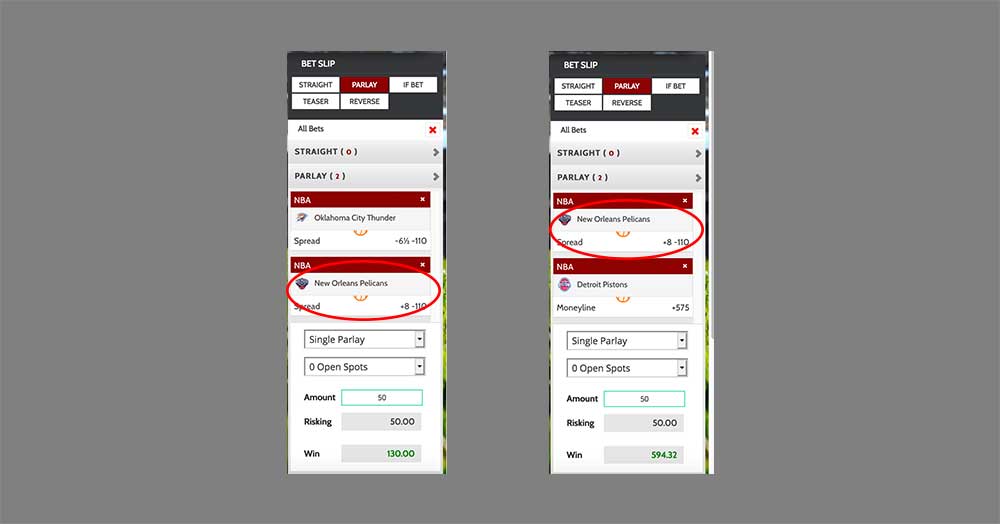
Now let’s use three baseball teams as an example. Our player plans to bet on the Reds, Astros, and Cardinals. He uses the Reds as his key. So he parlays the Reds and Astros to win, and also parlays the Reds and Cardinals to win. But NOT the Astros/Cardinals, because that doesn’t include the key. With this concept, you can also have multiple keys and multiple teams in the parlay. These are the basics to understand “what is a key parlay”.
Las vegas parlay payouts in most sportsbooks are slightly less than the actual odds of winning. Take a look at the standard parlay odds payout chart below.
| Teams | Actual Odds | Las Vegas Payout |
|---|---|---|
| 2 | 3/1 | 2.6/1 |
| 3 | 7/1 | 6/1 |
| 4 | 15/1 | 10/1 |
| 5 | 31/1 | 20/1 |
| 6 | 63/1 | 40/1 |
| 7 | 127/1 | 75/1 |
| 8 | 255/1 | 150/1 |
As a local bookie, you have the ability to change the standard parlay odds payout from the traditional “vegas parlay payouts” using our pay per head service. These only apply if your player is betting at -110 odds (to see how you can reduce the true odds payout see the “Reduce Odds” section).
For example, you could set a two team parlay to pay at 2.1 instead of the traditional vegas parlay payout of 2.6. You also have the ability as a local bookie to set the maximum parlay payout. For example, a four team parlay with a wager of $100 would normally pay out $1228. But you can set your max parlay payout to $1000, instead of the full amount.
In this article we’ve talked about what parlays are and several different types of parlays. Parlays are a great way to keep players interested and keep the bets going, as well as a way for players to increase their potential earning while risking the same amount. We have also given you several ways to customize your parlays on your sportsbook.
If you’d like more information on how to begin using the parlay information you learned here, as well as all of the other tools available on our pay per head sportsbook, simply request a free demo account today!
Not ready yet? Compare the best providers here with pay per head sportsbook review guide.
What better way to make up your mind than comparing pay per head service providers? We have decided to do the hard work for you and visited the top PPH sportsbook services out there and put together these reviews of the best pay per head sportsbook sites.
Some of the most important factors considered when choosing a new home for you and your players:
These reviews of the best pay per head bookie sportsbook service have been written by visiting the provider’s website and using one of their publicly available Demo accounts.
The reader needs to know that since some features may be disabled by default on those demo accounts, it’s always better to contact the PPH Sportsbook provider directly and verify the information with them. With that said, we believe this article will be useful as it will compare, head to head, the providers within the same factors. You can then verify the information written here by contacting them directly.
*Note for providers: If you feel we missed something and will like us to update some information, simply send us an email, provide us with a demo username and password (that includes the feature you want us to update these reviews of the best pay per head sportsbook sites for), and our writing team will visit your site, verify the information and update this article accordingly.
*Since this is a lengthy post, feel free to use the contents navigation widget to the right side of the page (or fixed to the bottom if you are reading this on your mobile device), to skip to the pay per head provider (or features) you want to compare.
The first provider we will discuss as part of these reviews of the best pay per head sportsbook sites is Aceperhead
This PPH sportsbook features an extensive betting board, with plenty of lines for your players to choose from. If you are looking for the sports bookie software with most lines available to offer to your players, Aceperhead.com is definitely a great option to go for.
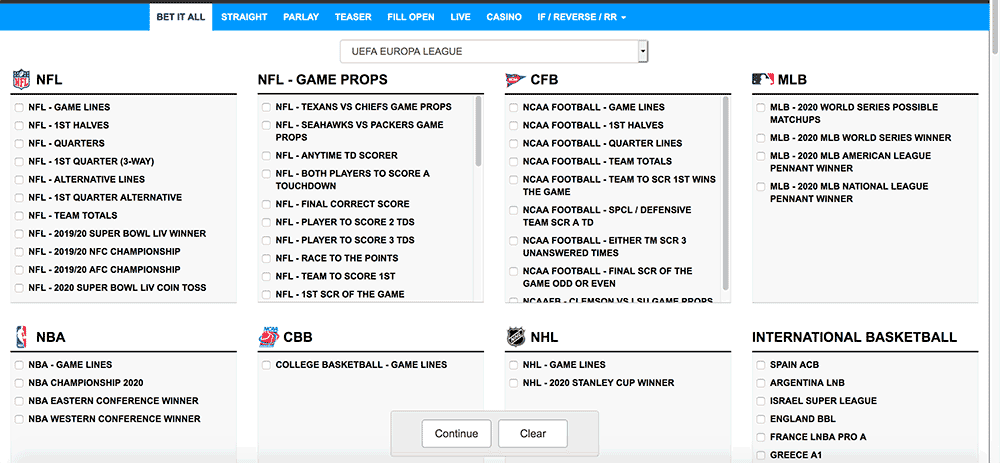
There is no lack of betting options within the Aceperhead pay per head sportsbook
It also features a convenient search tool that allows players to easily type the name of the team they are looking for and will filter games that include such names.
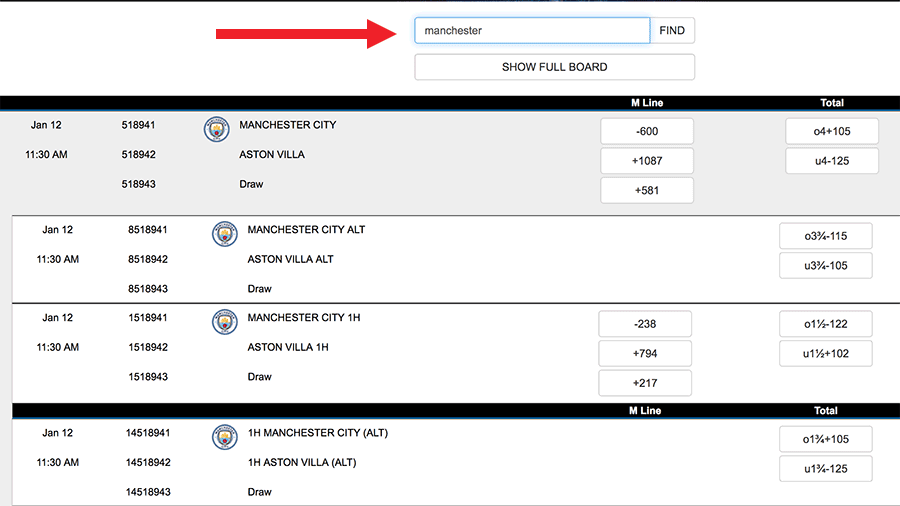
Once in soccer, typing “Manchester” will filter all games containing this word.
As mentioned, this payperhead is worthy of commendation for the number of lines they have. In terms of line quantity, it is only rivaled by BookiePPH.com and Idsca.com. One downside is that their sportsbook design and the interface look outdated when compared to other PPH Sportsbooks that have implemented more modern interfaces that make the process of entering a ticket faster, easier, and more enjoyable for your players. In these cases, the whole process is completed within the same screen, without having the player go through multiple screens to enter a simple ticket.

3 out of 4 screens a player needs to go through to enter a single straight bet.
This online bookie software offers to you and your players, one of the most modern sportsbook interfaces. With a one-page experience and modern bet-slip functionality, your players will feel right at home.
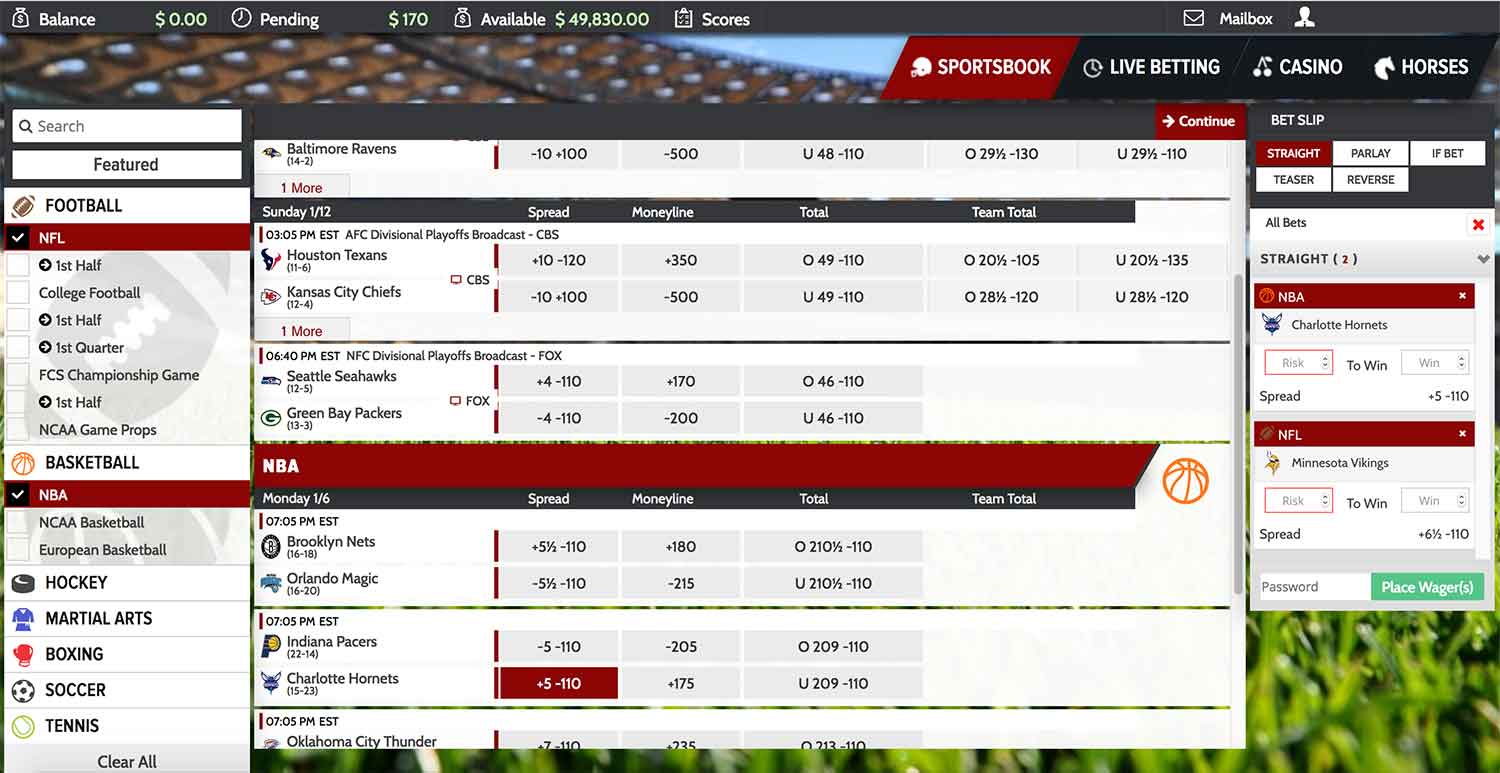
Entering tickets is done within seconds. However, by still asking the player to confirm the bet by first entering their password, we ensure no complaints about mistakenly entered tickets from players.
There may be hundreds of games available on the board at any time. Instead of your players having to browse to the sport, then to the league, and then look for the specific game; the filter functionality allows them to simply type part of the team's name, hit enter, and the board will update to show only the games that include the characters typed.
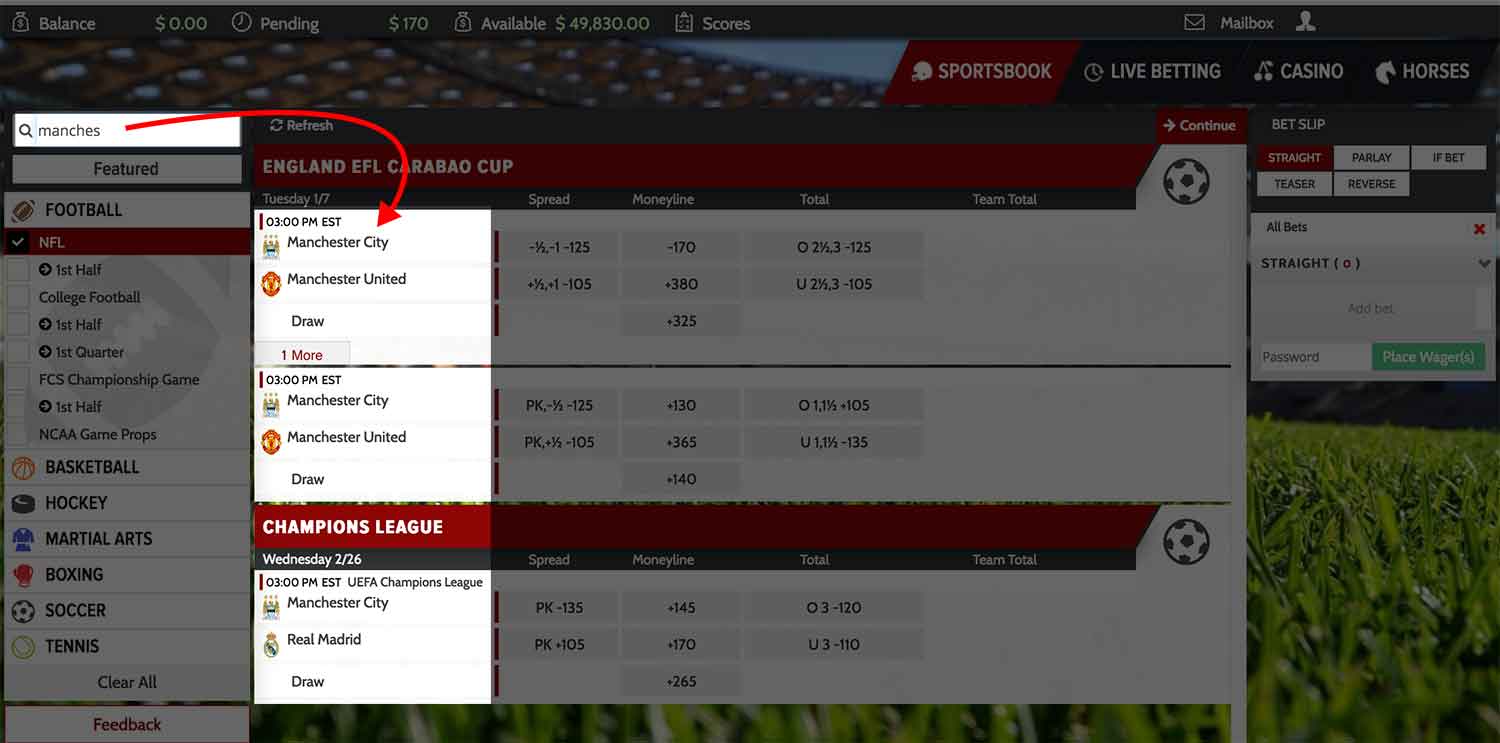
Start typing the name of one of the teams. Hit enter and the board will update to show only games that contain such teams.
Similar to other price per head service providers, PPHSportsbook.net has a daily figures screen (also called "weekly figures"), which allow players to keep a note of their performance per day of the week without having to contact the agents.
By clicking on each day's number, all tickets placed that day to make up for that figure will be displayed below, along with their corresponding timestamp, wager type, description, and results. This helps your players filter the tickets placed by day.

Clicking the $182.82 figure for Monday, December 23rd, all tickets that make up for this amount will be listed below.
Besides the Weekly figures screen, which breaks down the action per day of the week, players using this pay per head sportsbook can also easily track their balance using the "transaction" screen.
The "transaction" screen shows the date, the type of transaction (wager won/loss, balance adjustment, etc.), the corresponding balance on that date, and the updated balance after that amount.
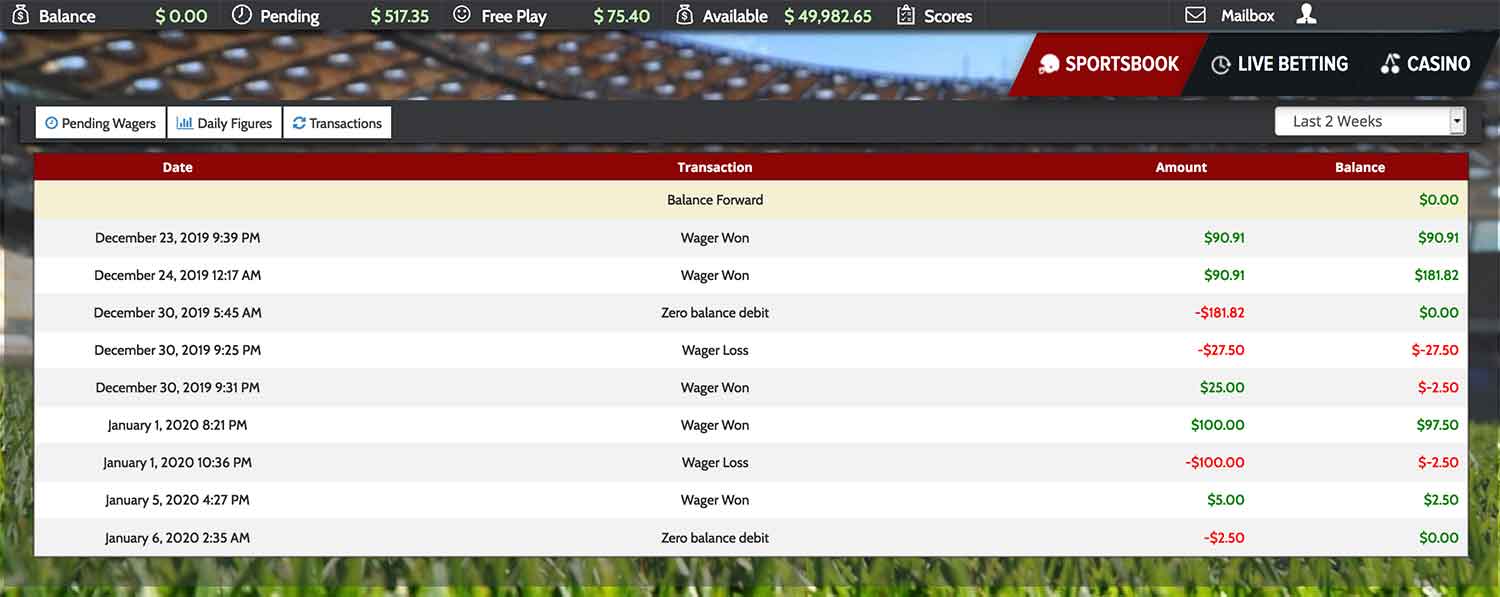
Players can easily keep track of their performance by day. This helps increase your book's credibility and player’s trust.
At any moment, players can look up final scores by simply clicking the corresponding option at the top sportsbook agent sites menu.
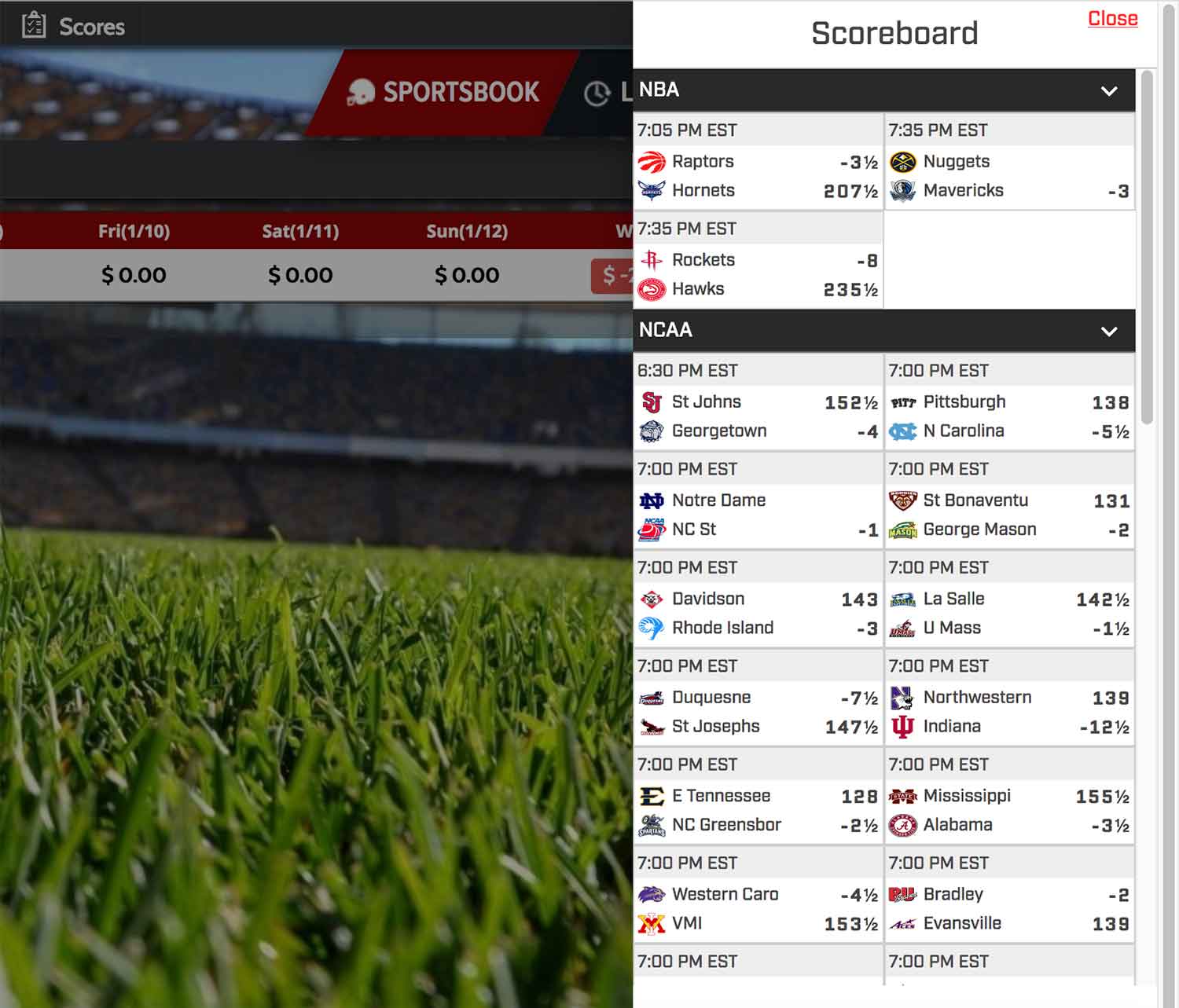
Players can look up game scores right from within the price per head sportsbook software.
PPHSportsbook.net provides two types of customization available to your players.
Skins are different sportsbook layouts. These skins change the colors, fonts, icons, graphics, and the overall look and feel of the sportsbook, with one click.
There are two types of skins, the general skins and the team-based skins:
Currently pphsportsbook.net provides 4 different general-purpose skins:
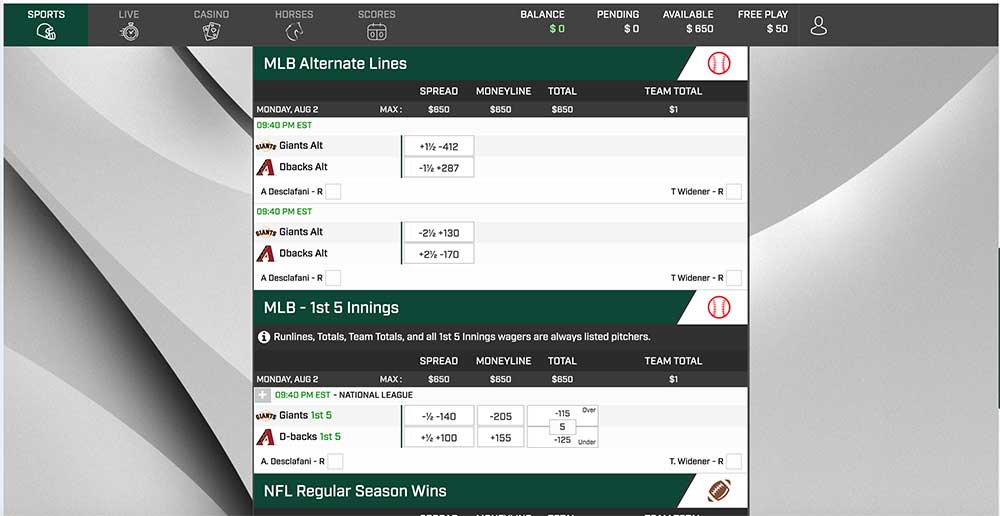
The “Gray” skin brings a lighter background, changing colors and adding a 3d background image.
Another option to personalize the price per head sportsbook software is to choose one of the team-based skins. These are grouped by league (NFL, NBA, MLB or NCAA).
Selecting any of these will cause the header's colors and background image to reflect those of the selected team

Available options include all major teams from the NFL, NBA, MLB, and NCAA. Each selection will not only match the colors of the team selected but also include a corresponding background image.
There are customized skins for almost every team of the major sports leagues.
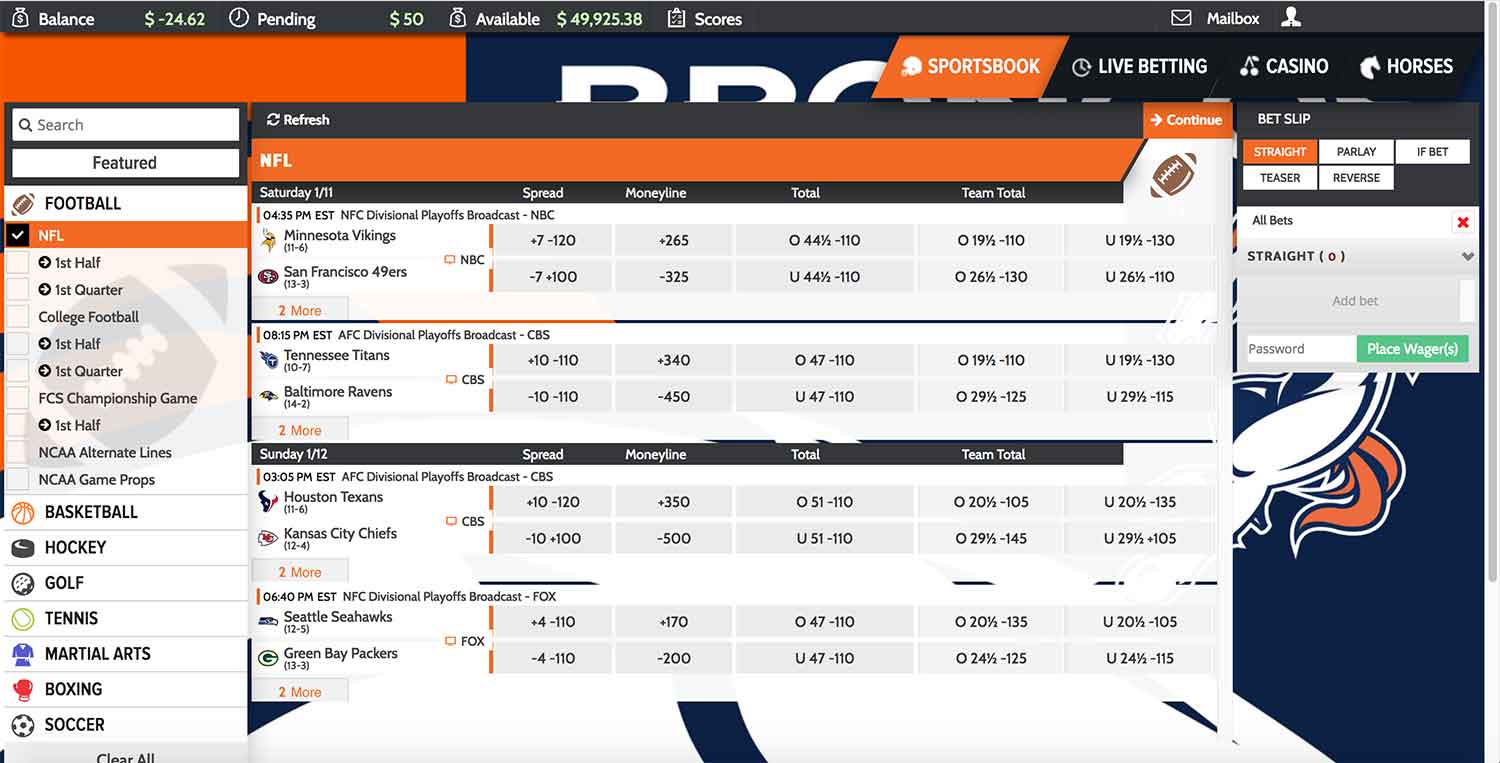
The Denver Broncos skins change the colors and the background image to match those of the player’s favorite team.
Further customization includes:
As you can see, we, at PPHSportsbook.net, pay special attention to make sure the sportsbook is fully customizable to your players’ likings. And that allows them to make it their own and feel right at home by changing skins, favorite team background, etc.
The next pph service we will discuss in these reviews of the best pay per head sportsbook sites comes with plenty of lines for your players to choose from. It also has a clean look along with a multi-page classic layout and attention to detail.
The layout, though, may look outdated for some players. Nowadays, almost every major post-up sportsbook uses a bet-slip functionality, which allows players to enter multiple tickets and combinations without having to browse through multiple screens and without leaving the main sportsbook board, so there is no reason for pay per head website services to lack behind and, at least, offer the option for a bet-slip experience to your players.
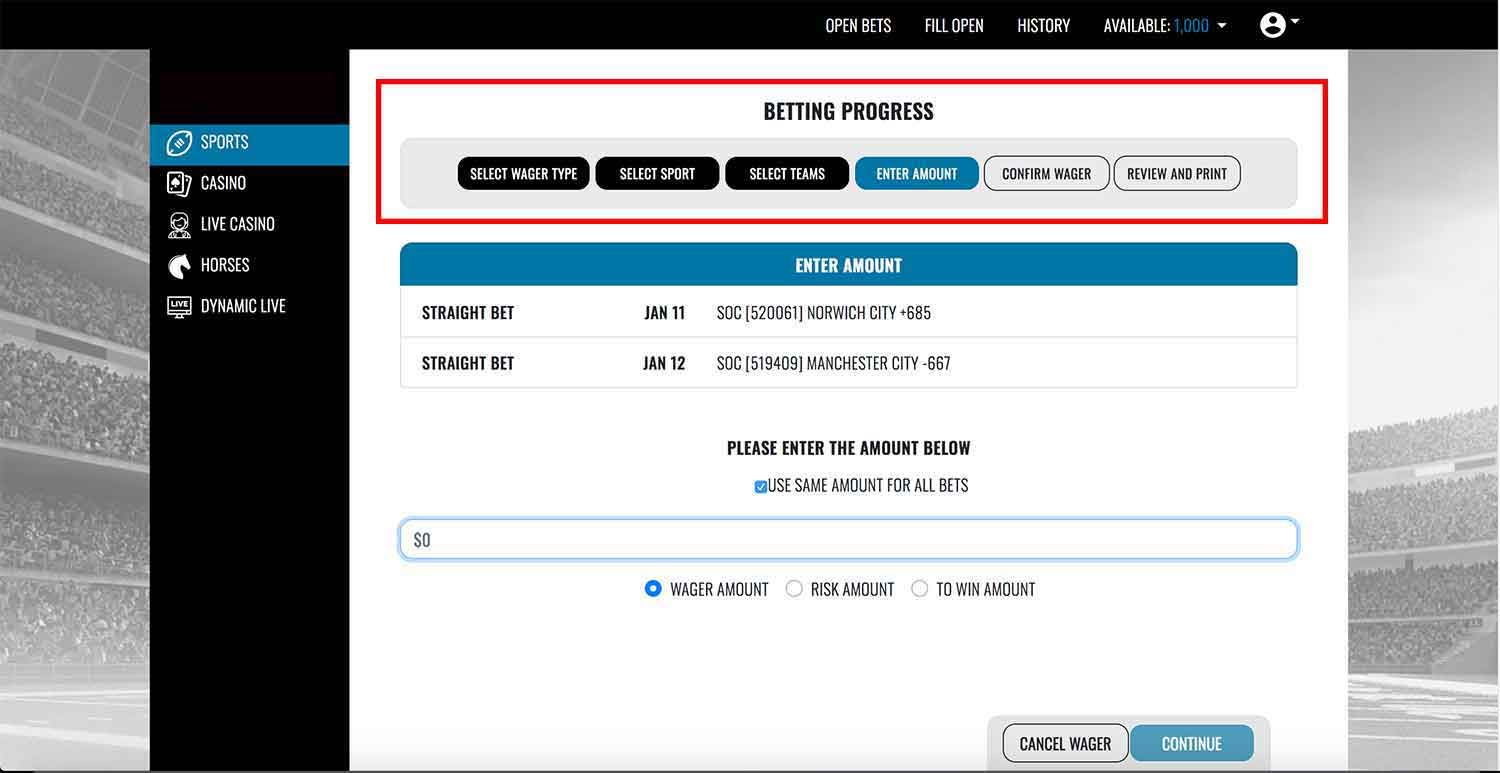
Realbookies.com PPH sportsbook is clean and shows attention to detail. Unfortunately, some players may find it cumbersome having to navigate through 6 different screens to enter a simple straight bet.
Realbookies also has useful search functionality that allows players to search, first by the league (e.g., “English premier league”) and later by the team itself (e.g., “Manchester united”). This should be a welcomed addition by players, especially when making their way through the various betting lines offered by this pay per head software provider.
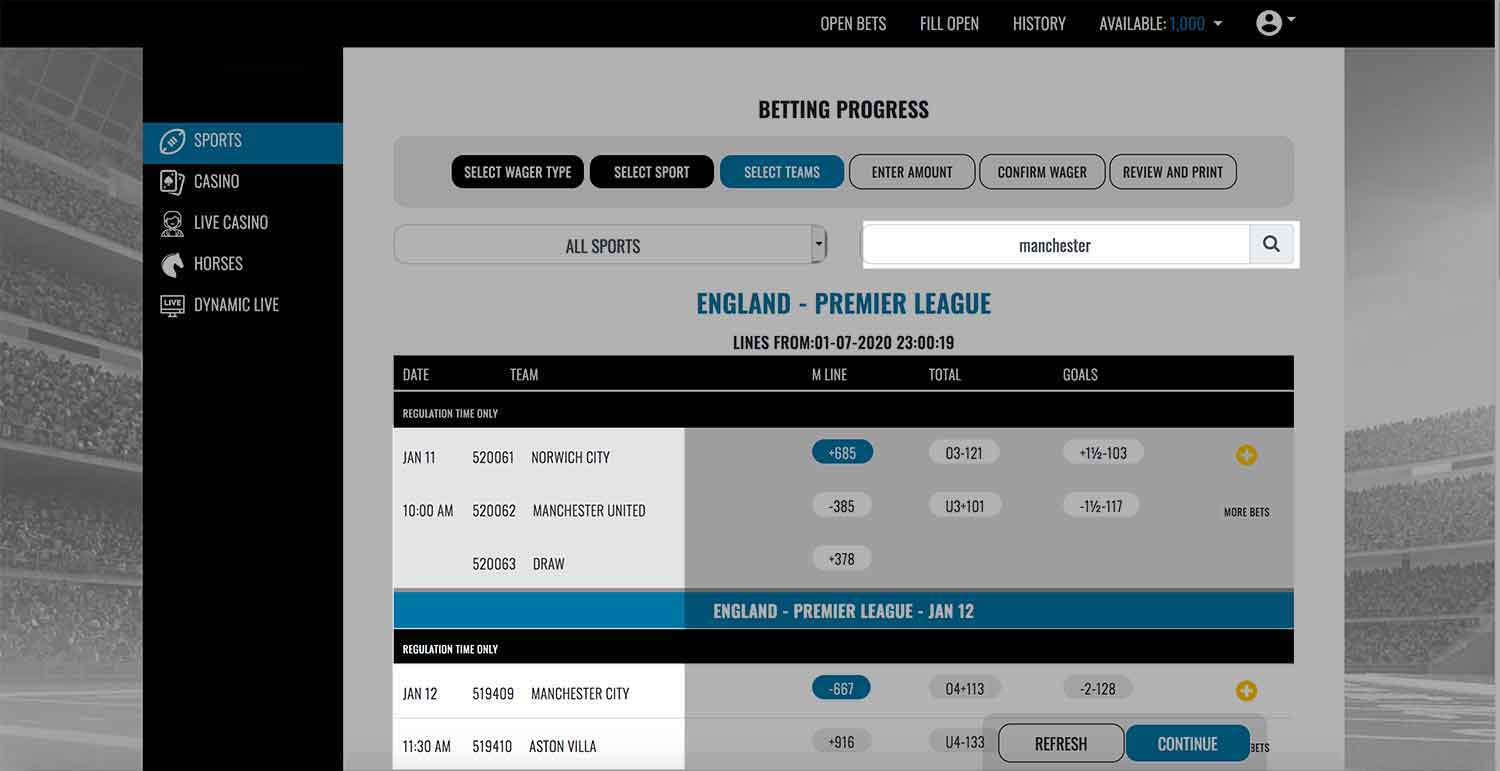
Searching for “manchester” will return all games which contain such name.
In regards to the reports and options available to the player, Realbookies comes with the standard weekly balances report, which allows players to see their performance per week.
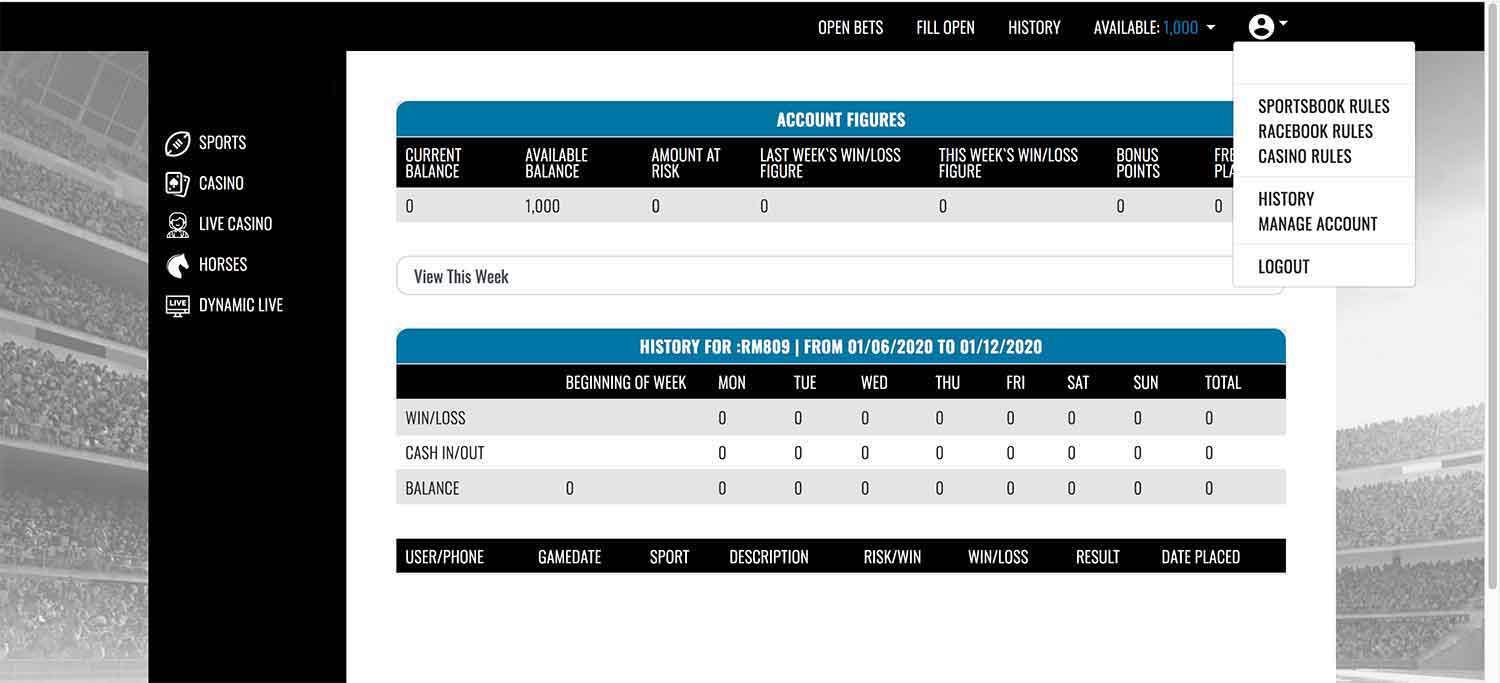
Your players will be able to track their action back to previous weeks.
In regards to customization options from the player side, they will be able to choose the sportsbook language from English to Spanish; select one of many time zones options; decide between American, decimal, or fractional odds styles; and finally, font size.
We believe there is also an option to change the sportsbook color palette. However, that is likely done either from the agents back-end or by requesting it to the PPH sportsbook’s customer service department, since there was no setting for this from the player side.
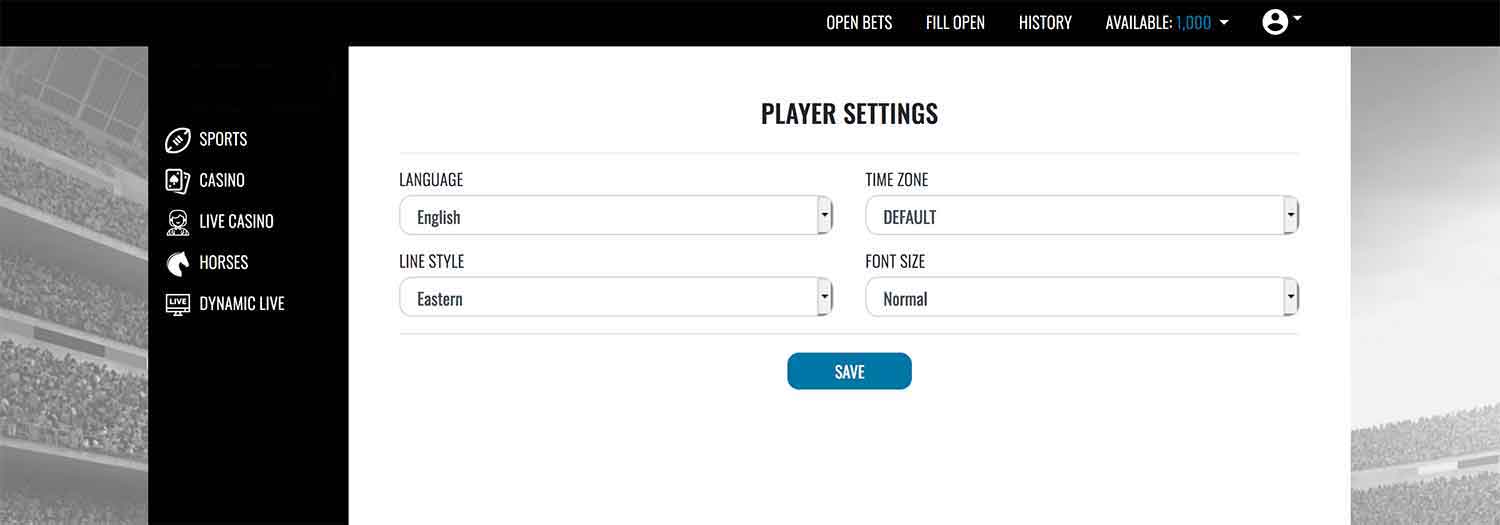
Some solid yet basic customization options are available to your players when choosing Realbookies.com as your online bookie service.
This bookie website software has a nice layout that is easy on the eye and is also mobile responsive (the layout adapts to whatever device your player is using). All sports are shown throughout the board. Unfortunately, similarly to Aceperhead and Realbookies, the sports are displayed all over the board, without some proper navigation structure and a dropdown menu that could make it easier for players to find the sport they are looking for.
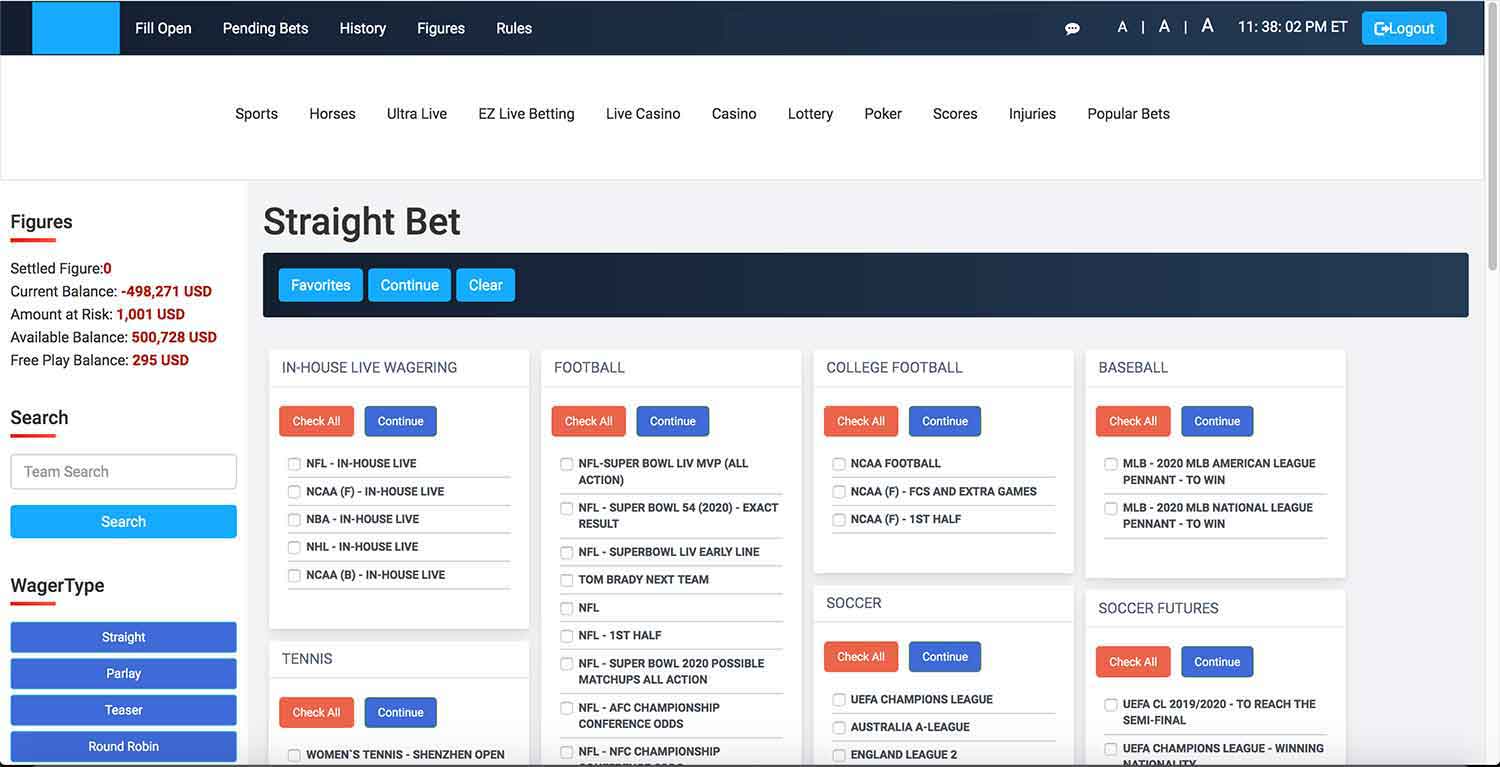
We commend Realpriceperhead.com for investing in a more modern look on their sportsbook. Unfortunately, behind some nice colors and fonts, all sports betting lines are spread out throughout the board, in no particular order, making it harder and more time-consuming for players to get to the game they are interested in.
Additionally, this price per head bookie sportsbook layout has a more modern look and feel. Still, it requires players to go through a tedious multi-page process to enter their tickets.
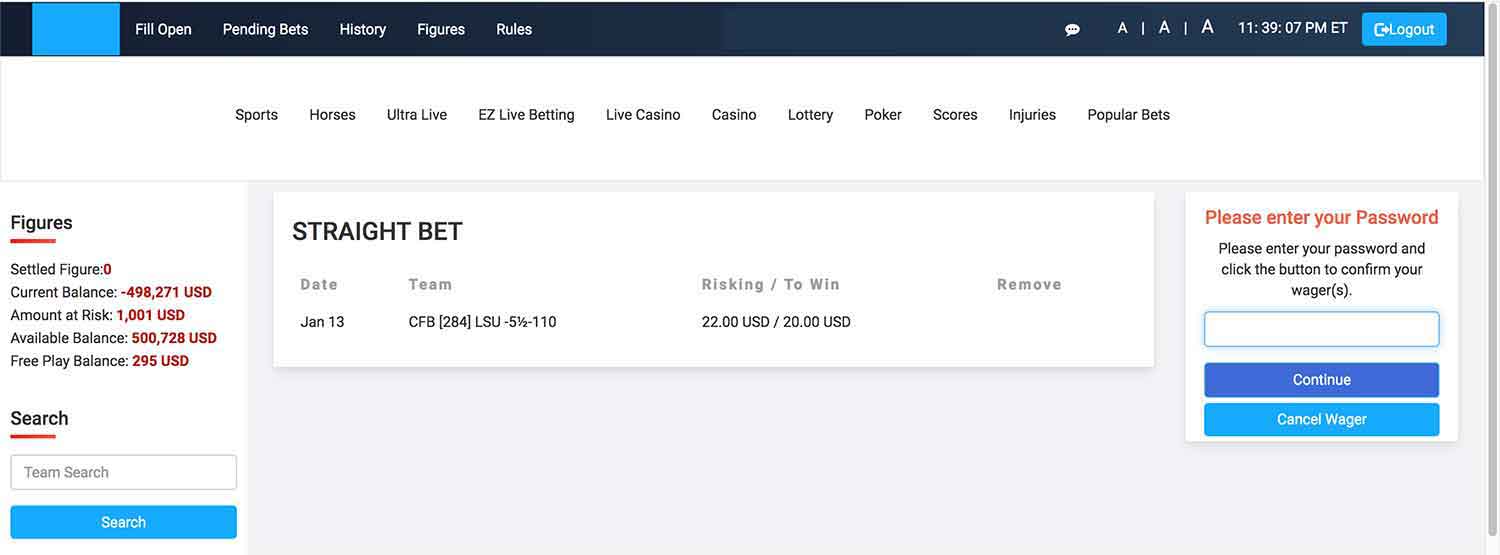
Select the sport and league, click “continue,” find the game and select the line, click “continue,” enter the wager win or risk amount, click “continue,” type the password, and click “continue.” You are done!
Realpriceperhead.com also has a search tool for quick filtering. Unfortunately, it seems to filter by league instead of by the team. So, for instance, searching for “Manchester” will return all leagues where a team name includes the word “Manchester.” This means, this search also returns all other teams that do not include such a word, but that play within the same league as the name of the team entered.
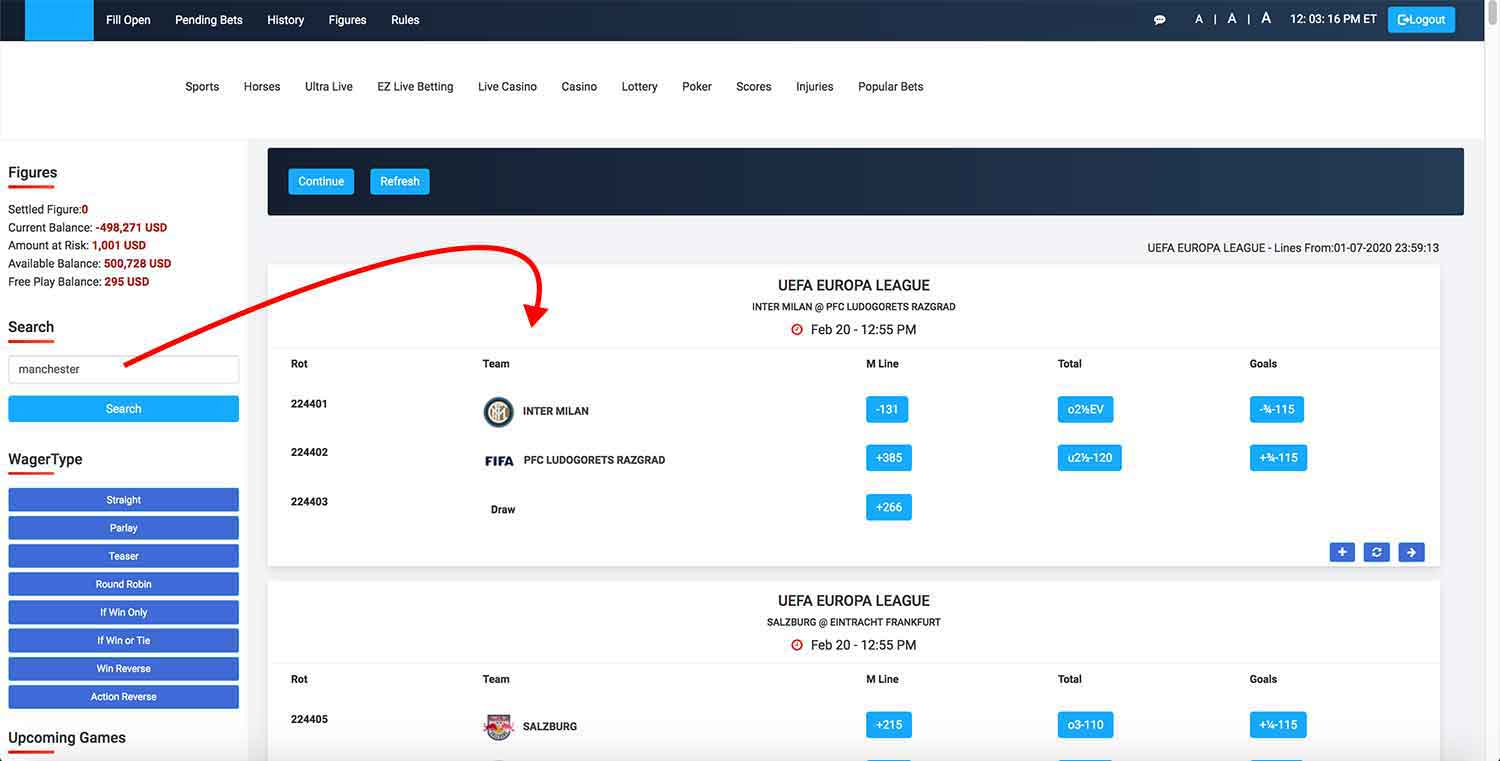
Realpriceperhead.com’s search tool filers at the league level rather than at the game-level. This causes a lot of non-desired results to be included in the results.
The standard player weekly figures and wagers history reports are also available to the player. Even though there is no cash flow or balance tracker for the players, they will still be able to check past and open tickets from the bookie software program reports.
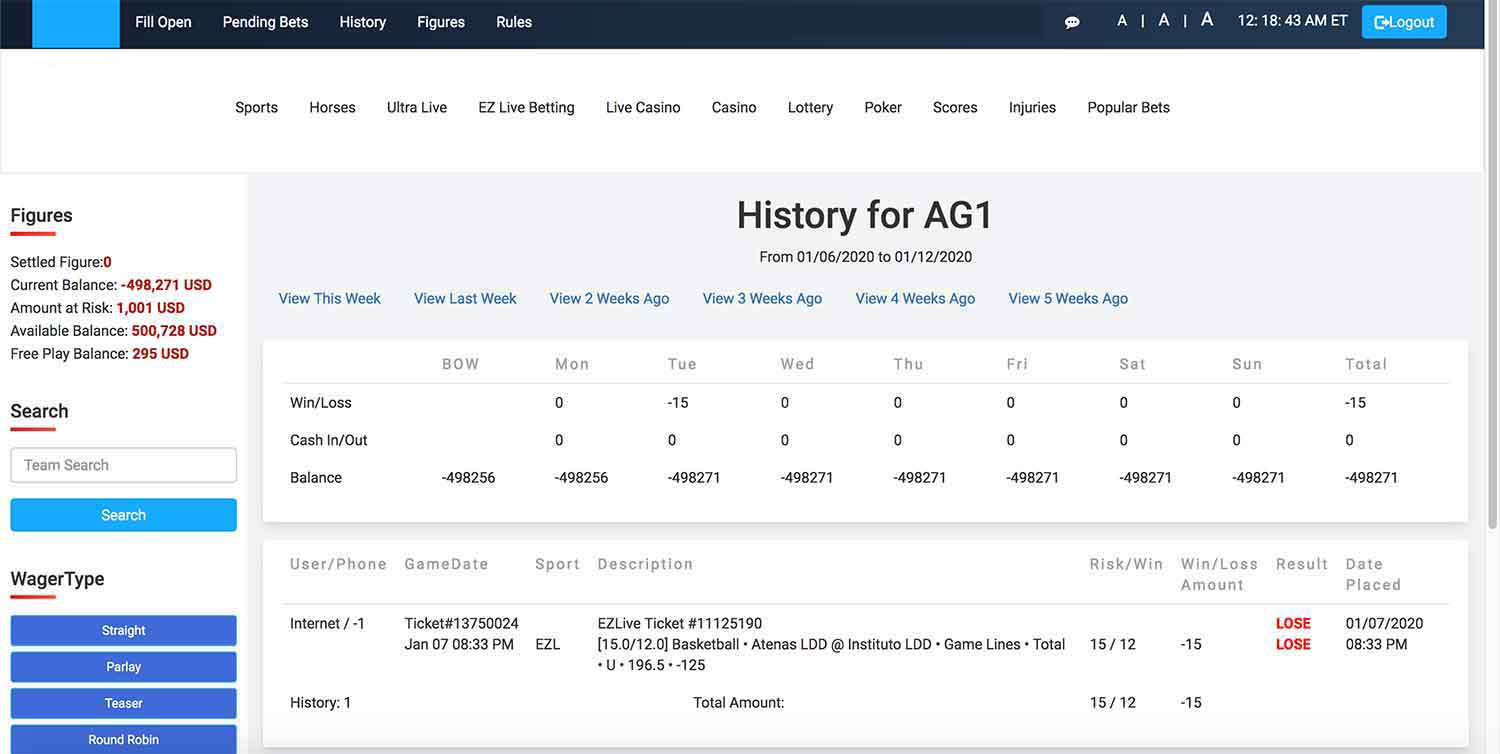
Players will be able to check their action back to previous weeks.
In regards to sportsbook customization, players can change their password, time zone, and odds display (American, Decimal, and Fractional).
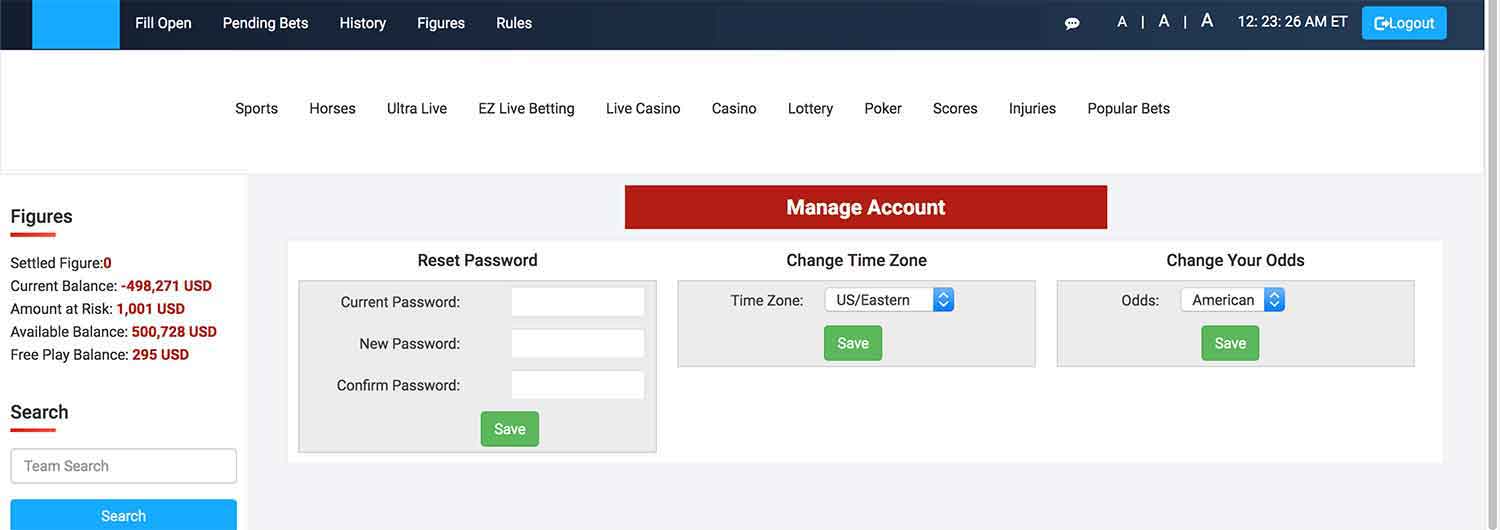
Don’t expect much more than the default and minimum customization options.
Idsca pay per head bookie service offers a modern and nice looking sportsbook interface. Plenty of lines and a smooth experience will keep your players coming back for more.
All the process of entering the tickets is done within a single screen, thanks to a handy bet-slip functionality.
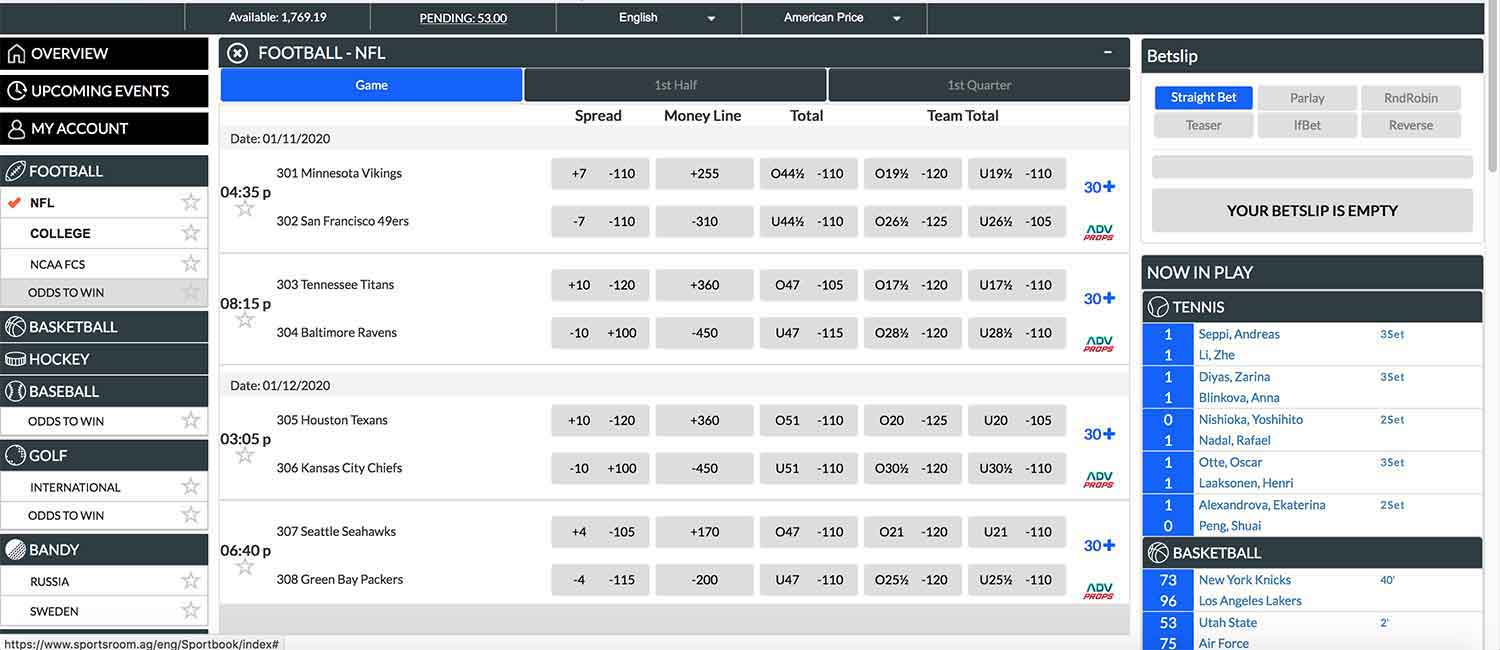
A nice and modern sportsbook with bet-slip is what your players will enjoy when using Idsca.com as your pay per head (PPH) sportsbook provider.
Currently, there is no search tool available for players to quickly find the games they are looking for. This would be a welcomed addition considering Idsca offers action on plenty of markets, and the lack of such functionality makes it difficult for players to quickly find the game they want to place their tickets on.
Pending wagers, Daily or weekly figures, and Transactions - which show a cash flow of the player balance after each transaction (wagers, credits, etc.) - are available to the player.

Player reports (sportsbook) at IDSCA.com price per head bookie software.
Other than changing the betting line format from American to Decimal, and changing the language to English or Spanish, there are no further customizations available for players. Nothing against the default layout and colors used by the Idsca pay per head service, but a little bit more options allowing players to make it their own would’ve been a welcomed addition.
As an agent, one key component of having your own sportsbook is having the option to move and adjust your lines and odds. This is the next feature we will discuss in these reviews of the best pay per head sportsbook sites.
The way this feature works is similar on almost every PPH sportsbook:
*Because of the nature of the business, the odds can change at any moment due to several factors, such as injuries, market perception, etc. Hence, it is recommended to always set your lines to “soft shade,” so it follows future changes.
| Your line | Main line | |
|---|---|---|
| Default line | Cowboys -5.5 | Cowboys -5.5 |
| You adjust your book’s line by half a point. | Cowboys -6 | Cowboys -5.5 |
| The main lines moves by half a point. Your sportsbook line follows by the same amount. | Cowboys -6.5 | Cowboys -6 |
This provider, among the other pay per head sites, uses the standard DGS lines mover tool. It does get the job done, even though with some setbacks. To ACE’s credit, their implementation of the tool loads faster than what we have seen with other PPH Sportsbooks. So props to their engineering team, which have paid attention to make it load as fast as possible.
That aside, there is no way around the fact that the standard DGS’s lines adjustment tool is not easy on the eyes. From the colors, fonts, and overall layout. It leaves a lot to be desired.
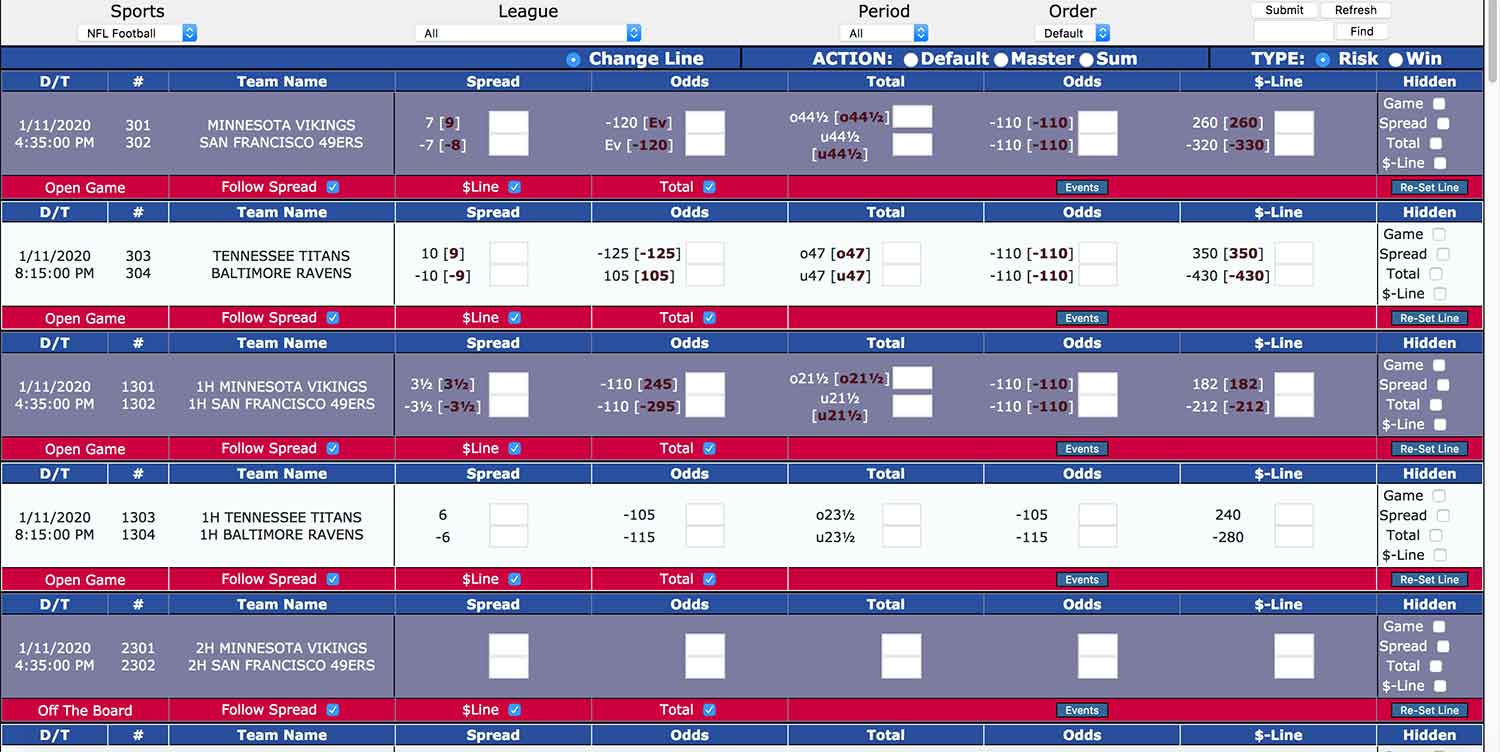
The default DGS lines mover is limited to do that, move lines. It’s not pretty on the eyes but gets the job done.
Based on our reviews of the best pay per head bookie sportsbook service, when we look at the functioning of this Lines Mover feature provided by Aceperhead.com, we concluded the tool comes off as very outdated.
For instance, say you want to adjust your sports bookie software lines based on the action you are receiving. With the current setup in most pay per head service providers, you will need to open multiple reports to first understand the action your sportsbook is receiving and then go back to this tool and make the actual line adjustment. This workflow complicates the entire process.
The process would go like this:
Open the “Exposure” report on one browser tab. This report shows you the risk amount on each game, broken down by wager type (straight, parlay, etc.) and bet type (spread, moneyline, total).

Have one browser tab open with the exposure report and another tab with the lines mover.
When compared to other price per head services out there, at the time of writing these reviews of the best pay per head bookie sportsbook services we noticed a couple of issues with this report:
Payperhead.com uses the same, previously mentioned default DGS lines mover tool. Same cons and pros. You can read about this version of the tool here.

Payperhead.com uses, as Aceperhead does, the default DGS lines tool without any enhancements to the default setup.
Realpriceperhead.com uses the same, previously mentioned default DGS lines mover tool. Same cons and pros. You can read about this version of the tool here.

Realpriceperhead pph sportsbook uses the default DGS tool.
This payperhead sportsbook’s lines mover (named “game admin”), just as the name implies, is much more than a simple betting line and odds adjustment tool. It is the perfect tool for bookmakers to monitor their online bookie software sportsbook exposure and as well adjust the odds offered.
From the same screen, they will be able to see:

The Game Admin page is much more than a line mover tool. It allows you to monitor the action your pay per head sportsbook is receiving and adjust your lines accordingly, all from within the same screen.
Clicking on the exposure number will reveal all wagers that make up for the exposure amount:
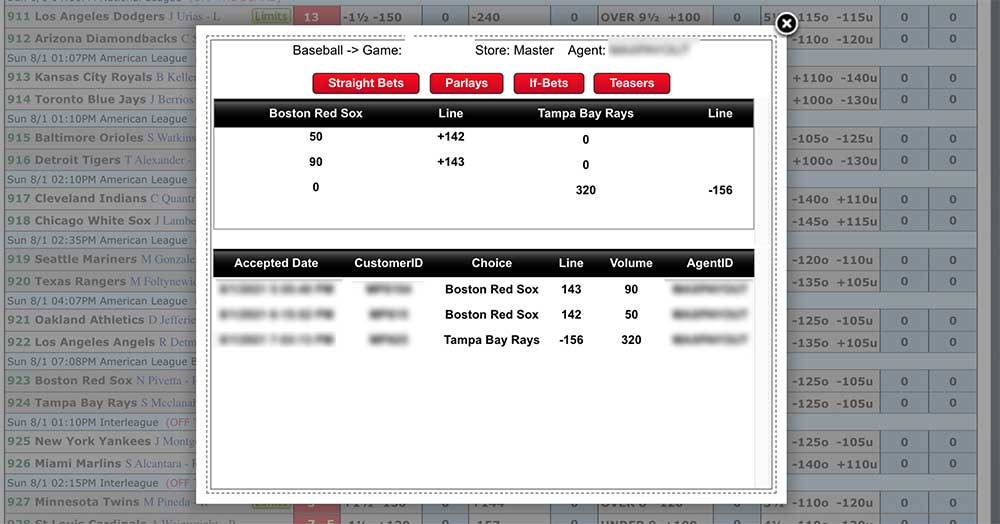
All wagers that make up the total action on the game.
Agents can click on the player row. A new window will appear showing all open tickets for the given player.
This can give clear insights into the player betting patterns. Clicking on each of the bets will reveal more details about it.
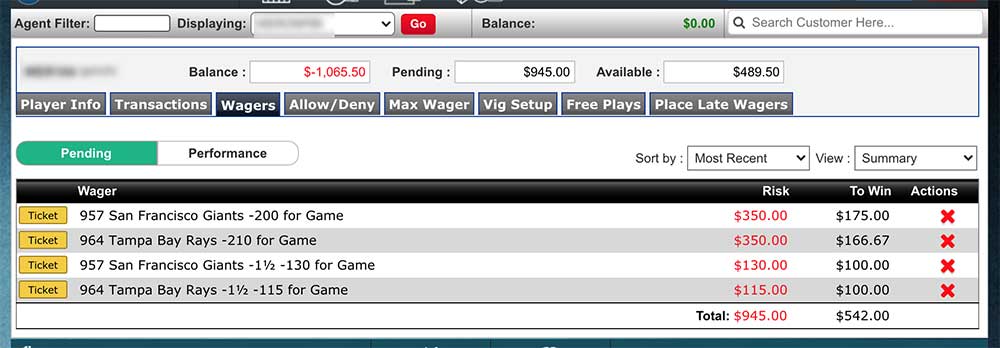
A list of all bets placed by the player clicked from within the game admin’s wager list window.
If the agent notices massive action on a given game, he may choose to apply stricter wager limits on such games. This is called a "circled game." Imposing stricter limits is the quickest way agents can limit their price per head service sportsbook’s exposure without affecting other games. From this window, it's also possible to disallow parlays, which include the selected game.
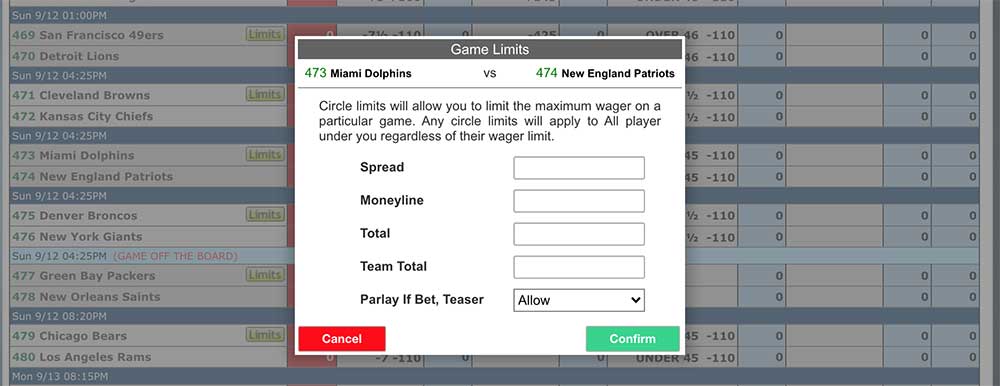
Using the “circle game” option you can quickly apply specific limits per game.
And of course, agents are also able to adjust the line. They can choose either to “hard shade” the line (move the line and don’t accept the main line’s movements), or “soft shade” (move the line and follow main line changes).
From this screen you can also remove the previous shade setting or remove the line altogether:

Simply enter the favorite’s line, the system will automatically calculate the comeback. Choose if you want to follow the main line’s changes after your adjustment (“soft shade”) or keep your line fixed regardless of future changes (“hard shade”). From this screen you can also hide the game’s line altogether.
You can also switch the game admin screen into the advanced mode. This mode allows you to move multiple lines at the same time, while showing the volume of action received on each game.

The "advanced" mode allows you to move multiple lines at the same time. Click the "save" button to apply the changes.

Once you apply the changes, the cells edited are indicated by the new orange color.
As you can see, PPHSportsbook.net’s Game admin screen is more than a simple “lines mover” tool, making it agents’ go-to screen if they like to monitor the exposure of their sportsbook and slightly adjust the lines as the action comes in.
Idsca’s line mover (“Line Entry” screen) is several steps above the majority of pay per head sportsbook providers. It fulfils its purpose rather well, allowing agents to edit multiple lines at once, soft or hard shading them or removing them completely.
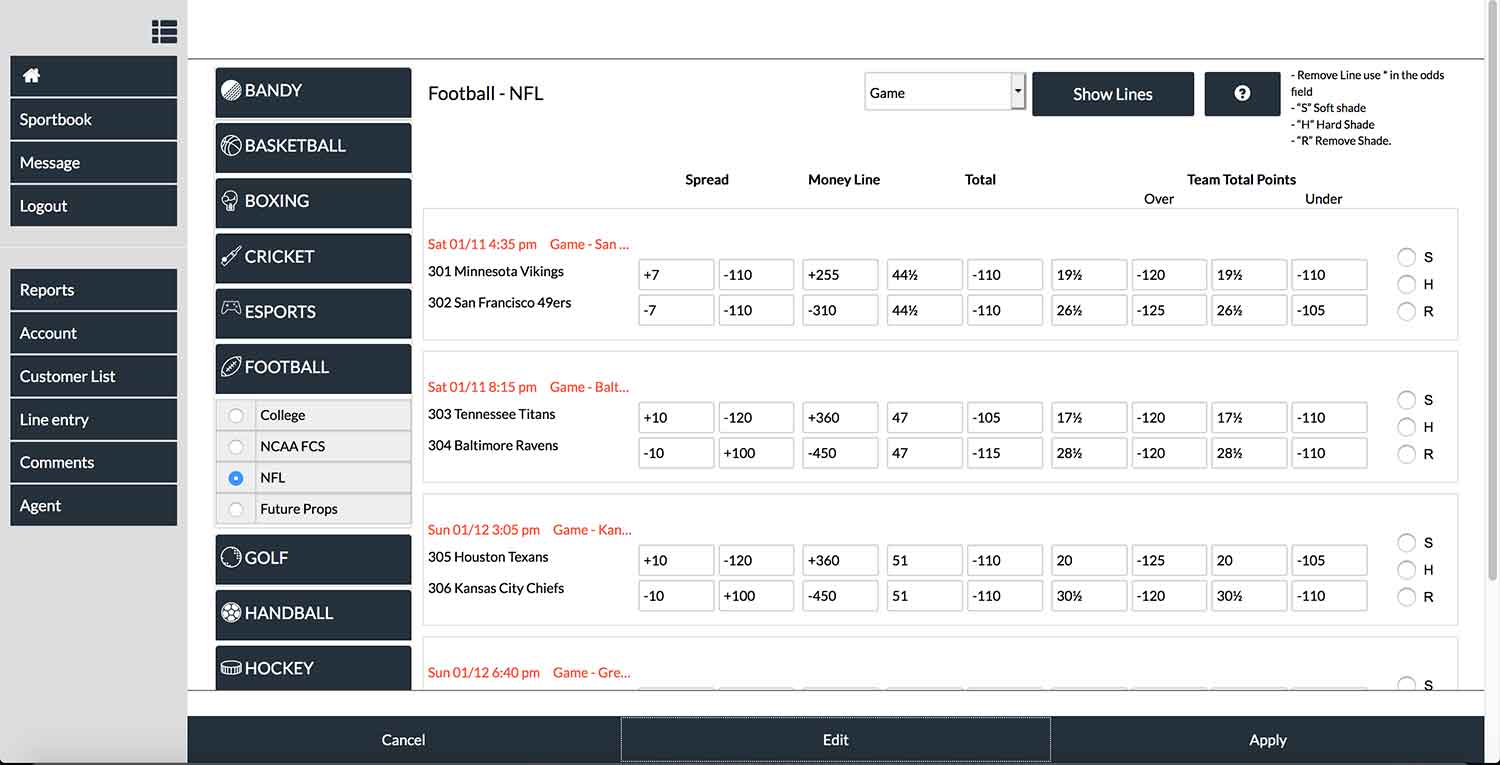
You will have no problems adjusting your game’s lines with IDSca.com pay per head sportsbook's lines mover tool.
Unfortunately, it suffers from some of the same issues as with the previous versions. It doesn’t allow agents to see the volume of bets (nor the risk or to-win) received on the particular games shown. For this, you agents need to open the “agent position” report (which only indicates risk amount, not to-win or amount of bets), and based on this, edit betting lines and odds.
Let’s consider the following example. An agent wants to offer odds on quarter periods (On NBA, for example, 1st, 2nd, 3rd and 4th quarters are available), but only at 40 cents line (-120). Quarters are usually at a 30 cents line by default (-115). One option would be to call the provider’s customer service and have them set it up for you. But what if you want to set it yourself right from within your pay per head sportsbook management backend, maybe set it up on a per-player basis, and experiment with your possibilities without having to contact the sportsbook agent sites provider everytime?
Another thing agents may want to do (and it’s highly recommended, especially if they are working with a smaller bankroll to cover player’s winnings) is to not offer action on games whose moneylines include heavy favorites. The reason for this is that players, especially those with a big bankroll, are willing to bet high on these favorites since the outcome it’s almost guaranteed (think of those NCAA college basketball games).
In these cases, the “max moneyline” option allows agents to configure their price per head sportsbook software so it automatically hides any moneyline that is higher than the threshold entered.
In this section of our reviews of the best pay per head sportsbook sites, we will discuss these two features and compare different providers in their implementation for this setting.
There doesn’t seem to be an option for the bookie to create these profiles, line types (vigorish / juice setup), and max moneylines by himself. So we are guessing these need to be requested to the Realbookies.com customer service.
Moreover, there was no option to change these profiles in bulk (selecting a group of players and assigning the limits profile to all of them). Again, you will need to request such a change to their customer support.
This online bookie service allows agents to choose from preset profiles with multiple line variations – from a 10 cent (-105) line and higher.
These preset profiles also allow for max moneylines setups. From 500 to 1000, we are sure you can request any juice and max moneyline combination and then assign it to each player or have the PPH Sportsbook’s office assign them to a group of players in bulk.
Unfortunately, it seems there is no option for the bookie to adjust the juice and max moneyline by himself manually. He will have to contact the office to have it done, which is not bad, but takes away the flexibility and control that some agents like to have in their pph bookie sportsbook.
Also, we could not identify a dedicated screen that allows agents to apply different juice and max moneylines to a group of players (instead of the one-by-one basis). Again, you will have to contact the pay per head website customer service.
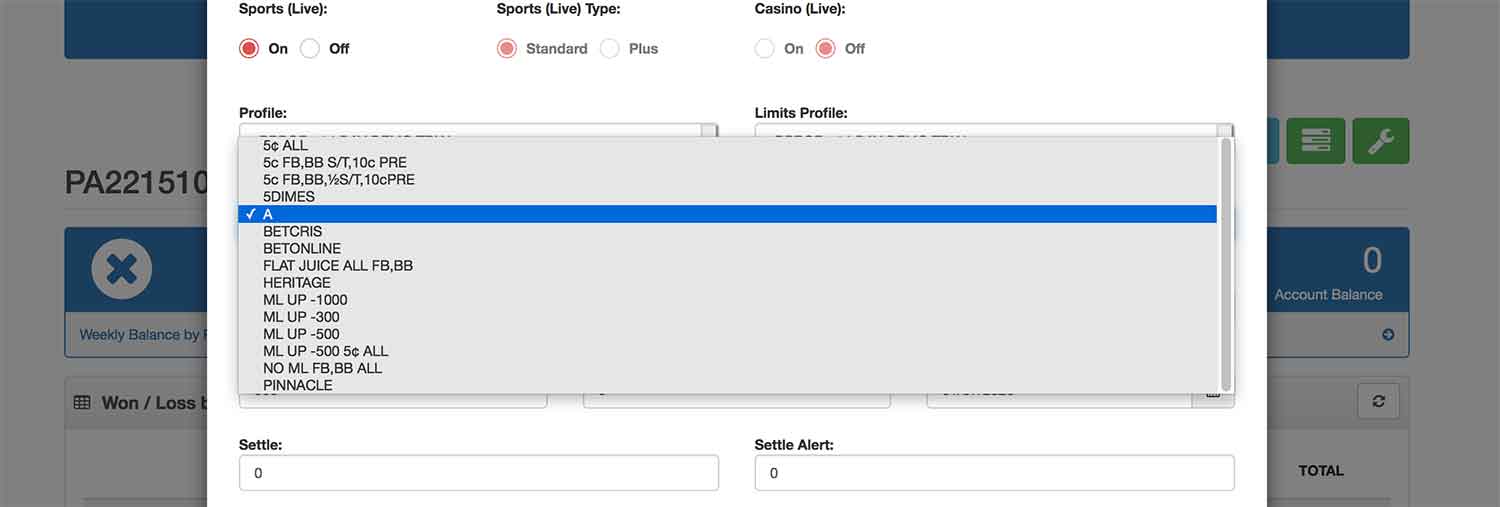
Bookies can call the payperhead.com office and request any juice/max moneyline combination. Changes will immediately take effect on their online bookie software agent backend.
Similar to payperhead.com, Realbookies allow you to choose from a preset assortment of juice and profiles.
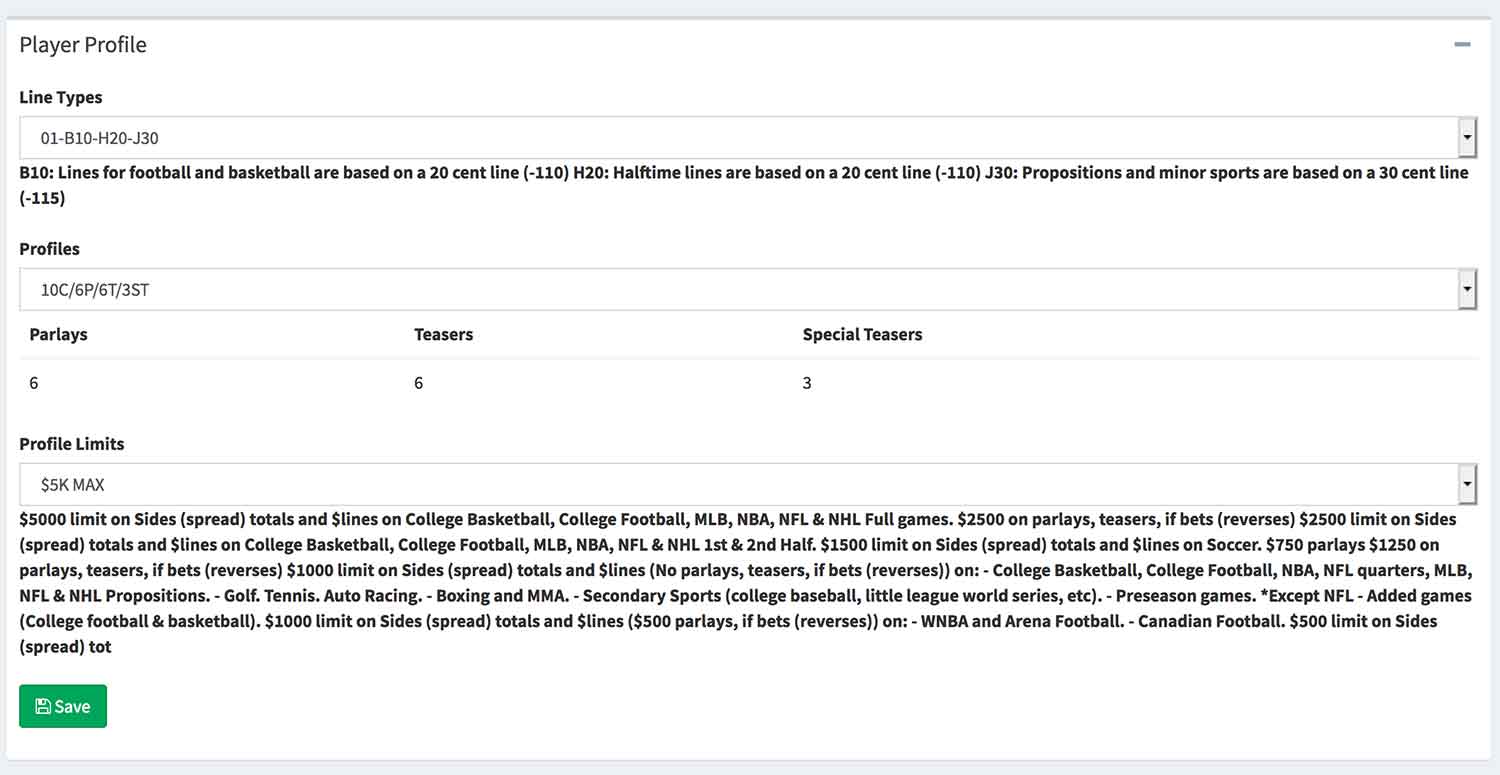
Choose from the preset list of juice and limit profiles. Additional configuration can be requested by calling the PPH Sportsbook directly.
There doesn’t seem to be an option for the bookie to create these profiles, line types (juice setup), and max moneylines by himself. So we are guessing these need to be requested from the Realbookies.com customer service.
Moreover, there was no option to change these profiles in bulk, which means selecting a group of players and assigning to all of them a given line or limits profile. Again, you will need to request such a change to their customer support.
Other than changing each game juice individually using their lines mover adjustment tool, this pay per head software provider doesn’t seem to offer an option to adjust the vigorish (juice) per entire sport or league/period. In other words, agents can only change it in a game-by-game basis.
As regards setting a max moneyline, this bookie website software has a nice little feature that takes care of that - even though there are some limitations with their current implementation.
The “Manage Max Moneylines” screen displays a table showing all sports:
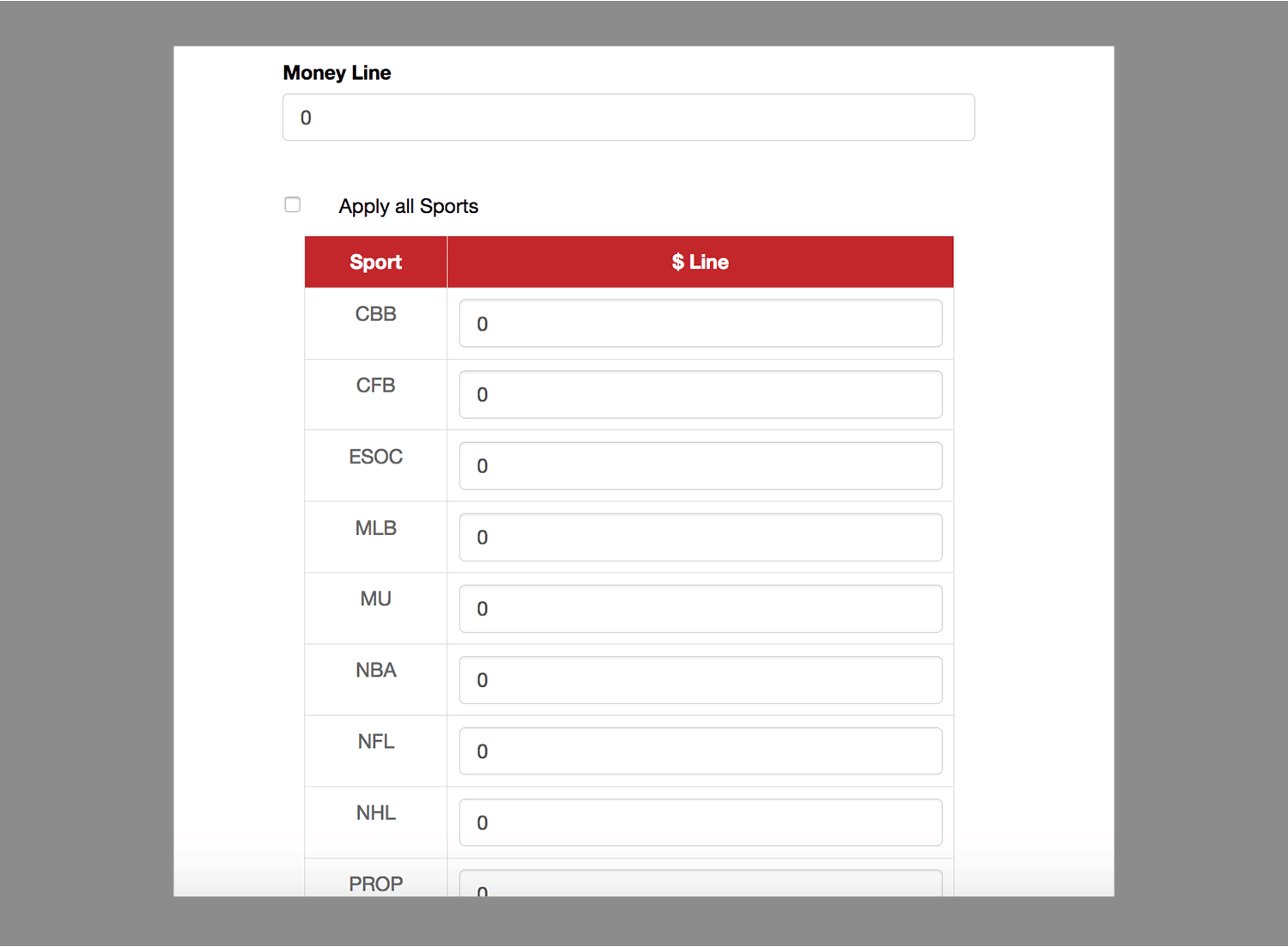
You will be able to set a max moneyline allowed per sport. Unfortunately, there is no way to be more specific as to which leagues or periods this will apply to.
The issue with this implementation is that it doesn’t allow the agent to choose a specific max moneyline to be offered on a per league or per period basis. For example, agents can set the max moneyline across all NFL, but not for NFL first halves, NFL game props, NFL alternate lines, etc. You get the idea. This may come up as a huge letdown since moneylines on game lines are higher than those for halves and quarters.
So, for example, say you want to set the max NFL moneyline on the game to -/+500 and -/+300 on halves and -/+300 on quarters. With the current implementation by Realpriceperhead.com, you would not be able to apply such a setup.
Nevertheless, having at least some variation of the max moneyline option online and available for agents is a plus, and we commend Realpriceperhead.com for it.
Similar to other providers, IDSca allows you to select from a predefined set of betting line types, each of them with their corresponding juice or vigorish.
We are guessing that, as with other providers, you can request any custom line by calling their customer support department.
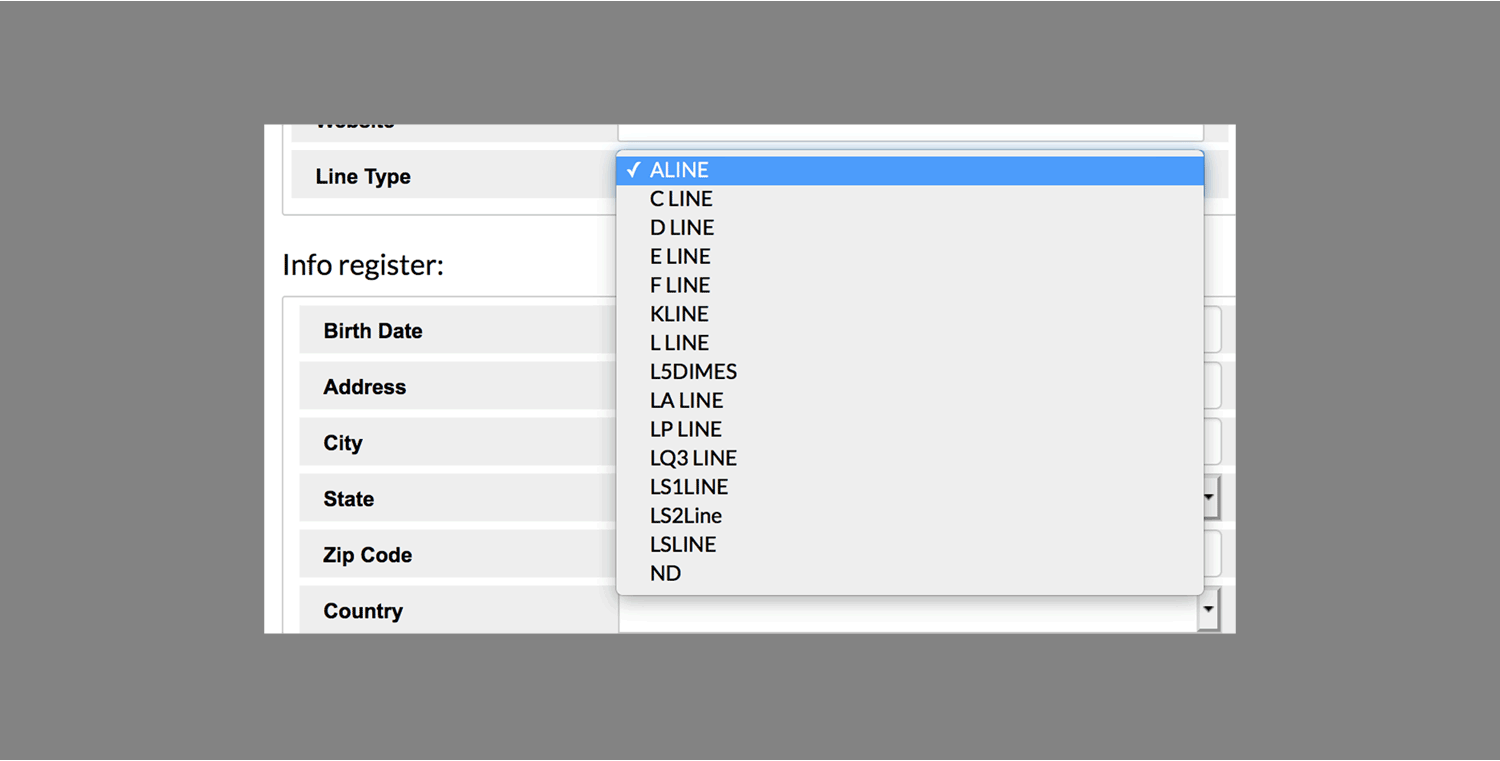
Even though IDSCA.com pay per head service doesn’t have a dedicated tool to configure juice and max betting moneylines, they provide a preset list of line types options. Additional line types can be requested by calling the provider directly.
PPHSportsbook.net has a dedicated screen to allow agents to not only change the juice per sport+league+bet_type (spread, totals, etc) combination but also to decide what the maximum betting moneyline you want to be available in your book.
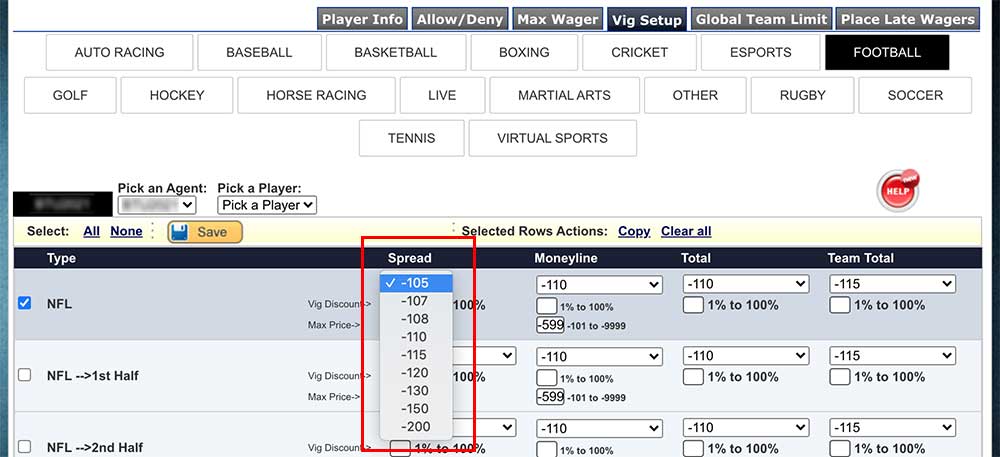
The juice on any sport, any period/league, and any bet type (spread, moneyline (comeback), total), can be customized using this pay per head service
Simply select a sport from the top menu. Identify the league/period for which you want to set the max moneyline. You can also use the copy/paste option to quickly apply the same configuration to multiple leagues or periods.
For example, let’s say you don’t want to allow moneylines over -400 on Martial Arts (UFC, Bellator, K1, etc.).

Before the setup, UFC 246’s Modaferri vs. Barber moneyline line is Barber’s -990.
Back on the “Vig Setup” tool, simply select “Martial Arts,” select the league or event (UFC 246 for this example), and set the max moneyline to -400. Click the “save” button.”

Setting a max moneyline of -400 will hide all moneylines higher than that number.
As a result, all moneylines higher than the entered amount will not be shown.

All lines with moneylines higher than -400 are now hidden.
Setting up the juice is very similar. You access the “vig setup” screen, select the sport, and identify the league/period you want to change juice for. (Optionally, you can use the copy/paste option to apply the same juice configuration for multiple leagues or periods).
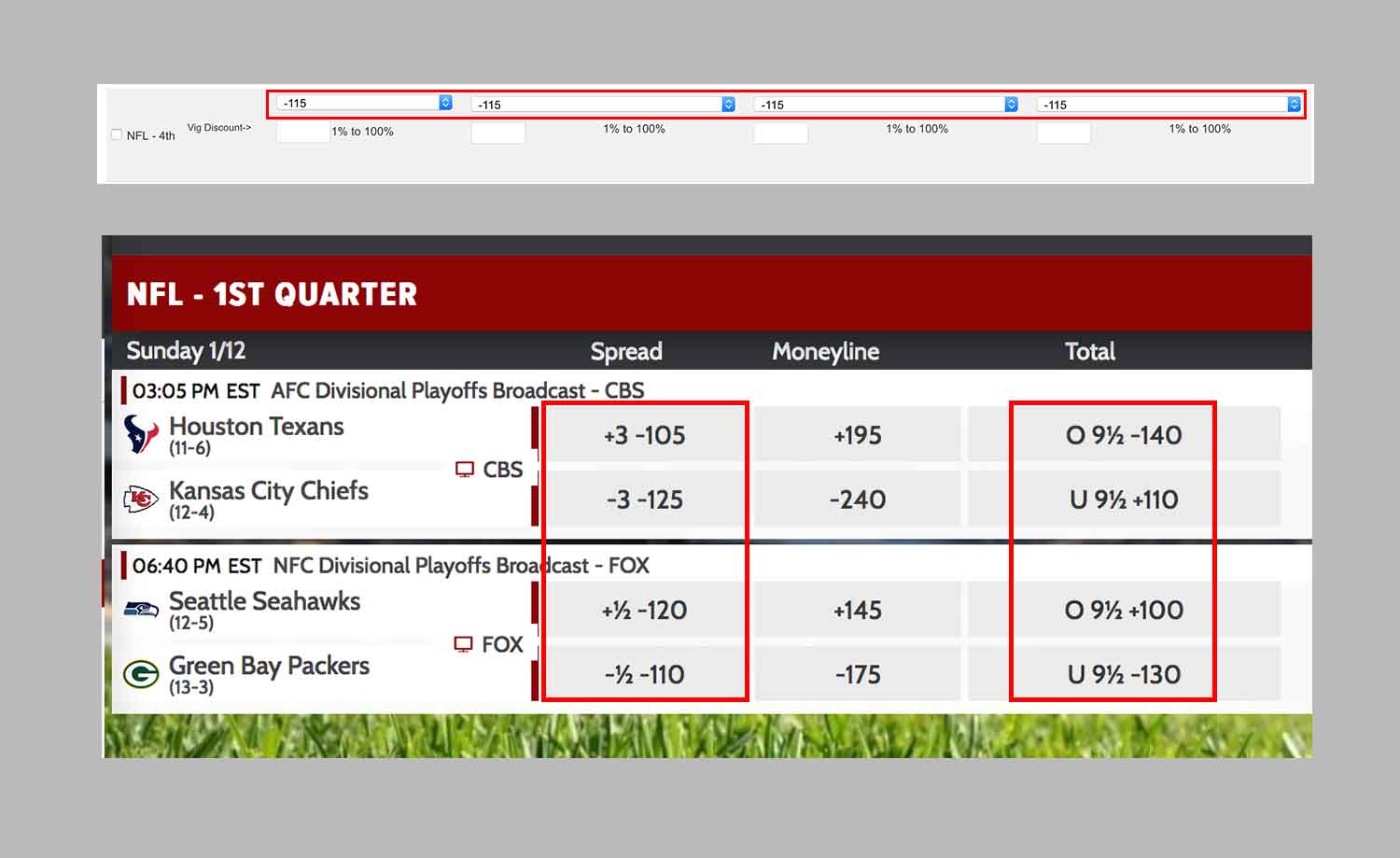
Offering a 30 cents juice (-115) is typical of quarters. You can make this even bigger (or smaller) with just a few clicks.
For agents, understanding their player performance is a must when trying to improve their business’ profit margins and maintain a profitable price per head bookie sportsbook. Identifying the best and worst players can provide agents the information they need to apply the adjustments necessary to increase the bottom line.
Different PPH Sportsbook providers offer different levels of reporting. Agents, at least, would want to know the top and worst players by hold percentage (Total amount risked by player related to the amount kept by the agent)
But going deeper than that does pay off. Some bookie agents stick to taking action from players who continuously maintain a negative weekly balance. But that may be shooting themselves in the foot because you will soon realize players will stop referring to other players if they continue to get cut after a few weeks of positive figures.
Instead, identifying in which sports, periods, wager types (straights, parlays, teasers, etc.) and bet types (spread, total, moneyline) players are the most and least profitable and applying slight adjustments to your setup (e.g., max moneylines, juice setup, early lines limits, max parlay payout, parlay odds, etc.) can be just what’s necessary to turn a player’s “luck” around.
In the current section of these reviews of the best pay per head bookie sportsbook services out there, we will discuss how the different bookie software programs providers measure up when it comes to their sportsbook and player reporting capabilities available to the bookie agents.
Aceperhead has some useful reports that allow agents to dig deeper into players' activity and patterns. This pay per head bookie service’s "Player Analysis" report enables agents to quickly identify in which sports, periods, or wager types players are the most profitable. With this information, they can decide to take action and apply changes such as increasing the juice or tidying up the limits on certain betting markets.
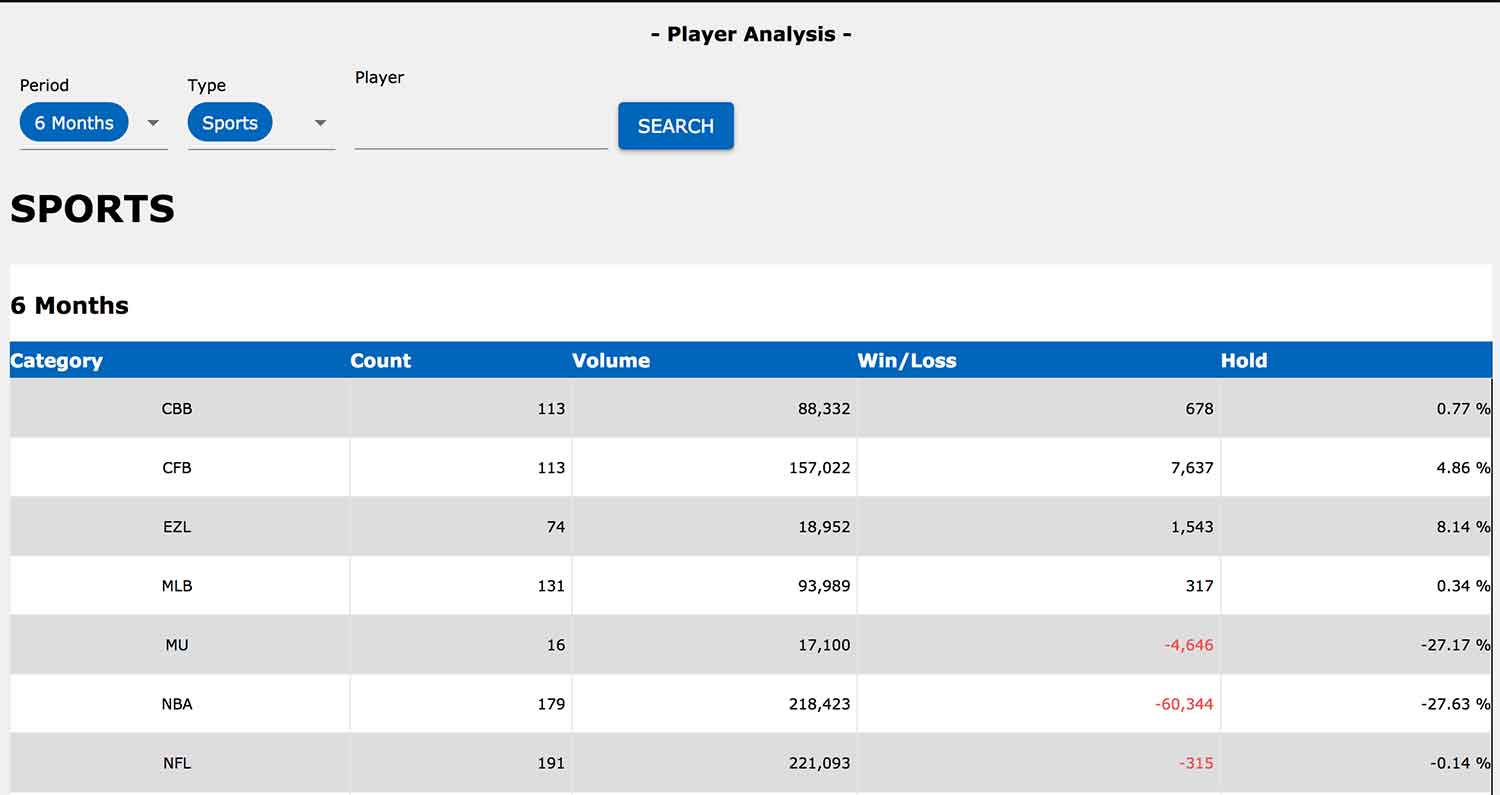
The “Player Analysis” report available i Aceperhead.com's pay per head service breaks down the win/loss amount per sport, period and or wager type, showing the agent’s final hold percentage.
Furthermore, the “Player Totals” report allows agents to view the performance of any player by a given date range.
The volume (quantity) of bets, total win, lose, Net (win-lose), and current balance will be displayed for all players listed.

The Player Totals report is a great starting point for further analysis.
The only downside with this report is that it doesn’t break down the numbers by bet type (spread, moneyline, total, etc.). It would have been useful to be able to say: “Okay, PlayerX plays a lot of spreads and totals, he is pretty good at spreads and horrible at totals, so let me increase his juice on spreads so when he loses, he loses more, and when he wins, he wins less amount (since the juice is higher he needs to pay higher to bet). Unfortunately, the current report doesn’t Aceperhead “Player Analysis” report setup does not provide the possibility to research at the bet-type level.
Nevertheless, the Player Totals report is still a great resource to get a bird's eye view of your best and worst players and later take this newly gained knowledge and research individual player, using the “Player Analysis” report to identify in which sports, periods and wager types (straights, parlays, teasers, etc.) the player performs the best (and worst).
Payperhead.com various performance reports allow the bookie to see his book’s numbers by time (day/week/month/ year), agent or player and see the total volume (number of wagers). Additionally, some of these reports breakdown the win/lose by business unit (sports, casino, horses, etc.).
Unfortunately the level of depth is not what we would’ve hoped to see. For example, the “Betting Statistics” report shows volume (amount of bets) per wager type (straight, parlay, teaser, etc.), but there is no way to see the win/lose ratio for these same wager type areas. In other words, with this report, you can answer the question of “which player plays more parlays?” But you cannot answer the question: “which is the worst parlay player and for how much?”
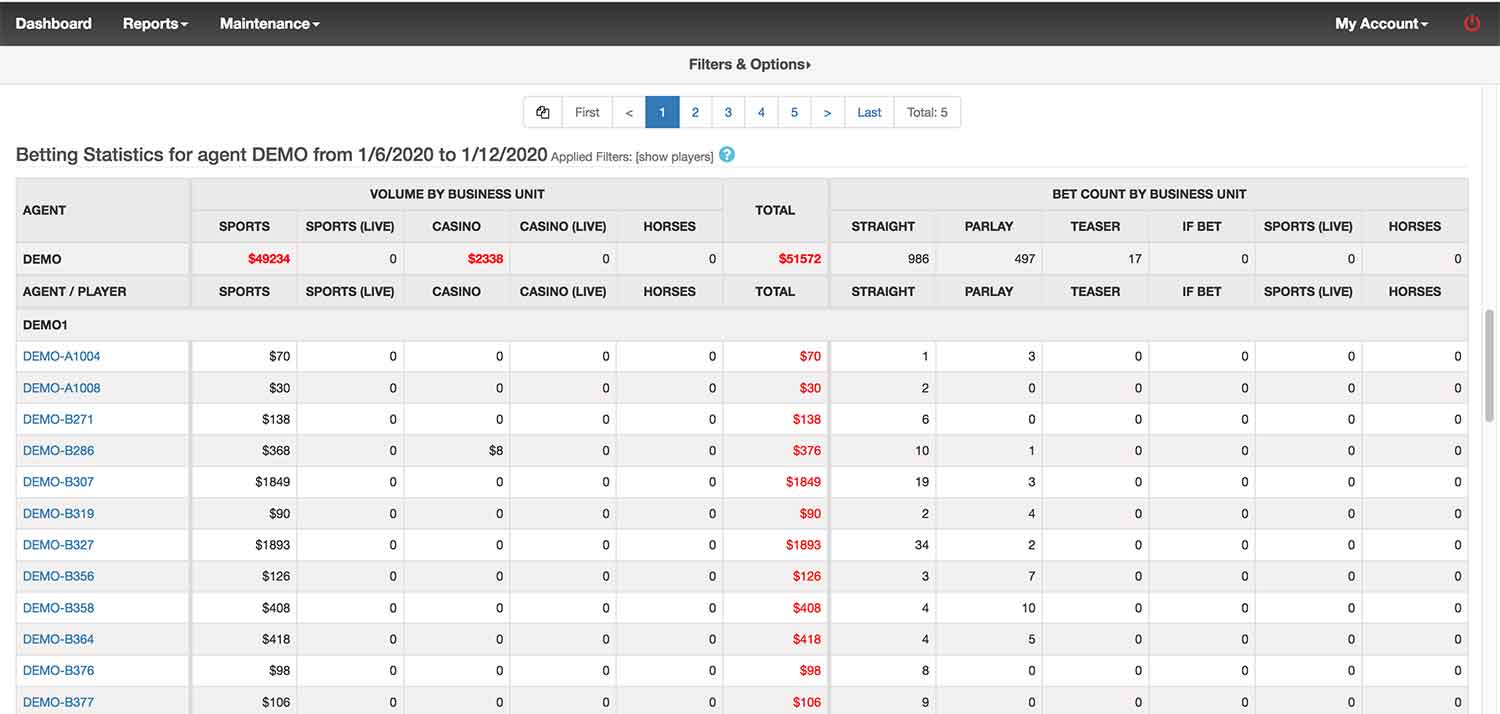
Payperhead.com's online bookie service gives agents access to the Betting Statistics report. It shows a breakdown volume of each player performance by business unit and wager type.
Another promising report is the “Summary & Lifetime” report. This shows the win/loss by “business unit” (sports, casino, horses, etc.). This is a helpful report to understand the overall book’s performance in these areas. Unfortunately, it doesn’t answer the question, “which sports/periods/ leagues, etc., are the most and least profitable ones.” Again, the lack of depth is a setback. We couldn’t find such a report within the Demo account accessed.
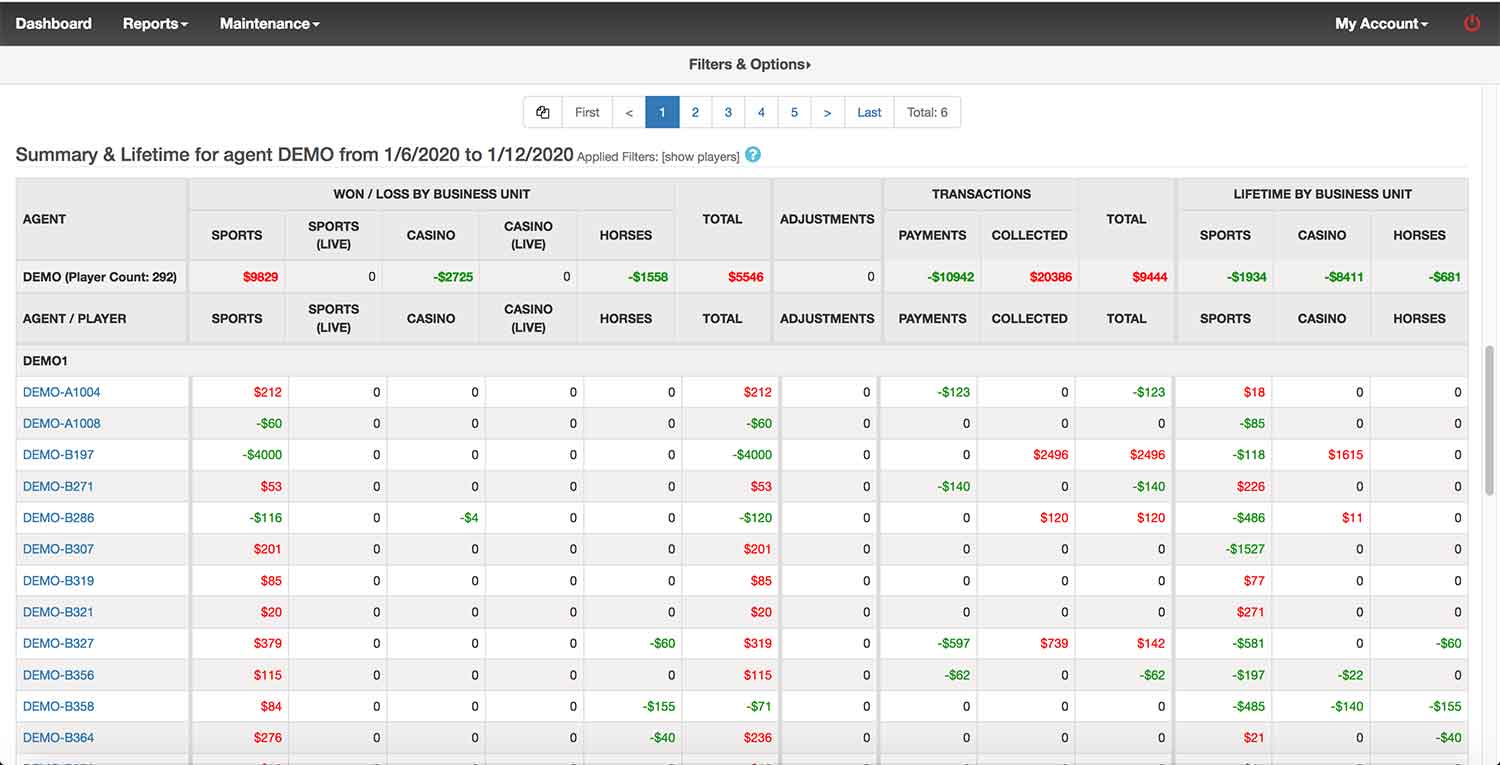
Even though knowing the win/loss per business unit is useful, that’s only a small step in the right direction. We want to break down sports data into smaller categories, such as per-sport, periods, leagues, wager types (straight, parlay, etc.) and bet types (spread, moneyline, etc.).
As far as our research goes, there is no way to find out which leagues and periods (NFL 1st half, NBA Game props, etc.), wager types, and bet types (spread, moneyline, total, etc.) tend to make the agent the most and least money.
This pay per head service provider also offers a “Player analysis” report. It functions similarly to Aceperhead’s player analysis report (these two providers utilize the same DGS framework, after all. Therefore, they share some of the same strengths and weaknesses when it comes to this report).
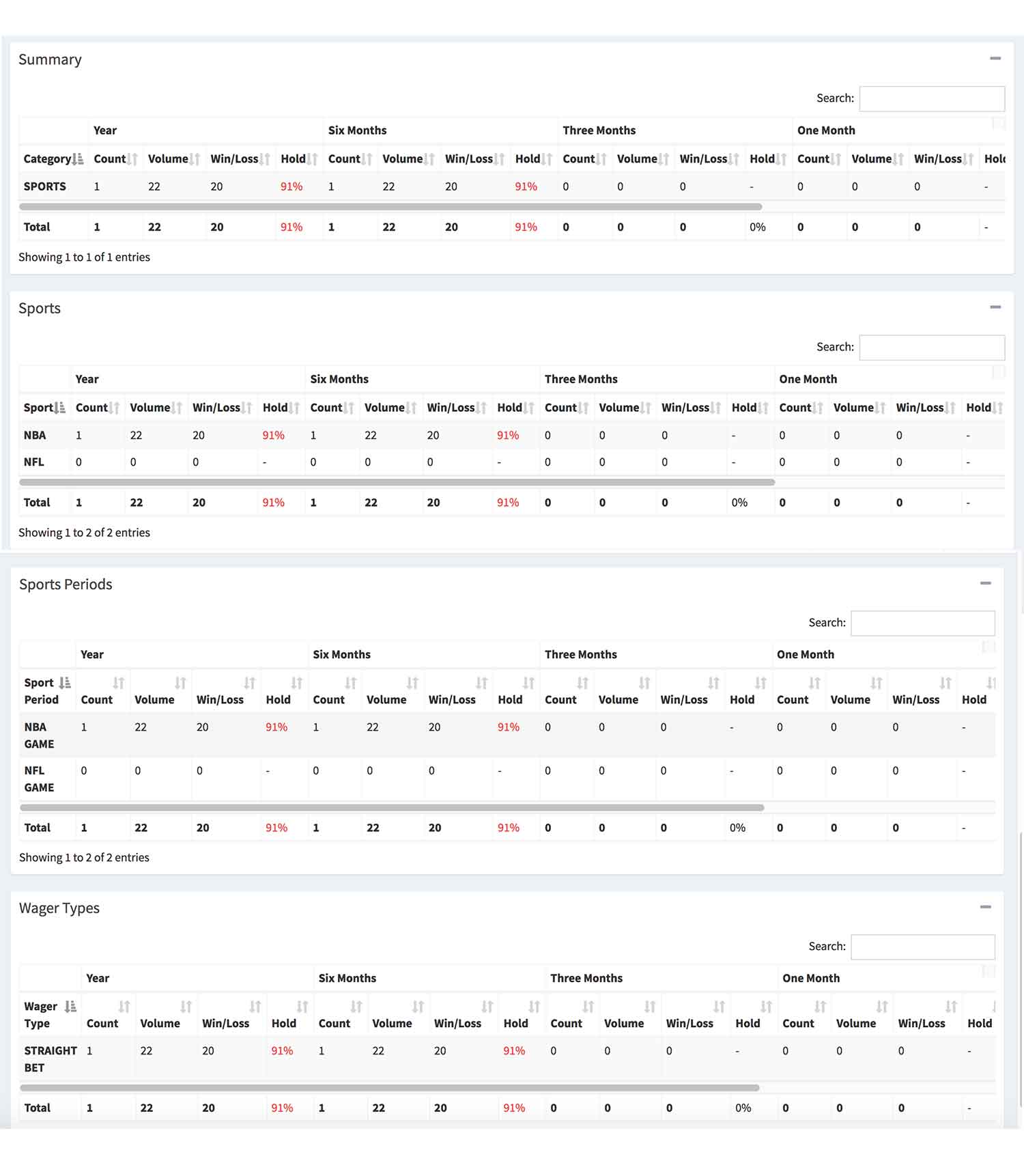
A nice breakdown per sport, league, periods and wager types is displayed using Realbookie.com’s player analysis report. Unfortunately there is no way to filter wager type performance per sport or league.
As mentioned earlier, with this report, you can select a player and view the breakdown of his performance by sport, period, and wager type. The limitation of this report is twofold:

There is no breakdown by sport (much less by period) on the “wager types” table, nor is there any way to filter the report by sport or period.
This pay per head sites provider offers the “hold percentage” report. It is an excellent starting point on your research, since it shows, by “sport”+ “wager type” combination, the win/loss amount. Unfortunately, a major setback with this report is that it doesn’t allow the agent to filter by player. You will be able to identify how your overall book is going on, say, NBA straight bets, but not how “PlayerX” is doing on the betting market.
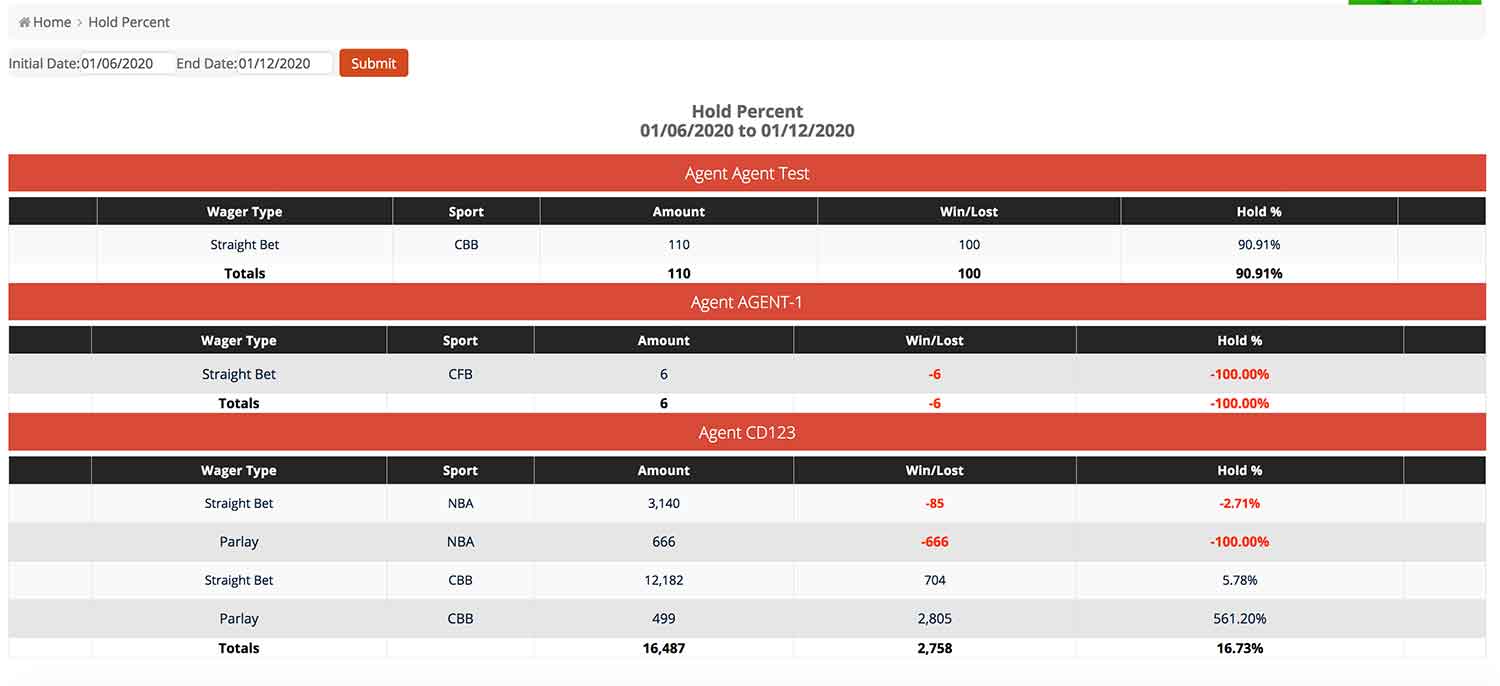
Realpriceperhead's sports bookie software provides the “Hold Percentage” report. This report is a good starting point to understand your sportsbook’s performance.
We were not able to identify any report within this sports bookie software demo account that breaks down player activity by sport + period. So it will not be possible for bookies to find out the performance of their players by period or league (only by sport).
Another useful report available is the “action by player” report. This breaks down the player win/loss amount by wager type (straight, parlay, teaser, reverse, as well as casino and horses). It’s a pretty neat report to quickly identify how each player performs in each of these categories. If a player is too good at parlays, you can, for example, request the parlay payouts to be decreased (e.g., Instead of a 2 team parlay paying the default of 2.6, you can make this, for example 2.1).
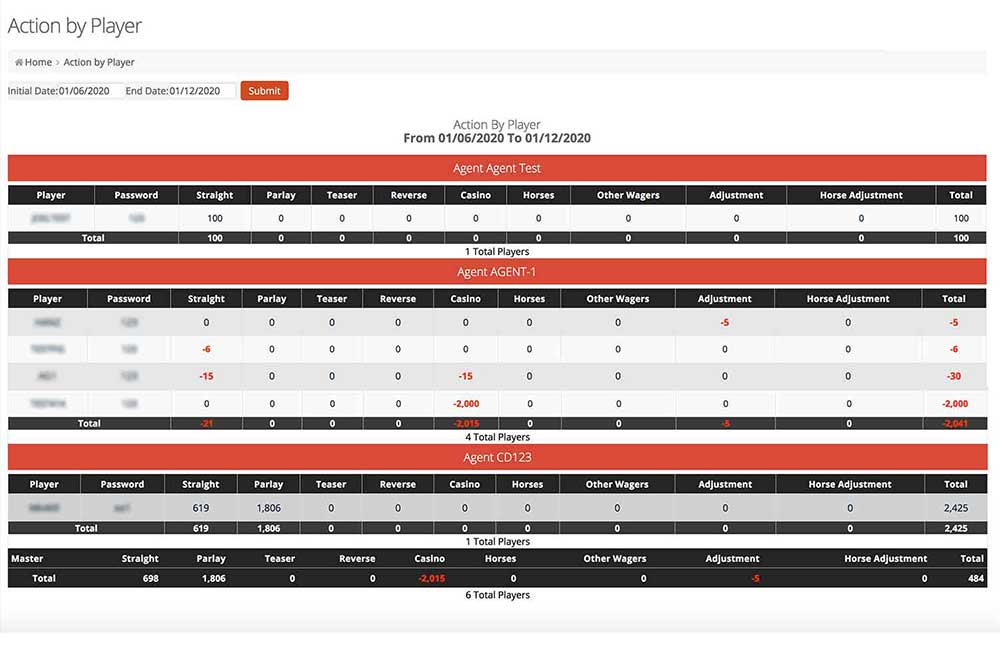
The “action by player” report breaks down player win/loss by wager type (straight, parlay, teaser, reverse, etc).
The problem with this report is that it shows the wager types in aggregates. In other words, you are not able to see the sports (much less periods or bet types (spread/moneyline/totals, etc)) these numbers correspond to. Therefore, this report is useful to see how a given player is doing on spreads, parlays, etc., but not to see which sports, leagues, or bet types these numbers correspond to.
Unfortunately, IDSca.com finds itself lacking a little bit when it comes to player analysis/performance reports. The only report we identified which provides player-level data was the previously discussed “action by player” report.
This report is identical to that previously discussed in the realpriceperhead.com section. For each player, it breaks down his action by wager type (straight, parlay, teaser, etc.), and also his total (all wager types aggregated).
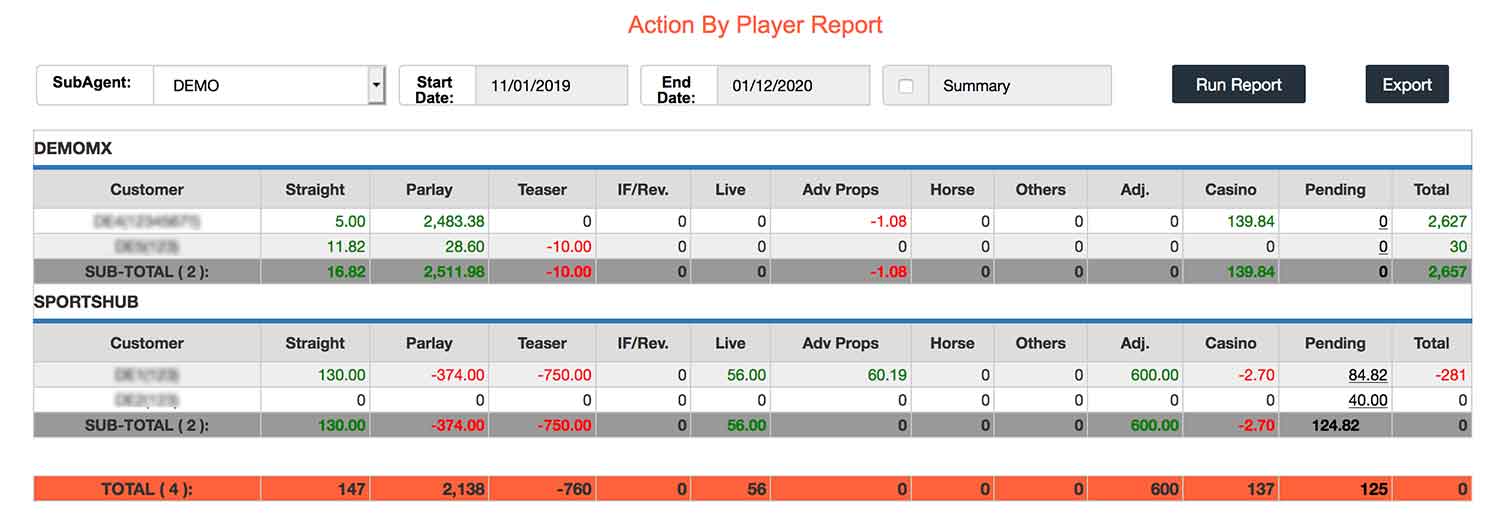
The action by player report breaks down your players’ activity by wager type. Unfortunately there is no way to further break down this activity by sport, period or bet type (spread, moneyline, totals, etc).
It’s useful because it allows you to answer the question “in what wager type is X player more (and least) profitable, but there is no way to further breakdown these figures by sport, period or league, and bet type. The main reason why this is a setback is that besides making adjustments by wager type (straight, parlays, teasers, etc.), there is also a wide selection of changes you can make on a per-sport, per-league (or period) and per-bet type (spread, moneyline, etc.). You will leave all these possibilities out if you only focus on a per-wager type dimension.
When it comes to analyzing the pay per head sportsbook and players' performance, the best way to get started is at the “Customer Performance” report level.
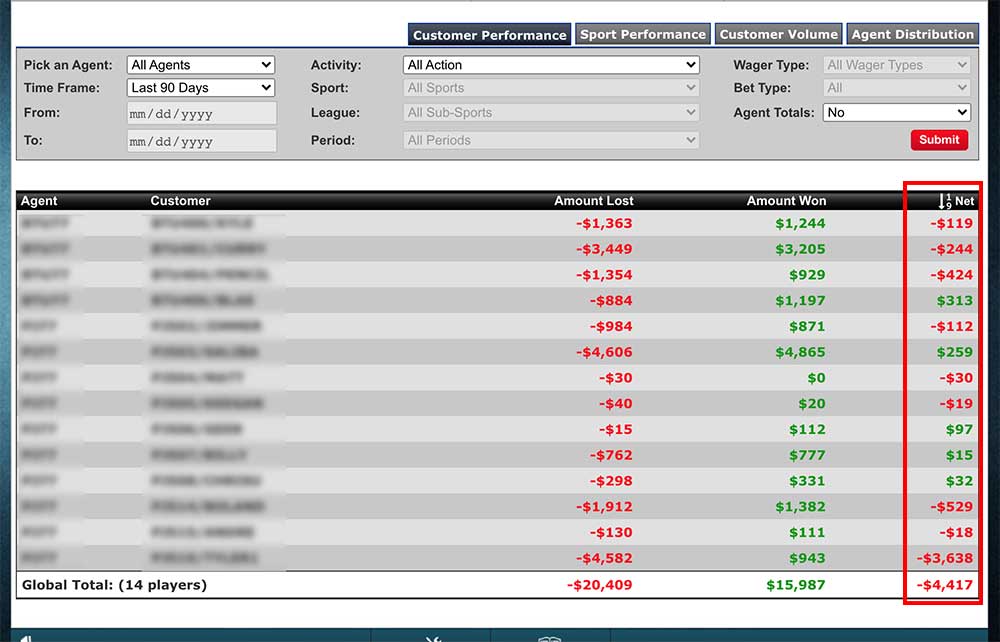
The “customer performance” report is the best entry-point in the analysis of your players. You can easily spot top and worst performers.
With this report, you can easily see which players are performing well or poorly. A red “net” means that they are negative, meaning they are losing more than what they are winning. A green number means they have a net positive, meaning winning more than they are losing.
After you identify this information, then you can plug each of these players, (or as a group) into the “Sports Performance” report to really understand in which sports, leagues/periods, wager types, and bet types they are over and underperforming.
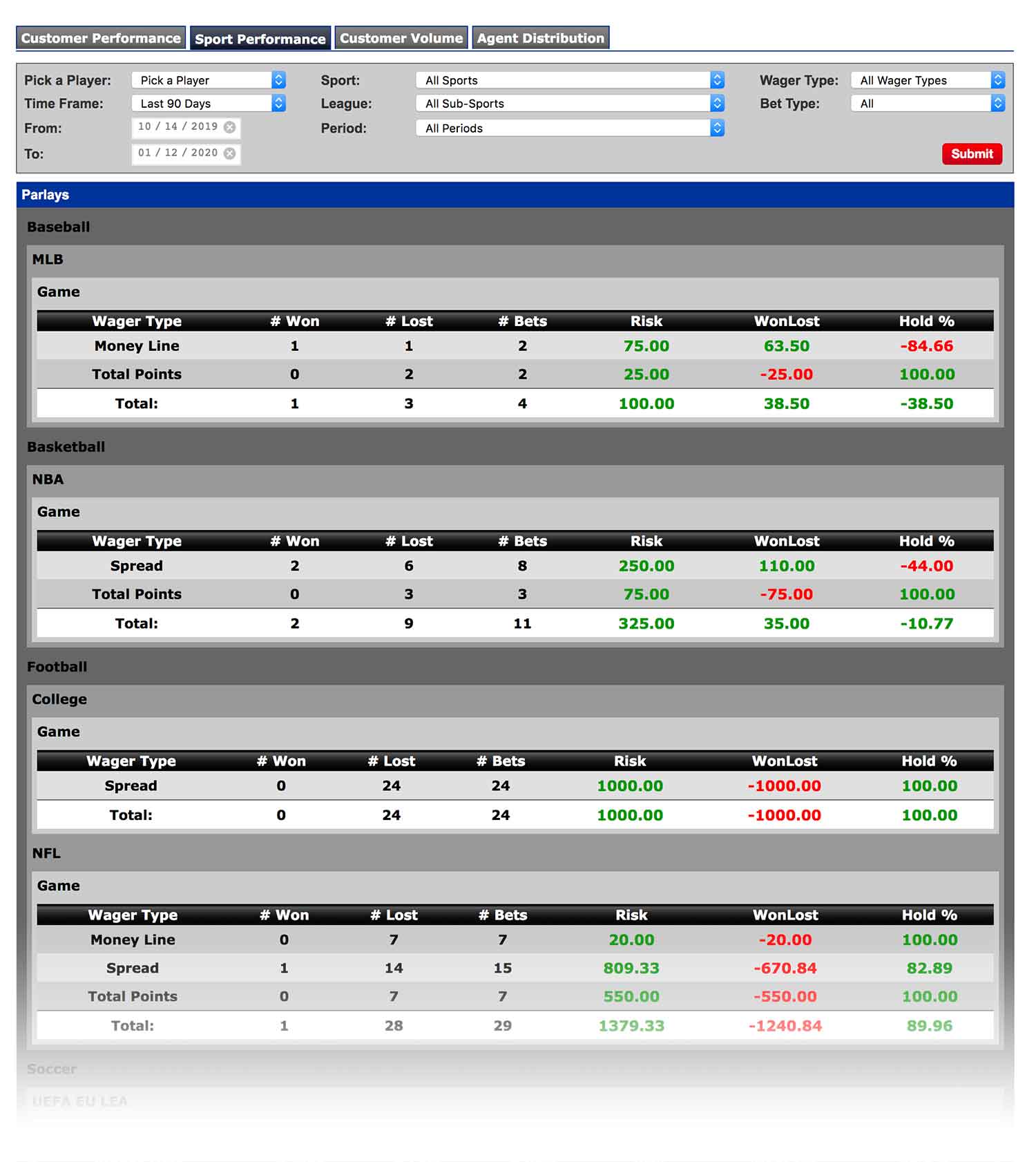
The sports performance report shows an in-depth breakdown that includes, either by player or group of players (agents): sport, league or period, wager type (straight, parlay, teaser, etc), and bet type (spread, moneyline, etc).
Generally, there are two ways to use this report:
As you can see, an excellent breakdown by wager type (straight, parlay, teaser, etc.), Sport (Football, Basketball, Baseball, etc.), League (NFL, NBA, Italy Cup, etc.), Period (Game, 1st half, etc.), and bet type (spread, moneyline, total points, etc.), is shown.
It’s advisable to not base your decision for pay per head service provider solely on price. Available tools, customer service, user experience, and performance are all critical in this business. Nevertheless, pricing is also a key factor to consider when making your final decision.
We have left this pricing section to the end of these reviews of the best pay per head sportsbook sites because of this reason. At this point, you should know how the different Pay-per-head (PPH) sportsbook providers differ from one another in terms of features. So now it’s a great time to put the final nail in the coffin: Pricing.
This pricing section focuses on the cost for the base PPH Sportsbook + (Digital) Casino + Horsebook. The dynamic live betting feature is indeed a highly sought-after add-on, but not all players will likely be using it, nor all agents like to offer it, therefore we have left it out.
Most online bookie software providers charge a rate of +$5 for the dynamic live betting service, so in most cases, you only need to add this rate to the prices listed in this section.
*Please consider that this section is based on the pricing each provider has listed on their respective websites. Depending on the number of players you handle, it may be possible to get a few dollars subtracted from this rate. So we recommend you always call the provider and ask them directly.
This PPH Sportsbook provider starts with $10 per active player. Phone wagering is also included at no additional cost.
Payperhead.com starts with $11 per player. This includes online access only. They also offer a $13 rate which covers phone wagering and dynamic live. But we are not sure if paying a higher fee for something not all of your players will be using is a good idea.
Realbookie.com offers a rate of $10 (all customizations and leagues included). This rate only includes online access. Access to phone wagering will cost you an additional +$5 per player.
Realpriceperhead.com starts with a $7 per head rate. Phone and online wagering are included at no extra cost.
This price per head service provider offers their classic interface at $10 per head or their modern (seen in this article) interface for $15. Phone and online access are included.
At PPHSportsbook.net, you can get started for $9 per head. You can enjoy the most feature-rich PPH sportsbook backend management software, the most insightful player and sportsbook reports, a fast and knowledgeable customer service, and a modern state-of-the-art front end sportsbook for your players.
We hope you found the content written on the page useful. In these reviews of the best pay per head bookie sportsbook service, we worked hard to put together a truthful, unbiased comparison of the factors we consider most crucial when running a private sportsbook.
Based on powerful tools (juice setup, max moneylines, lines adjustment, and many more), a modern sportsbook front-end interface that your players find themselves comfortable with and it’s easy to navigate, insightful agent backend performance reports, and a fair and competitive pricing, we consider PPHSportsbook.net a great option.
If you are interested in getting started, simply request a free demo account today.
Have you recently started a local bookie sportsbook or you’re thinking about starting one? You may have wondered
These questions and more will be answered in this article. We will also explore some tools on your PPH website that can help you track your player’s wagers and keep you under your bankroll.
One of the most important aspects of sportsbooks for the local bookie to master is sports betting bankroll management.
In addition to learning how bookies make money, it pays to know how local online bookies manage their sportsbook’s betting bankroll management.
(If you're just getting started in the pay per head sportsbook business, check out our all-inclusive review article on the best pay per head providers. We've gone into serious detail, comparing the key features offered by the best price per head providers in the industry. This article's got cool visuals, head-to-head comparisons, and in-depth explanations that really show off what makes these providers special. Dive into the diverse reports they offer and get some sweet insights into your player base – this resource will give you all the valuable knowledge about the pay-per-head bookie industry. Happy reading, and may your bets be ever in your favor!)
 From the customer admin screen you can set the your players’ “weekly credit limit” and “wager limit”
From the customer admin screen you can set the your players’ “weekly credit limit” and “wager limit”
Your bankroll management sports betting is liquid funds that are available for you to pay your players when they win. Just as players keep a close eye on their gambling units or gambling bankroll, so should you keep a close eye on your sportsbook bankroll.
This should be separate from your anticipated cash flow for the week in case a player doesn’t pay on time. It’s important on your way on how to become a bookie online to have a bankroll large enough to cover any bets that your player will make in your bookie shop.
It’s also important to keep in mind when running a sports book that your bankroll must be separate from your personal checking or savings accounts. This is not money that you pay your bills with or an emergency fund that you need to access if your car breaks down. Think of your bankroll as gambling money or an investment in your way on how to be a successful bookie business owner. Never gamble or invest money unless you’re willing to lose it all.
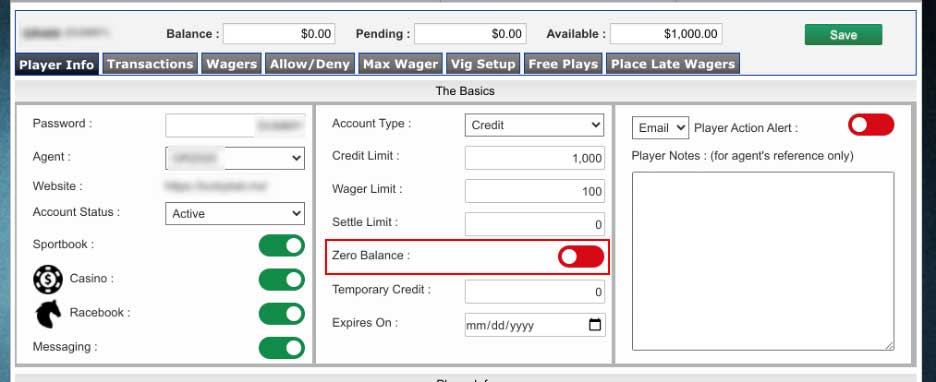
Clicking on any player account from your pay per head sportsbook control panel, you can access additional limits. Under the “basics” section, the “settle limit” indicates the maximum amount the player can win or lose before you either collect or pay him out. This is another way you can keep control of your book’s exposure.
A common question when you assess the best approaches on how to run a bookie operation is figuring out how much money you need to get started.
Your bankroll size depends on several factors. How many players you have and how much they wager are the two most important factors. Let’s say you have 20 players and their weekly limit is $1000, you should have a bankroll of at least $10,000 on hand. This is because you know not everyone is going to be winners at the same time or will owe the bookie money; but you are covered in case several players go on winning streaks.
One key reason bookies are successful is by “word of mouth”. Meaning, if you pay on time to your players they will refer your services to other players. Because of this you don’t want to be one of those bookies whose players say “bookie owes me money”.
Understanding your players is also a key to having the right-sized bankroll. If your players are small rollers, meaning that they don’t usually bet more than $100 on games, you can get away with a smaller bankroll. But if you have a high roller who is continually maxing out his daily and weekly max, you need to maintain a higher bankroll in case he has an unusually good week at your bookie shop.
Setting casino limits is yet another way to control your exposure and keep your bankroll in check. The limits available for this are:
On your way to becoming a bookie keep in mind that your sportsbook bankroll it’s scalable. This means that if you’re just starting out and you only have a few players, your bankroll can be just a few hundred or a few thousand dollars. As you gain more and more players and the amount that they are wagering grows, your bankroll needs to grow as well. The bookie software infrastructure allows you to keep track of all limits and tickets.
Weekly limits are also a great way to ensure you don’t go over your bankroll. You can set your weekly limits to whatever number you like to ensure that you can cover your players’ winnings. As your sportsbook grows you will become more comfortable with the weekly cash flow and can increase your limits accordingly. This is normal in the process on how to be a bookmaker.
Layoff accounts are one of those bookie tips that will save you a lot of money, but you should use it with caution.
It’s important for local bookies to understand what a layoff account or layoff bet is, and it’s even more important to understand how and when to use it. A layoff bet is simply a bet that bookies make to hedge against their potential losses. The best way to understand this is by example. Let’s say that the Chiefs are playing the 49ers and the Chiefs are favored -7. Your sportsbook is getting a lot of action on the Chiefs to cover the spread. If you’re concerned about your bankroll being able to cover those winnings, you can place a layoff bet (on an online sportsbook, your “Layoff Account”) for the Chiefs to cover the spread, the same bet as your players. From here, two things can happen:
Layoff bets and layoff accounts are important when figuring out how to be a sports bookie online that is not only successful but one that maximizes his profits. Keep in mind though, the use of layoff bets will severely limit your ability to make a profit on your sportsbook. The reason is that a sportsbook is a gamble, for the player AND for the bookie. Statistics show that, in the long run, players lose more than they win, which is why casinos and sportsbooks almost always make money. But when you use a layoff bet, you are reducing or eliminating the risk that you’re taking, but you also reduce your ability to turn a profit.
A common error novice many make when figuring out how to start a bookie business is to expect to keep a balanced sportsbook.
A bookie that keeps his sportsbook balanced means that you take equal bets on either side of a game or event so that whatever the outcome, you have an equal amount of winners and losers. This almost never happens. Most games have a side that is clearly favored, and the betting line will reflect that. Just as we talked about in the last section, you need to take risks as a bookie in order to make money. Unbalanced sportsbooks are the potential for large gains for you.
Pay Per Head websites have a plethora of tools for bookies to monitor their players and the action thanks to the sportsbook software. There are a few of this that you must use on your way on how to become a sports bookie.One of the best tools for staying on top of wagers as they happen is the Wager Alerts tool. This feature sends you an email every time that player places a wager. This is a great management tool if you are just starting out with a few players, or also if you have a few high roller players you’d like to keep close tabs on.
The wager alert feature sends you an email or telegram message everytime a given player places a ticket. To set this up simply click the “settings” option located on your main menu, then click the “wager alert” button and follow the instructions there.
Another tool that makes bookies’ lives easier is the Bet Ticker Tool. This gives you a continuously updated list of all wagers placed on your sportsbook. Within the price per head bookie software control panel, click the “bet ticker” option. With the click of a button, it sorts the wagers by dollar amount and highlights them different colors based on the amount. It even plays a different sound when each category of wager is placed. These features make it simple to monitor the wagers on your sportsbook in real time.
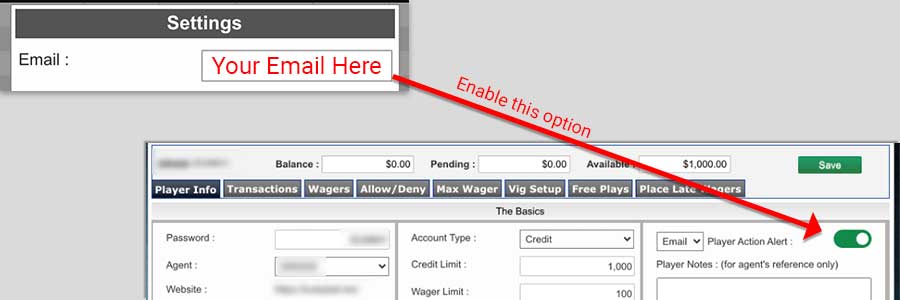
The bet ticket opens on its own browser window, you can configure different color indicators per wager amount, and filter in to only a given types of wager types. It’s the perfect tool to open in a secondary screen monitor.
Bankroll bookie management may be the most important aspect of your sportsbook for a local bookie using pay per head sportsbook software.
Understanding how large a bankroll you need, and how to ensure your payouts don’t exceed your bankroll is key to a successful sportsbook.
We talked about how much money you will need to start, and about how your sports betting bankroll is scalable to the number of players you have and how this is similar to how players keep a close eye on their units betting systems. We also discussed layoff accounts and layoff bets, and how they can help you balance your book, but also how it’s unreasonable to expect your book to always be balanced. Finally, we discussed several tools available to you on your PPH website that allow you to monitor your players and their wagers to ensure you never go over your bankroll.Remember, you can start off with small weekly limits if you have a small bankroll to begin with. As you get more comfortable with the process, you can always increase the weekly limit. With your new understanding of bankroll management, now is the time to request a demo account. With a demo account, you can explore the pay per head sportsbook and use some of the tools that we talked about here. Head on over to PPHSportsbook.net to request your demo account today and put your new knowledge to the test.
Making the most of your sportsbook means having the right team and the right tools, to make as much profit as possible. Our offering gives you all these plus an amazing customer service team that is able to dig into any player you request, offer adjustments on their limits, lines offerings, juice setups, etc. Read our extended guide that compares the most sough-after features among the best pay per head sportsbooks providers.